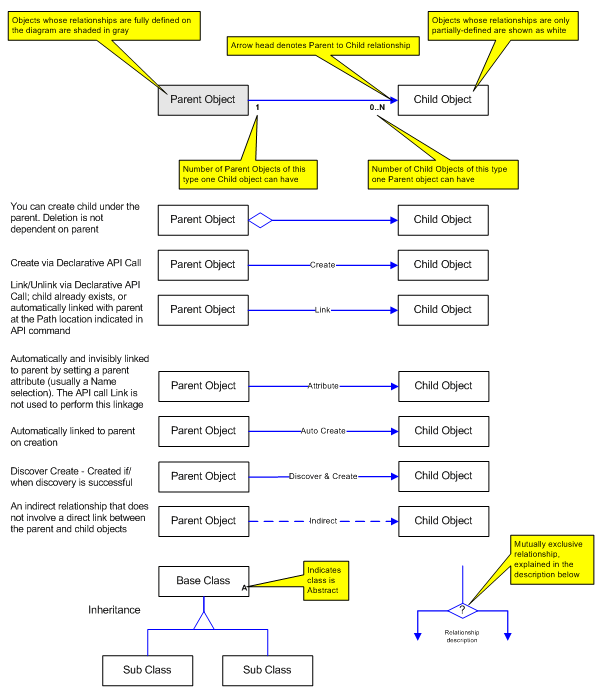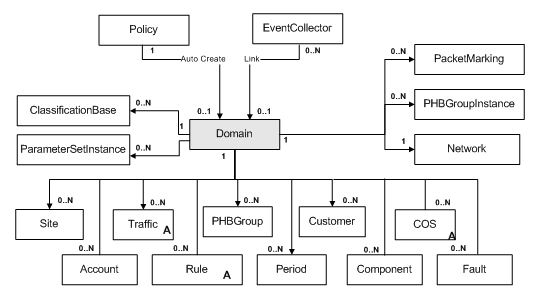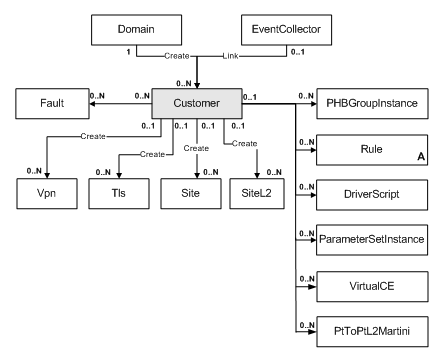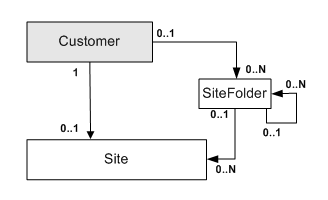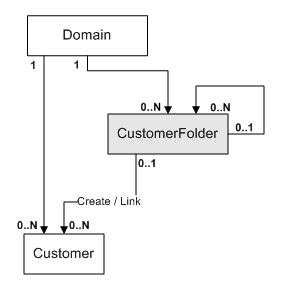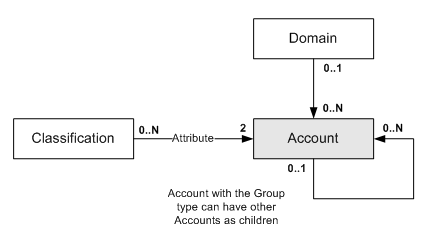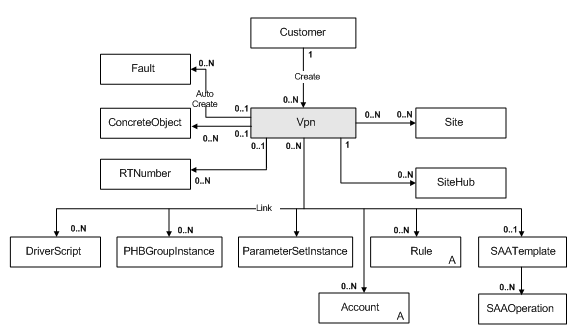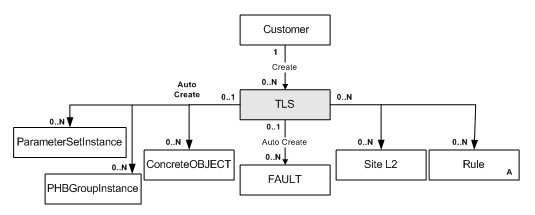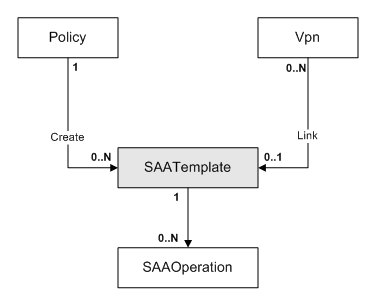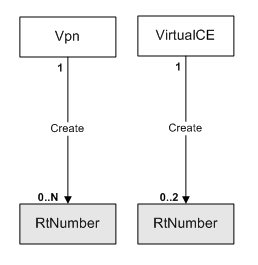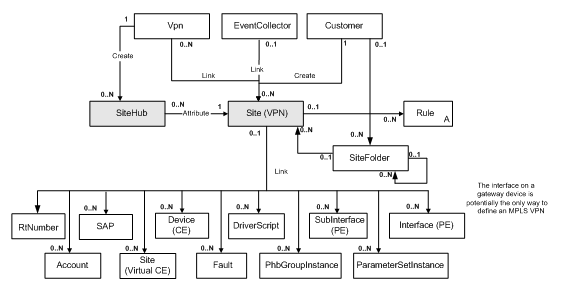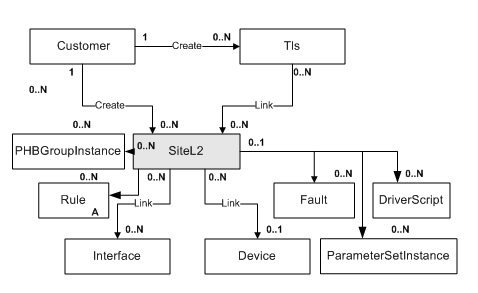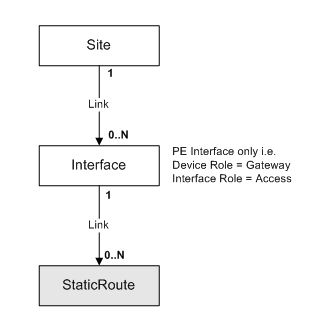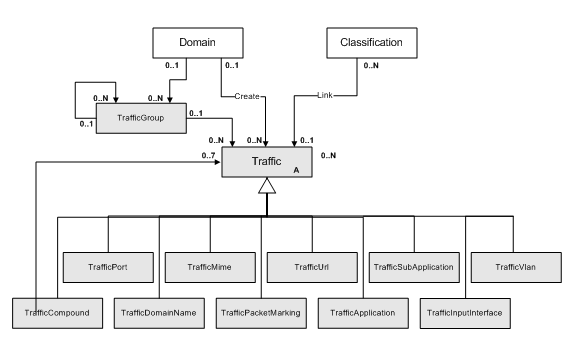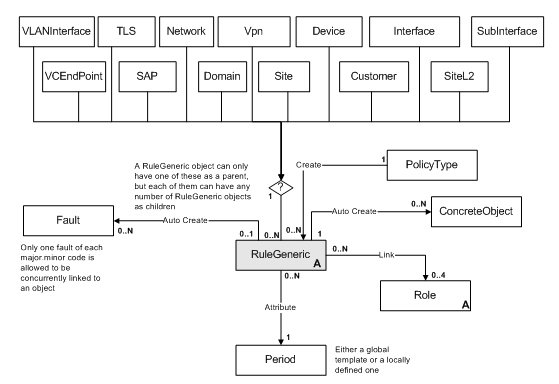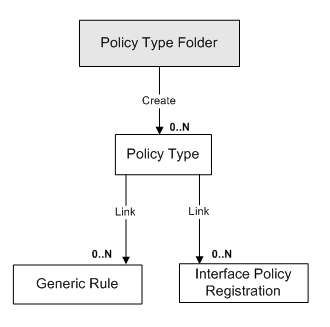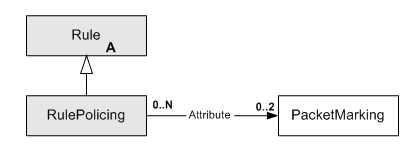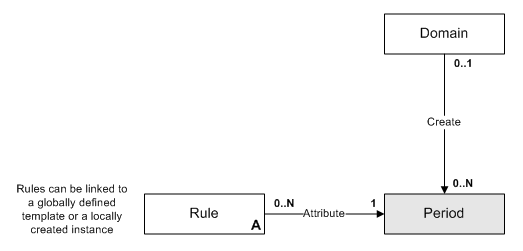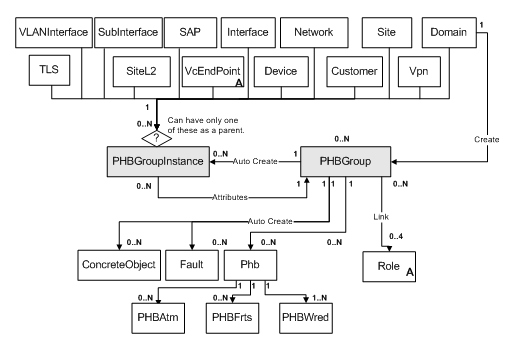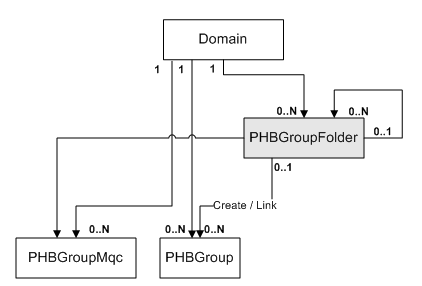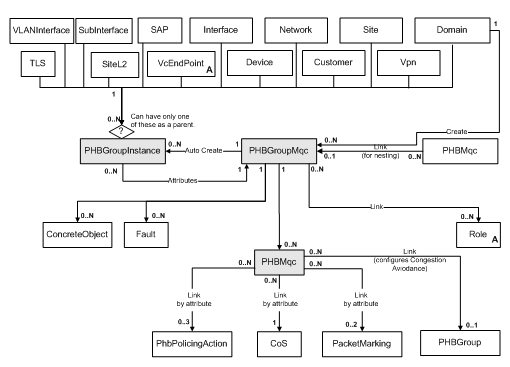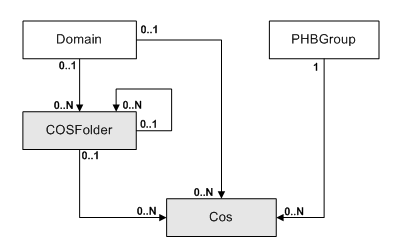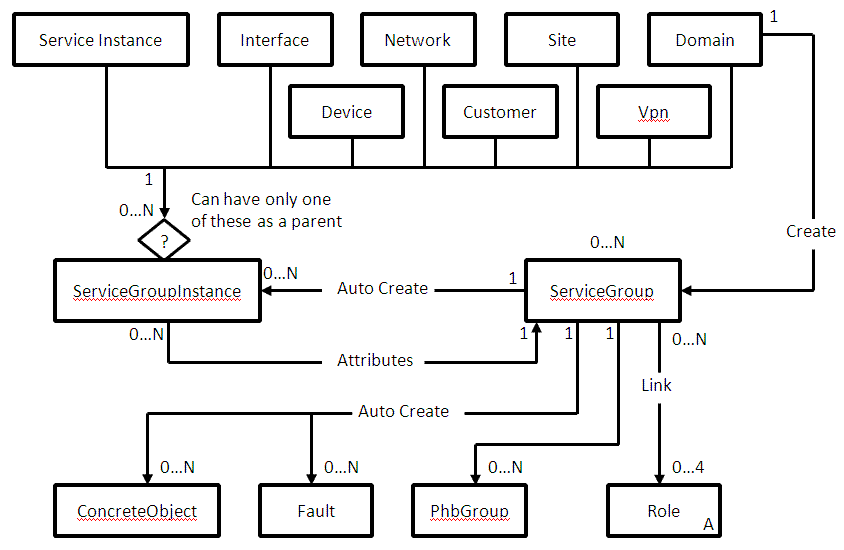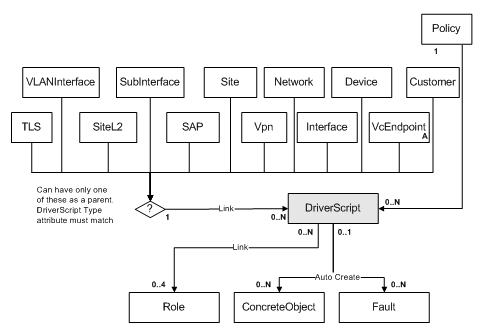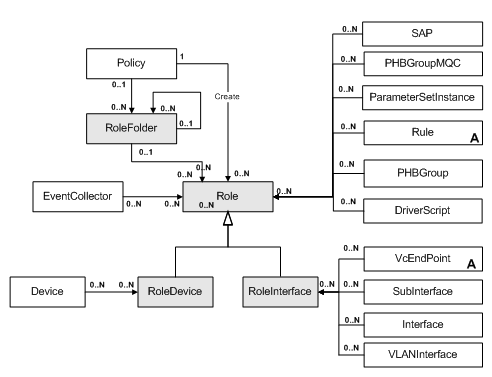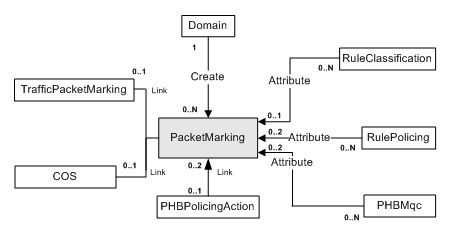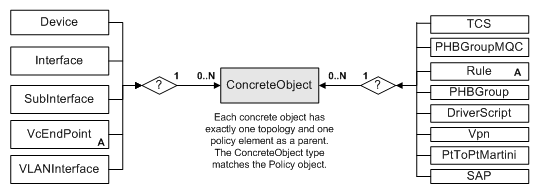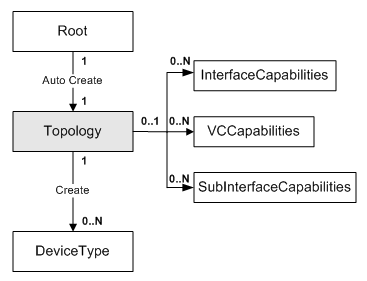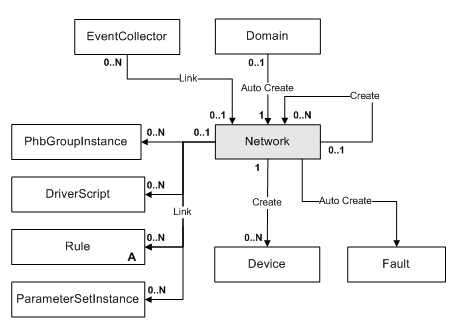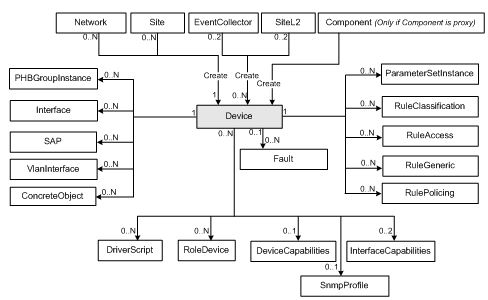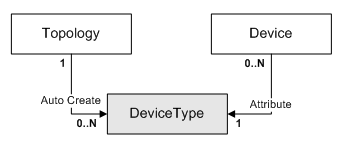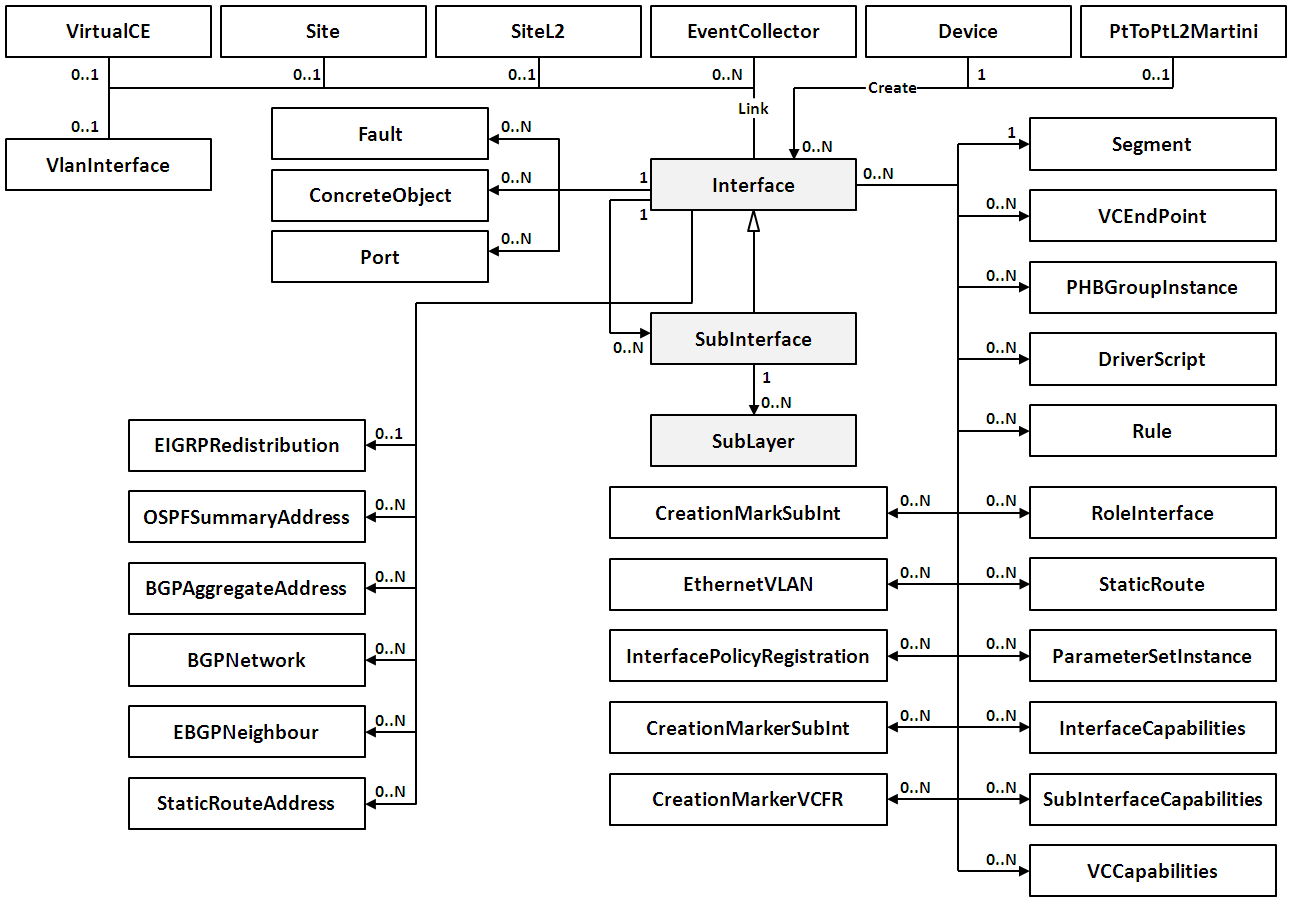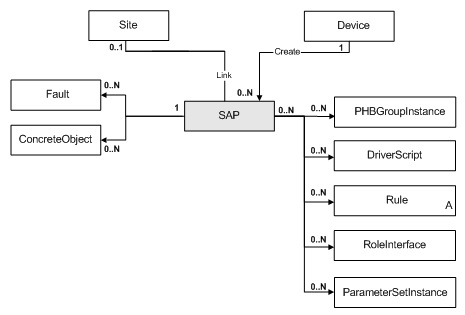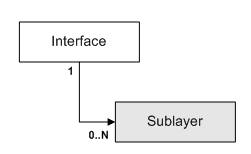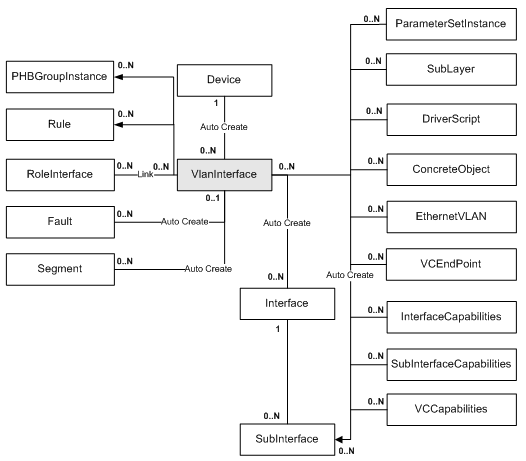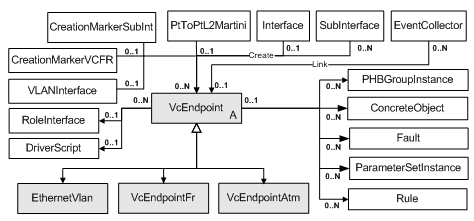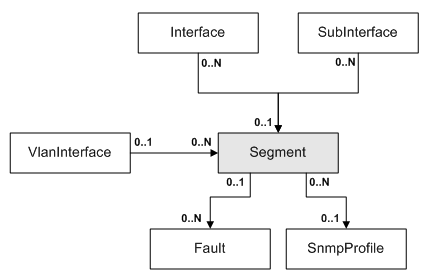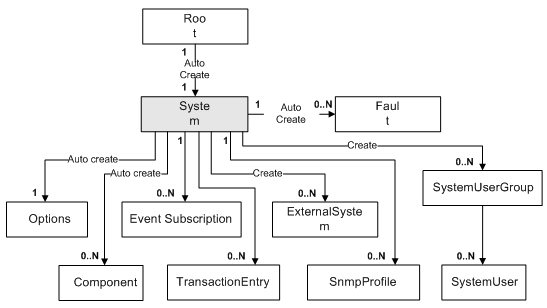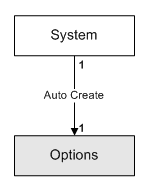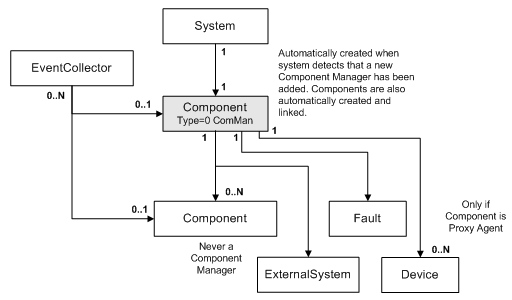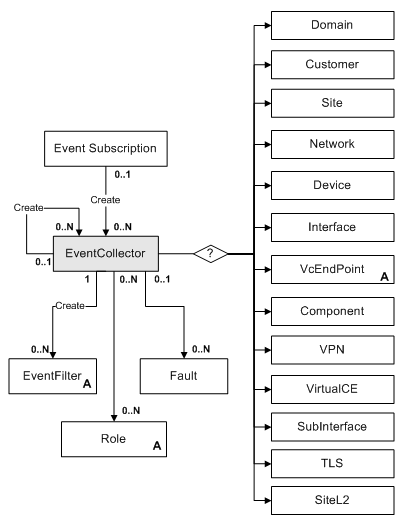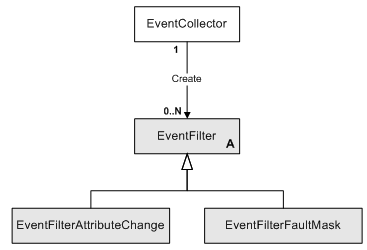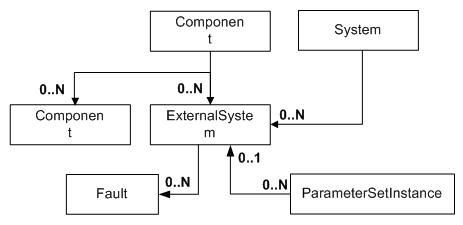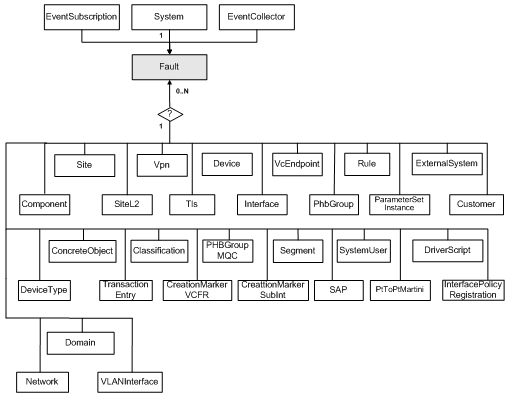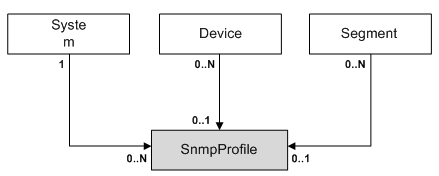3 The External Object Model
This chapter provides details of the External Object Model (EOM).
General Concepts
This section provides the general concepts of the EOM.
Purpose of the External Object Model
The EOM is a simplified version of Oracle Communications IP Service Activator's internal object model. It defines all the objects that can be accessed or updated by external applications, including their attributes and the relationships between them. The EOM is a subset of the object model, allowing user programs to create and access data objects without requiring knowledge of the underlying complexity of the entire object model.
Overall Structure
The EOM is divided into three major categories:
-
Policy: The Policy Model contains objects for defining QoS and security in terms of rules and general QoS mechanisms. It is used in conjunction with the Topology Model to apply QoS and security policies to actual devices in a real network.
-
Topology: The Topology Model contains objects that represent the network topology of the actual managed network, such as VPNs, devices, interfaces and VC objects.
-
System: The System Model contains objects that represent the IP Service Activator system components and associated system management objects.
Object Notation
Objects within the EOM are described under the following headings:
-
Object diagram: Showing the relationships between objects.
-
Attributes: The name, data type, default value, and access type of each attribute of the object, plus any additional explanatory remarks. Note that attribute names must not include spaces, for example, PacketMarkingName. Case is not significant and is used in this document for clarity only.
-
Inheritance: A definition of the attributes that are inherited from other objects (see "Object Inheritance and Abstract Objects").
Access Types
Each attribute has one of the Access Types listed in Table 3-1.
Table 3-1 Attribute Access Types
| Type | Meaning |
|---|---|
|
RO |
Read Only. |
|
RW |
Read/Write. |
|
RC |
Read/Modify on create only. |
|
WO |
The attribute is masked but can be edited (for example, passwords). |
|
CO |
Can be set on object creation only. The attribute will not appear on the object. |
Data Types
Each attribute has one of the Data Types listed in Table 3-2.
Table 3-2 Attribute Data Types
| Type | Meaning |
|---|---|
|
U32 |
Unsigned 32-bit integer. In some cases the value may be restricted to a smaller range than 32 bits. In these cases the range is noted in the text. |
|
String |
A string, containing any alphanumeric characters, generally less than 127 characters. In some cases the maximum length is shorter or longer, and is detailed in the relevant parts of this document. |
|
Enum |
A string representing one member from a set of enumerated values. |
|
Boolean |
Boolean, can be True or False. |
|
IPAddress |
IPv4 address or subnet mask, in the format nnn.nnn.nnn.nnn where nnn <=255. IPv6 address is eight groups of four hexadecimal digits (for example, 2001:0db8:85a3:08d3:1319:8a2e:0370:7334) |
|
DateTime |
Date and time, in the format YYYY/MM/DD HH:MM:SS. All times in OIM are displayed and set as GMT. |
Key to Object Diagrams
Relationships between objects are represented diagrammatically. Figure 3-1 shows the standard way in which information is represented.
Linking by Attribute
To simplify the manipulation of objects, the EOM has the ability in certain cases to link objects by attribute. This means that an attribute of an EOM object may actually be the name of another child object, and modifying that name will unlink the current child and link a new child with the specified name. This actual link is hidden from the user, and is performed automatically.
If such an attribute is modified then the attribute must be changed to the name of an existing object of the correct type. The system will locate the new object to be linked by searching, usually the domain or the policy object.
In most cases the attribute may be modified to an empty string. The child object will then be unlinked, and no replacement object will be linked.
The descriptions of the EOM object indicate which attributes (if any) automatically link to other objects.
Object Inheritance and Abstract Objects
To simplify the representation of data, a concept of abstract objects is used. Abstract objects hold common attributes that are inherited by all child objects.
Abstract objects cannot themselves be accessed via the OIM command set.
Table 3-3 lists and describes the abstract objects.
Table 3-3 Abstract Objects
| Object | Purpose |
|---|---|
|
Object |
Inherited by all EOM objects; common attributes (Name and ID). |
|
Traffic |
Inherited by all traffic type objects (TrafficGroup, TrafficCompound, TrafficMime, TrafficPort, TrafficURL, TrafficApplication, TrafficSubApplication, TrafficPacketMarking or TrafficDomainName, TrafficVlan, TrafficInputInterface). |
|
Rule |
Inherited by all rule objects (RuleAccess, RuleClass, RuleGeneric, or RulePolicing); specifies common rule attributes except RuleGeneric, which specifies a configuration policy. |
|
VCEndpoint |
Inherited by all VC endpoint objects (VCEndpointFr or VCEndpointAtm). |
|
Role |
Inherited by RoleDevice and RoleInterface objects. |
|
ClassificationBase |
Inherited by Classification and ClassificationGroup objects. |
|
EventFilter |
Inherited by EventFilterAttributeChange and EventFilterFaultMask objects. |
Object Reference
All objects within the EOM inherit the ID attribute and the Name attribute from the abstract object. Table 3-4 gives details about these attributes.
Table 3-4 Attributes Inherited from Abstract Objects
| Attribute Name | Type | Default | Access | Explanation |
|---|---|---|---|---|
|
Id |
U32 |
0 |
RO |
Unique object reference, which remains unique for the lifetime of the object. |
|
Name |
String |
[no default] |
RO/RW* |
Name of object. |
*Access varies according to object. See details of each object.
Object Inheritance
Each object inherits attributes from its parent object. This is represented using the following notation:
object.parent.[parent]
For example:
RuleAccess.Rule.Object
indicates that the RuleAccess object inherits attributes from the Rule object, which in turn inherits attributes from the abstract object.
Summary of Objects
This section provides a summary of the objects.
Policy Model Objects
Table 3-5 describes the Policy Model objects.
Table 3-5 Policy Model Objects
| Object | Purpose |
|---|---|
|
Account |
Represents a user, host or subnet account or an account group: a source or destination point to which rules can be applied. |
|
Classification |
Represents a classification object, the association of a source and destination IP address and a traffic between those two hosts. |
|
ClassificationFolder |
Represents a classification folder, used to contain classification objects and other classification folders. |
|
ClassificationGroup |
Represents a group of classification objects. |
|
ClassificationOrder |
Represents a sequence of classification objects. |
|
ConcreteObject |
Represents the actual implementation of a policy element or VPN; automatically created when an object is applied to a point in the network. |
|
Cos |
Represents a class of service. |
|
COSFolder |
Represents a class of service folder, used to contain class of service objects and other class of service folders. |
|
Customer |
Represents a customer, to which VPNs and sites are linked. |
|
CustomerFolder |
Represents a customer folder, used to contain customers and other customer folders. |
|
Domain |
Represents a domain, the logical organization for which policies and services can be defined. |
|
DriverScript |
Represents a driver script, a set of commands defined in Python, that when applied to a device, results in IOS command script being generated. |
|
DriverScriptFolder |
Represents a driver script folder, used to contain driver scripts and other driver script folders. |
|
InterfacePolicyRegistration |
Represents the interface policy registration that informs the IP Service Activator core about a generic policy and its abilities. |
|
PacketMarking |
Defines different classes of service. |
|
ParameterSet |
Represents a set of parameters that can be given different values when applied to different objects. |
|
ParameterSetInstance |
A template object defining a set of parameters that can be applied to different objects. |
|
Period |
Identifies the time, date and or days of the week to which a rule is to apply. |
|
PHB |
Represents the application of a specific queuing mechanism to a class of service |
|
PHBAtm |
Represents the queuing mechanism of ATM traffic shaping to an interface. |
|
PHBFrts |
Represents the queuing mechanism of a Frame Relay traffic shaping to an interface. |
|
PHBGroup |
Represents a PHB group: an implementation of a specific queuing/shaping mechanism available at an interface. |
|
PHBGroupFolder |
Represents a PHB Group folder, used to contain PHB Groups and other PHB Group folders. |
|
PHBGroupInstance |
Represents a particular application of a PHB group on an object: adds the notion of order between PHB groups. |
|
PHBGroupMqc |
Represents an MQC PHB group (the application of a queuing/shaping mechanism via Cisco's Modular QoS CLI.) |
|
PHBMqc |
Represents the application of a specific MQC mechanism to a class of service. |
|
PHBPolicingAction |
Defines a policing action for use with an MQC PHB group that applies policing. |
|
PHBWred |
represents the application of a WRED mechanism to an interface. |
|
Policy |
Represents the root object of the policy tree. |
|
PtToPtL2Martini |
Represents the point-to-point Layer 2 Martini VPN service |
|
RoleDevice |
Represents a given role for a device which defines what policy can be applied to the device. |
|
RoleFolder |
Represents a role folder, used to contain interface and device role objects and other role folders |
|
RoleInterface |
Represents a given role for an interface which defines what policy can be applied to the device. |
|
RtNumber |
Represents a Route Target, as used in MPLS VPNs. |
|
RuleAccess |
Represents an access rule, used to deny or permit access to the network for specific identified traffic. |
|
RuleClassification |
Represents a classification rule, used to classify, mark, and manage network traffic. |
|
RuleGeneric object |
Represents a configuration policy. |
|
Policy Type Object |
Holds information regarding the creation of RuleGeneric objects. |
|
Policy Type Folder Object |
Categorizes policy types within the Object Model. |
|
RulePolicing |
Represents a policing rule, used to police traffic associated with a certain classification. |
|
SAAOperation |
Represents the parameters used to configure an SAA operation. |
|
SAATemplate |
Represents a parent object of SAAOperation. It groups a number of SAAOperation objects. |
|
Service Group |
Represents an Ethernet Virtual Connection (EVC). |
|
Site |
Represents a site: a physical location defined by one or more devices and interfaces. |
|
SiteFolder |
Represents a folder used to contain site objects and site subfolders. |
|
SiteHub |
Represents the hub role of a site in a VPN. |
|
SiteL2 |
Represents a Layer 2 Site. |
|
StaticRoute |
Represents a static route defined for a VPN site. |
|
Tls |
Represents a Transparent LAN Service (Layer 2 VPN). The Tls object is linked to a Customer, and SiteL2 objects are linked to it. |
|
TrafficApplication |
Represents an application-based traffic type. |
|
TrafficCompound |
Represents a compound traffic type: a traffic type that is a combination of two or more traffic types. |
|
TrafficDomainName |
Represents a domain-based traffic type. |
|
TrafficGroup |
Represents a traffic type group: a logical organization of traffic types into a folder-like structure. |
|
TrafficMime |
Represents a MIME-based traffic type. |
|
TrafficPacketMarking |
Represents a traffic type based on packet marking (DiffServ codepoint, IP Precedence or MPLS Experimental marking). |
|
TrafficPort |
Represents a port-based traffic type. |
|
TrafficSubApplication |
Represents a subapplication-based traffic type. |
|
TrafficURL |
Represents a URL-based traffic type. |
|
TrafficVlan |
Represents traffic based on the Layer 2 VLAN identification number. |
|
TrafficInputInterface |
Represents traffic based on the input interface or range of interface through which the traffic or IP packet enters. |
|
Vpn |
Represents a virtual private network, defined by a set of interfaces and/or CE routers. |
Topology Model Objects
Table 3-6 describes the Topology Model objects.
Table 3-6 Topology Model Objects
| Object | Purpose |
|---|---|
|
BgpAggregateAddress |
Represents network statements that BGP will advertise for the site. |
|
Device |
Represents a device within the network: a network node that forwards IP packets, that is, a router or Layer 3 switch. |
|
DeviceCapabilities |
Represents the capabilities of a device. |
|
DeviceType |
Represents the model of a device, for example, Cisco 2500. |
|
EigrpRedistribution |
Redistribution attributes (delay, reliability, loading and mtu) from other protocols (connected, static, Bgp, Rip) into Eigrp. |
|
EthernetVlan |
Represents an Ethernet VLAN. |
|
Interface |
Represents an interface on a device. |
|
InterfaceCapabilities |
Represents the capabilities and characteristics of an interface on the device. |
|
SAP |
Service Application Point. Provides a location to which to attach a VRF in an interface-less site. |
|
Network |
Represents a network, a logical object within a domain comprising a number of devices and, optionally, sub-networks. |
|
OspfSummaryAddress |
Represents the advertising of OSPF routes for redistribution as a summary address. |
|
Segment |
Represents the locally-connected network segment on an interface. |
|
SubLayer |
Represents one protocol sublayer of an interface. |
|
SubInterface |
Represents a sub-interface on an interface. |
|
CreationMarkerSubInt |
Represents a sub-interface with a PVC. |
|
CreationMarkerVcFr |
Represents an interface with a Frame-Relay VC endpoint. |
|
Topology |
Represents the root object of the Topology tree. |
|
VcEndpointAtm |
Represents an ATM PVC endpoint. |
|
VcEndpointFr |
Represents a Frame Relay PVC endpoint. |
|
VlanInterface |
Represents a VLAN interface. |
System Model Objects
Table 3-7 describes the System Model objects.
Table 3-7 System Model Objects
| Object | Purpose |
|---|---|
|
Component |
Represents an IP Service Activator component: Component Manager, Policy Server, Proxy Agent, Device Driver, Event Handler, Integration Manager, or System Logger. |
|
EventCollector |
Represents a monitoring place in the External Object Model; defines the objects on which faults are to be monitored. |
|
EventFilterAttributeChange |
Represents a specific filter associated with an event collector; defines a particular attribute to monitor. |
|
EventFilterFaultMask |
Represents a specific filter associated with an event collector; defines a specific fault or a type of fault to monitor. |
|
EventSubscription |
Represents an event subscription, defining the way in which an external user subscribes to fault and event reporting. |
|
ExternalSystem |
Represents an external system or component. |
|
Fault |
Represents a fault that has been reported from an IP Service Activator component. |
|
Options |
Represents system-wide options. |
|
Root |
Represents the top of the tree of objects. |
|
SnmpProfile |
Represents a user-defined profile of SNMP attributes used to discover a group of devices or individual devices. |
|
System |
Represents the root object of the System tree. |
|
SystemUser |
The system user object is used to create new users and set security restrictions. |
|
SystemUserGroup |
A system user group defines the access level that its members have within IP Service Activator. |
|
TransactionEntry |
Represents a queued or scheduled transaction. |
The Policy Model
This section describes the Policy Model objects.
Policy Object
The Policy object represents the root of the entire policy tree.
The Policy object has the following object inheritance:
Policy.Object
Figure 3-2 shows the Policy object diagram.
Table 3-8 describes the attributes for the Policy object.
Table 3-8 Policy Object Attributes
| Attribute Name | Type | Default | Access | Explanation |
|---|---|---|---|---|
|
Name |
String |
[no default] |
RO |
Always “Policy". |
ParameterSet Object
ParameterSet objects represent a set of parameters that can be given different values when applied to different objects. ParameterSet objects define the names and data types of the parameters, but not the values.
ParameterSet objects have the following object inheritance:
ParameterSet.Object
You cannot create or modify ParameterSet objects through OIM.
Two ParameterSet objects are created automatically as children of the Policy object. These are called CollectorParameterSet and MeasurementParameterSet.
An example showing how parameter sets are applied to configuration targets is shown on "Applying Parameter Sets".
Figure 3-3 shows the ParameterSet object diagram.
Figure 3-3 The ParameterSet Object Diagram
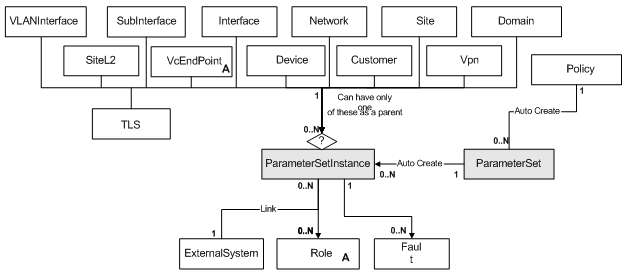
Description of "Figure 3-3 The ParameterSet Object Diagram"
Table 3-9 describes the attributes for the ParameterSet object.
Table 3-9 ParameterSet Object Attributes
| Attribute Name | Type | Default | Access | Explanation |
|---|---|---|---|---|
|
Name |
String |
[no default] |
RO |
Name of the ParameterSet. |
|
Description |
String |
[no default] |
RO |
Description of the ParameterSet. |
|
Levels |
U32 |
30 |
RO |
The level at which the parameters apply. Bitwise value, 1 bit per target: Bit 0 = not used Bit 1 = Device Bit 2 = Interface Bit 3 = Subinterface Bit 4 = VCendpoint |
|
Parameters |
String |
"" |
RO |
The parameters that are defined by this ParameterSet. They will all have a value of "" as their values are only assigned when the ParameterSet is applied somewhere. |
|
ExportedName |
String |
[no default] |
RO |
Name of parameter set as sent to device driver. |
MeasurementParameterSet
Table 3-10 describes the measurement parameters defined by this ParameterSet.
Table 3-10 Measurement Parameters
| Attribute Name | Type | Default | Access | Explanation |
|---|---|---|---|---|
|
OCH_MeasureCBQoS |
String |
False |
RW |
Specifies whether to measure class based QoS. |
|
OCH_MeasureCarQoSMIB |
String |
False |
RW |
Specifies whether to measure CAR QoS MIB. |
|
OCH_MeasureJuniperCoSMIB |
String |
False |
RW |
Monitor Juniper CoS MIBs |
|
OCH_MeasureMIB2Stats |
String |
False |
RW |
Specifies whether to measure SNMP MIB2. |
|
OCH_NetflowEnabled |
String |
False |
RW |
Specifies whether to enable Netflow on the given object. |
|
OCH_NetflowVersion |
String |
1 |
RW |
Specifies which version of Netflow to use. 1=version 1, 2 =version 2, 3=Ag Only |
|
OCH_NetflowAggregation |
String |
1 |
RW |
Specifies which aggregation scheme to use for Netflow. 1=As, 2=Destination-prefix, 3=Prefix, 4=Protocol-port, 5=Source-prefix. |
|
OCH_NetflowCacheSize |
String |
0 |
RW |
Specifies the maximum number of entries in the cache. Range: 1024–524 288 0 = use default |
|
OCH_NetflowTimeoutActive |
String |
0 |
RW |
Specifies the number of seconds before an inactive flow times out. Range 1–60. 0 = use default |
|
OCH_NetflowTimeout Inactive |
String |
0 |
RW |
Number of seconds flow is kept in cache. Range 10–600. 0 = use default |
CollectorParameterSet
The collector parameters defined by this ParameterSet are described in Table 3-11.
Table 3-11 Collector Parameters
| Attribute Name | Type | Default | Access | Explanation |
|---|---|---|---|---|
|
OCH_CollectorName |
String |
[no default] |
RO |
Name of collector. |
|
OCH_CollectorType |
String |
[no default] |
RO |
Type of collector system. |
|
OCH_CollectorIpAddr1 |
String |
[no default] |
RO |
Primary IP address of collector system. |
|
OCH_CollectorIpAddr2 |
String |
[no default] |
RO |
Secondary IP address of collector system. |
|
OCH_CollectorPort1 |
String |
[no default] |
RO |
Primary port number for collector system. |
|
OCH_CollectorPort2 |
String |
[no default] |
RO |
Secondary port number for collector system. |
|
OCH_CollectorURL |
String |
[no default] |
RO |
URL for locating collector system. |
ParameterSetInstance
A ParameterSetInstance object represents an instance of a ParameterSet that has been applied. It is a child of the relevant ParameterSet and the object to which the parameters are applied using the use command (see "The Use Command").
ParameterSetInstance objects have the following object inheritance:
ParameterSet.Object
The ParameterSetInstance has the attributes defined by the ParameterSet object, but the parameters have actual values associated with them. Their types are correctly set, rather than just defined as strings, so for example, OCH_MeasureCBQoS is a Boolean value.
If the ParameterSetInstance is an instance of the MeasurementParameterSet, then the attributes of the ParameterSetInstance are modifiable by OIM.
If the ParameterSetInstance is an instance of the CollectorParameterSet, then the attributes of the ParameterSetInstance cannot be modified via OIM, but instead come directly from the ExternalSystem object that is a child of the ParameterSetInstance. The attributes of the ExternalSystem are modifiable, and modifying them also changes the parameter values of the ParameterSetInstance. For further information about ExternalSystem object, see "ExternalSystem Object".
Figure 3-4 shows the ParameterSetInstance object diagram.
Figure 3-4 ParameterSetInstance Object Diagram
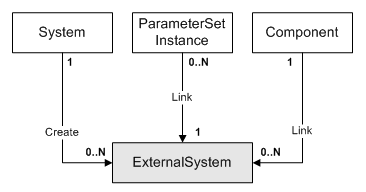
Description of "Figure 3-4 ParameterSetInstance Object Diagram"
An example showing how the parameter sets are applied to configuration targets is shown on "Applying Parameter Sets".
Table 3-12 describes the attributes for the ParameterSetInstance object.
Table 3-12 ParameterSetInstance Attributes
| Attribute Name | Type | Default | Access | Explanation |
|---|---|---|---|---|
|
Levels |
U32 |
0 |
RW |
Bitwise attribute. None = 0, VPN = 1, Device = 2, Interface = 4, SubInterface = 8, PVC = 16 |
|
Name |
String |
[no default] |
RO |
Name of the ParameterSetInstance. |
|
Order |
U32 |
0 |
RO |
The order of the ParameterSetInstance. |
|
Parameters |
Varies |
Varies |
RO/RW |
The parameters from the ParameterSet, with values which apply to the configuration target. |
Domain Object
A policy domain is the logical organization for which policies and services can be defined, that is, all or part of a customer's network.
The Domain object has the following object inheritance:
Domain.Object
Figure 3-5 shows the Domain object diagram.
Table 3-13 describes the attributes for the Domain object.
Table 3-13 Domain Object Attributes
| Attribute Name | Type | Default | Access | Explanation |
|---|---|---|---|---|
|
Name |
String |
[no default] |
RO |
Name of the domain. |
|
Remarks |
String |
[no default] |
RW |
Optional additional comments. Limit of 255 characters. |
|
AsOverride |
Boolean |
True |
RW |
True = Set AS override for EBGP neighbors. False = Do not. |
|
DomainAsOverride |
Boolean |
True |
RW |
True = Use the AsOverride value on all sites. False = Set AsOverride on each site. |
|
AllowAsIn |
U32 |
0 |
RW |
Number of times the same AS can appear in the AS path list (0-10). |
|
VrfTableLimit |
U32 |
0 |
RW |
Maximum number of routes allowed in a VRF (0=No limit). |
|
VrfTableLimit Warning |
U32 |
75 |
RW |
Threshold at which warning is issued. Range: 1–101, where 1–100 = percentage warning 101 = warning only |
|
BgpMd5Key |
Encrypted string |
[no default] |
RW |
BGP MD5 authentication key |
|
PePeSendStandard Community |
Boolean |
True |
RW |
True = Use the PE-PE peering Standard send community tag. False = Do not. |
|
PeCeSendStandard Community |
Boolean |
False |
RW |
True = Use the PE-CE peering Standard send community tag. False = Do not. |
|
PeCeSendExtended Community |
Boolean |
False |
RW |
True = Use the PE-CE peering Extended send community tag. False = Do not. |
|
LoadPolicy |
String |
unset |
RW |
Loads a policy file into the object_model. |
|
UseLoopback |
String |
0 |
RW |
The Loopback ID value is used to create a loopback interface name by appending it to the name 'loopback'. For example, if the Loopback ID is 0, the loopback interface name created is 'loopback0'. When a device in this domain is discovered, a check is made to see if a loopback interface matching this text string exists. If it does, the IP address of the loopback interface is stored with the device information. |
InterfacePolicyRegistration
The interface policy registration informs the IP Service Activator core about a generic policy and its abilities, and is restricted to the interface management scope. Within this scope, the information about a policy is characterized by:
-
Operation: What is the name of the policy? What does this policy do - Create or Decorate? How should this policy be represented in the GUI menus?
-
Context: What kind of device does this policy apply to? At what level can this policy be made available - device, controller, interface or subinterface? If a controller, interface or subinterface is the level chosen, what kind of controller, interface or subinterface should it be?
-
Creation Template: If the policy type is Create, what kind of interface or subinterface does it create? Is there any pattern that its name should follow? What kind of capabilities should that object have upon creation?
Creation capabilities apply only when the object being created is an interface. In that case, all the interface level capabilities have to be specified (linked) - interface caps, subinterface caps and VC caps. Note that you must not modify a caps object linked to a registration. It might be in use by other interfaces - once a caps object is created under the Topology, it is immediately shareable. Instead, create a new caps object, unlink the old one and link in the new one. Or just repeat the interface linkage with another interface that has the desired caps.
A given policy may be registered many times depending upon how flexible it is. For instance, a policy may be able to create a subinterface or decorate an existing one. In such a case, you would register this policy twice - once each for Create and Decorate. Once an interface management generic policy has been registered appropriately, it is ready for use.
Once a given registration is in use, the management operations that can be performed on it are limited. This is to ensure we do not orphan the current users or create a mismatch between the current users and post-modification future users. In-use registrations cannot be deleted. They can be modified, but only certain attributes can change:
-
They can be disabled. A disabled registration no longer appears on any GUI menus and cannot be used anew - the existing usages remain unimpacted.
-
Their name can change.
-
Their menu text can change.
In order to create an interface (subinterface), the user must set their path to the Device (Interface). They have to then create a stub object: "create Interface:SomeName", or "create SubInterface:SomeName". Then they have to link the desired registration (child) to the stub object (parent). It is recommended they commit at this point so their EOM is updated with the new object. They have to then link the desired role (child) to the stub object. Under the stub object, they will find the generic policy instance. They have to modify its payload attributes with the appropriate XML string. Now, a commit will complete the creation operation.
To configure an object, you must simply link the desired registration (child) to the desired object (parent). It is recommended they commit at this point so their EOM is updated with the new objects. The desired object must be linked to an appropriate role. Under that desired object, they will find the generic policy instance. They have to modify its payload attributes with the appropriate XML string. Now, a commit will complete the configure operation.
To delete a created interface or subinterface, the user must simply delete the object.
To remove the configuration of a previously configured object, the user must simply unlink the applied registration from the object.
Figure 3-6 shows the InterfacePolicyRegistration object diagram.
Figure 3-6 InterfacePolicyRegistration Object Diagram
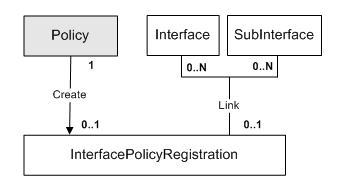
Description of "Figure 3-6 InterfacePolicyRegistration Object Diagram"
Table 3-14 describes the attributes for the InterfacePolicyRegistration object.
Table 3-14 InterfacePolicyRegistrationAttributes
| Attribute Name | Type | Default | Access | Explanation |
|---|---|---|---|---|
|
Context |
Enum |
Device |
RW |
The kind of object you will apply this registration on - either a device, controller, interface or sub-interface. 0 = "Device" 1 = "Interface" 2 = "SubInterface" 3 = "Controller" |
|
ContextDefault |
Boolean |
False |
RW |
Context attribute is used only when ContextDefault is set to false. |
|
ContextPattern |
String |
RW |
Used only if the Context is Controller, Interface or SubInterface. The context matching is extended to additionally require that the context name begins with this pattern. |
|
|
ContextSnmpIfType |
U32 |
0 |
RW |
The interface type. Valid for all Applied Contexts except for device. For example, if you are creating a sub-interface on an interface that has an ifType of "32", then the SNMP ifType is "32". |
|
ContextSnmpIfTypeList |
String |
RW |
Comma separated list of SNMP ifType of the interfaces or subinterfaces where this policy can be chosen. It is used only if Context is Interface or SubInterface and if ContextDefault is not set. |
|
|
CreationPrefix |
String |
RW |
This value pre-populates the interface properties page when you use this registered policy and allows IP Service Activator to validate the supplied interface or sub-interface name during creation. |
|
|
CreationSnmpIfType |
U32 |
6 |
RW |
This value pre-populates the interface properties page with SNMP ifType. |
|
CreationUseParentPrefix |
Boolean |
False |
RW |
Valid for sub-interface creation only. This value indicates whether the registered policy will get the prefix from the parent interface. |
|
Enabled |
Boolean |
True |
RW |
Whether the registration is operational. |
|
GenericPolicyTypeName |
String |
RW |
Generic policy type |
|
|
MenuText |
String |
RW |
GUI: The text that will display in the right-click drop-down menu at the point where you wish to apply interface management policies. |
|
|
Name |
String |
RO |
Name for the interface policy registration |
|
|
PolicyType |
Enum |
Create |
RW |
Identifies the interface policy type being registered. |
|
SnmpIfSpeed |
U32 |
0 |
RW |
Default bandwidth for created interface or sub-interface in kbps. This value is only for validation purposes. The actual speed depends on the given configuration policy. |
|
VendorEnterpriseId |
U32 |
0 |
RW |
A vendor-specific and series-specific ID. Refers to the kind of device you are applying the registration to. For example, the SNMP Enterprise ID for Cisco is "9" and for Juniper it is "2636". |
Customer Object
A Customer object represents the concept of a customer, to which VPNs and sites are linked.
Customer objects have the following object inheritance:
Customer.Object
Figure 3-7 shows the Customer object diagram.
Table 3-15 describes the attributes for the Customer object.
Table 3-15 Customer Object Attributes
| Attribute Name | Type | Default | Access | Explanation |
|---|---|---|---|---|
|
Name |
String |
[no default] |
RW |
Name of the customer. |
|
Remarks |
String |
[no default] |
RW |
Optional additional comments. Limit of 255 characters. |
|
Reference |
String |
[no default] |
RW |
Customer reference. No format is imposed. |
SiteFolder
The SiteFolder object defines a site folder used to contain site objects and site subfolders. A SiteFolder can be a child of Customer or a child of another SiteFolder object.
Figure 3-8 shows the SiteFolder object diagram.
Table 3-16 describe the attributes for the SiteFolder object.
Table 3-16 SiteFolder Object Attributes
| Attribute Name | Type | Default | Access | Explanation |
|---|---|---|---|---|
|
AccountRef |
String |
RW |
Text field to store customer reference information. Note: No inheritance is implied between sites in the site folder(s) and the Account Ref field value in the site folder. |
|
|
Remarks |
String |
RW |
Optional additional information about the site. This is a free-format text string. It is for information only and is not used by IP Service Activator. Limit of 255 characters. |
|
|
Name |
String |
RW |
CustomerFolder Object
A CustomerFolder object represents a folder which contains customer objects, or other CustomerFolder objects, for purposes of organization within the GUI.
CustomerFolder objects have the following object inheritance:
CustomerFolder.Object
Figure 3-9 shows the CustomerFolder object diagram.
A Customer always has either 1 or 2 parents and is always linked to its parent Domain. It may be linked to zero or one parent CustomerFolders. In the IP Service Activator GUI, if a Customer has 2 parents, it will always be displayed under the CustomerFolder, not under the Customers folder. If a customer is created under a folder, it is automatically linked to its parent Domain.
A Customer folder is a child of either another Customer folder or the Domain, but not both.
Table 3-17 describes the attributes for the CustomerFolder object.
Table 3-17 CustomerFolder Object Attributes
| Attribute Name | Type | Default | Access | Explanation |
|---|---|---|---|---|
|
Name |
String |
[no default] |
RW |
Name of the customer folder. |
|
Remarks |
String |
[no default] |
RW |
Optional additional comments. Limit of 255 characters. |
Account Object
An account is a source or destination point in the network to which policy rules can be applied. An account in this context can be one of the following:
-
A user, identified by a name and an IP address
-
A host computer, identified by an IP address
-
A subnet
Account objects have the following object inheritance:
Account.Object
Accounts can be organized into a hierarchical structure of groups for organizational purposes or to represent the structure of a company.
-
Accounts must be set up via the IP Service Activator user interface, but existing accounts can be browsed in the EOM.
-
In the EOM, Account objects are not strictly required for the correct operation of policy objects; use of Accounts is therefore limited.
-
Existing accounts may be referred to by name when manipulating Rule objects.
-
Rules do not require host/subnet accounts to be entered; IP addresses may be input directly.
Figure 3-10 shows the Account object diagram.
Table 3-18 describes the attributes for the Account object.
Table 3-18 Account Object Attributes
| Attribute Name | Type | Default | Access | Explanation |
|---|---|---|---|---|
|
Name |
String |
[no default] |
RO |
Name of the account. |
|
Remarks |
String |
[no default] |
RO |
Optional additional comments. Limit of 255 characters. |
|
Type |
String |
"User" |
RO |
Type of account; one of:
|
VPN Object
A virtual private network, defined by a set of sites (PE interfaces or CE routers) at the edge of the core network cloud. A VPN is a general concept and is independent of the various technologies that may be used to provide the privacy and/or routing independence.
The VPN object has the following object inheritance:
Vpn.Object
Figure 3-11 shows the VPN object diagram.
Table 3-19 describes the attributes for the VPN object.
Table 3-19 VPN Object Attributes
| Attribute Name | Type | Default | Access | Explanation |
|---|---|---|---|---|
|
Name |
String |
[no default] |
RW |
Name of the VPN. |
|
Description |
String |
[no default] |
RW |
Free-format comments about the VPN. Limit of 255 characters. |
|
Type |
Enum |
0 |
Type of VPN: 0 = None 1 = MplsVpn |
|
|
Level |
U32 |
4 |
RW |
Priority level of the VPN, in the range 0–7. This value is only used if a site is included in more than one VPN, which may result in conflict. The VPN with the lowest level number will take precedence. |
|
MplsVpnType |
Enum |
0 |
RW |
Topology of MPLS VPN: 0 = FullMesh 1 = HubAndSpoke 2 = Management |
|
VpnId |
U32 |
0 |
RO |
Unique number of VPN relative to its customer. |
|
Context |
String |
[no default] |
RW |
Local context for driver scripts applied at network level (max 512 bytes). |
|
UseOneRdPer Vpn |
Boolean |
False |
RW |
True = Apply the same VRF table name and RD number to all sites that participate in this VPN False = Generate a site-specific VRF table name and RD number for each site that participates in the VPN |
|
InstallDhcp |
Boolean |
False |
RW |
True = Install DHCP support on the VRFs. False = Do not install DHCP support on VRFs. |
|
PrimaryDhcpIpAddr |
IPAddress |
0.0.0.0 |
RW |
Primary DHCP Server |
|
SecondaryDhcpIpAddr |
IPAddress |
0.0.0.0 |
RW |
Secondary DHCP Server |
|
EbgpMd5Key |
Encrypted string |
[no default] |
RW |
BGP MD5 authentication key [no default]=not used. |
|
OspfMd5Key |
Encrypted string |
[no default] |
RW |
OSPF MD5 authentication key [no default]=not used. |
|
Multipath |
Boolean |
False |
RCW |
Applies protocol-independent load balancing to the default routing table for that routing instance (applicable for routers running JUNOS) |
|
VpnUnequalCost |
Boolean |
False |
RCW |
Specifies what routes to consider (applicable for routers running JUNOS) |
|
EqualExternalInternal |
Boolean |
False |
RCW |
Specifies that both external and internal BGP paths can be selected for multipath. (applicable for routers running JUNOS) |
|
CreateDefaultRTNumbers |
Boolean |
False |
RC |
Applies only when the Layer2VPN is created. If set to True, the TP Service Activator automatically generates two Route Targets. |
|
LabelMode |
Enum |
None |
RCW |
Enables MPLS/VPN label mode: 0=None (don't enable label mode) 1=PerVrf 2=PerCe |
The attributes described in Table 3-20 only apply if UseOneRdPerVpn is set to True, i.e. VRF tables and RD numbers are defined once per VPN, rather than separately for each site (see also "Site objects").
Table 3-20 VPN Attributes if UseOneRdPerVpn is Set to True
| Attribute Name | Type | Default | Access | Explanation |
|---|---|---|---|---|
|
ForceVrfInstall |
Boolean |
True |
RW |
True = VRF tables on corresponding interfaces must be installed and cannot be merged into other tables. False= VRF tables can be merged into other tables. |
|
ShareableVrf |
Boolean |
False |
RW |
True = Other tables can be merged into this VRF table. False = Other tables cannot be merged into this VRF table. |
|
OverrideVrf Table Limit |
Boolean |
False |
RW |
True = Use site-specific settings for VRF table limits False = Use domain defaults for VRF table limits |
|
VrfTableLimit |
U32 |
0 |
RW |
Maximum number of routes allowed in a VRF (0=No limit). |
|
VrfTableLimit Warning |
U32 |
0 |
RW |
Percentage at which to warn of VRF table limits being exceeded. Range: 1–101 1–100 = percentage of VrfTableLimit reached warning. 101 = warning when VrfTableLimit reached. |
|
VrfTableName |
String |
[no default] |
RW |
The name of the VRF routing table. |
|
RDHighOrder |
U32 |
0 |
RW |
The top 32 bits of the Route Descriptor value. |
|
RDLowOrder |
U32 |
0 |
RW |
The bottom 32 bits of the Route Descriptor value. |
|
VrfImport |
U32 |
1 |
RW |
The number of device redundant path configurations. Range is 216 plus the default. |
|
UseVrfImport |
Boolean |
True |
RW |
True = Use VRF import False = Do not use VRF import |
|
EBgpMaxPaths |
U32 |
1 |
RW |
Allows the specification of the maximum number of parallel EBGP routes that can be installed on the device. This corresponds to the Cisco maximum-paths command. Range: 1–16. |
|
IBgpMaxPaths |
U32 |
4 |
RW |
Allows the specification of the maximum number of parallel EBGP routes that can be installed on the device. This corresponds to the Cisco maximum-paths command. Range: 1–16. |
|
EIBgpMaxPaths |
U32 |
1 |
RW |
Allows the specification of the maximum number of parallel EBGP and IBGP routes that can be installed on the device. This corresponds to the Cisco maximum-paths eibgp command. Range: 1–16. |
|
EigrpMaxPaths |
U32 |
1 |
RW |
Allows the specification of the maximum number of parallel EIGRP routes that can be installed on the device. This corresponds to the Cisco maximum-paths eigrp command. Range: 1–16 for IOS 12.3(2)T and later 12.3(T), and from 1–6 in earlier versions. The default value is 4. |
|
EigrpMd5KeyChainRef |
String |
-- |
RW |
Specify the key chain name to use with MD5 Authentication for EIGRP. |
|
IBgpUnequalCost |
Boolean |
False |
RW |
Allows unequal cost load balancing by selecting iBGP paths that do not have an equal cost. |
|
OspfMd5AreaLevelAuth |
Boolean |
False |
RW |
Enables MD5 key authentication for OSPF for the VPN. |
|
UseVrfLabel |
Boolean |
False |
RW |
Enables Juniper vrf-table-label support. When this field is set to true, the inner (VPN) label of a packet is removed as it arrives at a VRF so that it can be processed based on the contents of its IP header. When this field is set to false, incoming packets are mapped directly onto an outgoing (CE-facing) interface based on the inner VPN label. |
|
VrfDesc |
String |
-- |
RW |
Allows a VRF table route to be advertised to other PE routers only if its prefix matches one of those specified in the export map. The export map tags exported routes with the RT number of each site that needs to receive those routes. Export maps must be manually pre-configured on the PE router. |
|
VrfExportFilter |
String |
-- |
RW |
Allows a VRF table route to be advertised to other PE routers only if its prefix matches one of those specified in the export map. The export map tags exported routes with the RT number of each site that needs to receive those routes. Export maps must be manually pre-configured on the PE router. |
|
VrfImportFilter |
String |
-- |
RW |
A VRF Import Map allows the site to selectively import routes learned elsewhere. |
|
CreateDefaultRTNumbers |
Boolean |
True |
RC |
Applies only when the VPN is created. If set to True, IP Service Activator automatically creates two route targets (RTNumber objects) for the newly created VPN. If set to False, you must create one or more route targets (RTNumber objects) for the newly created VPN. |
PtToPtL2Martini Object
A Layer 2 Martini virtual private network, defined by endpoints (PE interfaces or CE routers) at the edge of the core network cloud and encapsulating various types of data across the Martini VPN tunnel.
The PtToPtL2Martini object has the following object inheritance:
L2PtToPtMartini.Object
Figure 3-12 shows the PtToPtL2Martini object diagram.
Figure 3-12 PtToPtL2Martini Object Diagram
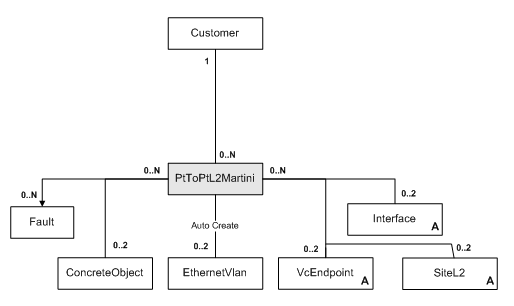
Description of "Figure 3-12 PtToPtL2Martini Object Diagram"
Table 3-21 describes the attributes for the PtToPtL2Martini object.
Table 3-21 PtToPtL2Martini Object Attributes
| Attribute Name | Type | Default | Access | Explanation |
|---|---|---|---|---|
|
Name |
String |
“" |
RW |
Simple accessory to this object. |
|
Remarks |
String |
RW |
General comments. Limit of 255 characters. |
|
|
ConnectionType |
Enum |
0 |
RW |
The type of Martini connection to be made: ATM_AAL5 = 0 ATM_Cell = 1 Frame = 2 Ethernet = 3 Ethernet_VLAN = 4 |
|
MartiniVcId |
U32 |
1 |
RW |
Range: 1–0xFFFFFFFF |
|
ActualMartiniVcId |
U32 |
0 |
RO |
Value actually in use, user-defined or generated |
|
GenerateIdentifier |
Boolean |
False |
RW |
Allows the Martini site to be created if set to True. Note: When modifying bGenerateIdentifier to False you should also modify the MartiniVcId in the same transaction, as the default is '1'. |
TLS Object
A Transparent LAN Service is a service used to connect together separate LAN segments via an MPLS cloud and make them appear as if they were forming a unique VLAN. TLS objects can be used to connect distinct physical ports or specific VLANs associated with physical ports. In the first case, the ports are known as “host ports", whereas in the second case they are called “trunk ports" (in both case, ports are a synonym for the Interface objects).
The TLS object has the following object inheritance:
Tls.Object
Note that policy (rules, PHB groups and driver groups) applied on the TLS or higher up in the inheritance hierarchy (for example on the customer) is not inherited through TLS objects down to the specific ports.
If a TLS has a ServiceType attribute of PortAndVlan, the range of VLAN IDs specified on the TLS will be used to set up the TLS customer profile on the PE port. The actual VLANs created on the PE port and on the MTU ports can be specified on the site itself (but must be a subset of the VLAN IDs specified on the TLS). If no VLAN IDs and no encapsulation are specified on the L2Site object, all the VLANs that are part of the TLS range will be created on the PE and MTU in the site.
The system validates that on a CE/MTU the same VLAN is not used in the context of different TLS services, to avoid cross communications between the TLSs. It is assumed that on the PE, VLANs created in the context of different PortAndVlan based TLSs will be prevented from communicating by the customer profile.
Figure 3-13 shows the TLS object diagram.
Table 3-22 describes the attributes for the TLS object.
Table 3-22 TLS Object Attributes
| Attribute Name | Type | Default | Access | Explanation |
|---|---|---|---|---|
|
Name |
String |
[no default] |
RW |
Name of Layer 2 VPN. |
|
Description |
String |
[no default] |
RW |
Free-format description of the Layer 2 VPN. |
|
Topology |
Enum |
0 |
RW |
VPN topology. At present, only Full Mesh is supported. 0 = FullMesh 1 = HubAndSpoke 2 = Management |
|
ServiceType |
Enum |
0 |
RW |
Defines how access to the TLS is managed 0 = Port Based 1 = PortAndVlanBased |
|
ProfileVlanIds |
String |
[no default] |
RW |
If ServiceType = 1, specifies which VLANs should be made part of the customer profile. Can be a single VLAN ID, or several comma- separated IDs, and can include ranges (e.g. 4, 10-15) |
|
PortsConfiguration |
Enum |
0 |
RW |
If ServiceType = 0, all PE ports in all sites share the same configuration: 0 = OnlyUntaggedFrames Accept only untagged frames (access port) 1 = OnlyTaggedFrames Accept only pre-tagged frames (trunk port) |
|
Conflict |
Boolean |
False |
RO |
True = TLS is failing. False = TLS is not in error. |
|
GenerateVCId |
Boolean |
True |
RW |
Autogeneration of the VC ID. |
|
Stacked |
Enum |
Unstacked |
RW |
To select a Stacked VLAN or Unstacked. Use Stacked when the packets coming into the site from the CE are already tagged with a customer-specific VLAN ID. An additional tag is added as the packets move out of the site to the PE. Valid entries are: Stacked, Unstacked. |
|
StackedVlanTag |
U32 |
0 |
RW |
Provide the VLAN ID(s) that packets are to be tagged with. |
SAATemplate Object
An SAATemplate object is a parent object which groups a number of SAAOperation objects.
The SAATemplate object has the following object inheritance:
SAATemplate.Object
Figure 3-14 shows the SAATemplate object diagram.
Table 3-23 describes the attributes for the SAATemplate object.
Table 3-23 SAATemplate Object Attributes
| Attribute Name | Type | Default | Access | Explanation |
|---|---|---|---|---|
|
Name |
String |
[no default] |
RW |
Name of the SAA template. |
|
Remarks |
String |
[no default] |
RW |
Optional additional comments. Limit of 255 characters. |
|
DeviceBits |
U32 [6-11] |
10 |
RW |
Defines how many devices can be configured per VPN ID (allowing up to 1024 devices per SAA VPN). |
|
TosBits |
U32 [1-3] |
2 |
RW |
Defines how many probes (SAA operations) can be configured (up to 64). |
|
TypeBits |
U32 [1-3] |
2 |
RW |
Defines how many measurement types can be configured per VPN (up to 8). |
Note:
The combined value of the DeviceBits, TosBits and TypeBits attributes must be exactly 14.
SAAOperation Object
An object that represents the parameters that will be used to configure an SAA operation and where the operation will be configured; that is, on one (half duplex) or both (full duplex) devices for each tested connection in a VPN.
The SAAOperation object has the following object inheritance:
SAAOperation.SAATemplate.Object
See Figure 3-14 for the SAAOperation object diagram.
Table 3-24 describes the attributes for the SAAOperation object.
Table 3-24 SAAOperation Attributes
| Attribute Name | Type | Default | Access | Explanation |
|---|---|---|---|---|
|
Name |
String |
[no default] |
RO |
Name of the SAA operation object. |
|
Type |
Enum |
0 |
RW |
Type of operation: 0 = IcmpEcho 1 = TcpConnect 2 = UdpEcho 3 = Jitter |
|
Duplex |
Enum |
0 |
RW |
The test performed on a connection: 0 = HalfDuplex 1 = FullDuplex |
|
Period |
U32 |
0xFFFFFFFF |
RW |
Frequency with which a measurement is performed (seconds). Range: 0–604800 Default value indicates no specific period will be used. |
|
Timeout |
U32 |
0xFFFFFFFF |
RW |
Timeout in seconds. Must not be greater than frequency. Range 0–604 800 000 Default value indicates no specific timeout will be used. |
|
Lifetime |
U32 |
0xFFFFFFFF |
RW |
Lifetime of the operation defined in seconds. A value of –1 indicates the operation is active forever. Range: 0–2 147 483 647 |
|
RisingThreshold |
U32 |
0xFFFFFFFF |
RW |
Sets the rising threshold that generates a reaction event and stores history information for the operation. Defined in milliseconds. Frequency with which a measurement is performed (seconds). Default value indicates no specific period will be used. Range: 0–2 147 483 647 |
|
FallingThreshold |
U32 |
0xFFFFFFFF |
RW |
Falling threshold in milliseconds. Default value indicates no specific period will be used. Range: 0–2 147 483 647 |
|
ThresholdType |
Enum |
1 |
RW |
Algorithm used to calculate the passing of thresholds. 0 = Never 1 = Immediate 2 = Consecutive 3 = XofY 4 = Average |
|
Consecutive Occurrences |
U32 |
0 |
RW |
The number of consecutive threshold violations that trigger the action defined by the ActionType attribute. 0 = Use default. Range: 0–16 |
|
Xofy_x |
U32 |
0 |
RW |
Value of X when ThresholdType is XofY. 0 = Use default. Range: 0–16 |
|
Xofy_y |
U32 |
0 |
RW |
Value of Y when ThresholdType is XofY. 0 = Use default. Range: 0–16 |
|
Average |
U32 |
0 |
RW |
Parameter for ‘Average' ThresholdType. Range: 0–16 |
|
ActionType |
U32 |
0 |
RW |
Bitwise value, indicating actions that occur when the threshold is passed. 0 = None 1 = Trap 2 = Nmvt 4 = Trigger |
|
DsCodepoint |
U32 |
0 |
RO |
The IP ToS byte for request packets. Applies to ICMP Echo, UDP Echo and Jitter operations. |
|
DestPort |
U32 |
0 |
RW |
Destination port number. 0 = use default. The following defaults apply: TcpConnect: 23 UdpEcho: 7 Jitter: 8000 |
|
SourcePort |
U32 |
0 |
RW |
Source port number. 0 = use default. The following defaults apply: TcpConnect: 23 UdpEcho: 7 Jitter: 8000 |
|
RequestSize |
U32 |
28-Icmp 1-Tcp 16-Udp 32-Jitter 28-Http 1-Dns |
RW |
Sets the protocol data size in the payload of the operation's request packet. 0xFFFFFFFF = Use default. Valid sizes are: IcmpEcho: >0–65535 TcpConnect: >=0–65535 UdpEcho: 4-8192 Jitter: 16-1500 Http: >=0 Dns: >=0 |
|
EnableControl |
Boolean |
False |
RW |
Enable/disable control message sent to destination port. Applies to TcpConnect, UdpEcho and Jitter. |
|
PacketsInSequence |
U32 |
10 |
RW |
Number of packets in sequence. Range: 1–60000 |
|
PacketInterval |
U32 |
20 |
RW |
Inter-packet interval. Range: 1–60000 ms |
|
EnableErrorChecking |
Boolean |
False |
RW |
True=Enables error verification checking. |
|
EnableConnect Checking |
Boolean |
False |
RW |
True=Enables checks for connection loss in connection-oriented protocols. |
|
EnableTimeout Checking |
Boolean |
False |
RW |
True=Enables checks for RTR operation timeouts. |
|
HistoryLives |
U32 |
0 |
RW |
Number of entries (lives) that are stored in the history table for a given operation. Range: 0–25 |
|
HistoryFilter |
Enum |
0 – None |
RW |
Defines the type of history information that will be collected in the history table: 0 = None 1 = All 2 = OverThreshold 3 = Failures |
|
HistoryBuckets |
U32 |
15 |
RW |
Specifies how many data points from which to record data for a given operation. Range: 1–60 |
|
SourcePortSpecified |
Boolean |
False |
RW |
Enables or disables the use of a SourcePort attribute. |
|
TagName |
String |
“<Default>" |
RW |
Tag for the SAA operation. Default value configures tag name as the customer name specified in UI. |
RtNumber Object
Represents a Route Target. A user can create any number of RTs, and for each one select under what circumstances it is to be exported or imported.
The RtNumber object has the following object inheritance:
RtNumber.Object
Figure 3-15 shows the RtNumber object diagram.
Table 3-25 describes the attributes for the RtNumber object.
Table 3-25 RtNumber Object Attributes
| Attribute Name | Type | Default | Access | Explanation |
|---|---|---|---|---|
|
RtHighOrder |
U32 |
0 |
RW |
Route Target number – high order value. If both RtHighOrder and RtLowOrder are set to 0, then the system default is used (the Domain ASN). |
|
RtLowOrder |
U32 |
0 |
RW |
Route Target number – low order value. If both RtHighOrder and RtLowOrder are set to 0, then the system default is used (the ObjectId * 2). |
|
HubBehaviour |
Enum |
0 |
RW |
0 = None 1 = Import 2 = Export 3 = ImportExport |
|
SpokeBehaviour |
Enum |
0 |
RW |
0 = None 1 = Import 2 = Export 3 = ImportExport |
|
MeshBehaviour |
Enum |
0 |
RW |
0 = None 1 = Import 2 = Export 3 = ImportExport Note: Values 0 (None) and 3 (ImportExport) are not supported for Virtual CEs. The complete set of route target restrictions for Virtual CEs follows:
|
|
Name |
String |
[no default] |
RW |
Name of the RtNumber object. |
|
VrfTarget |
Boolean |
False |
RCW |
True = The Juniper cartridge generates VPN configuration using the VRF Target format. One each of Import, Export, and ImportExport can be created on Juniper devices. False = flag is disabled (default). The Juniper cartridge generates policy-based VPN configuration. |
|
AddressFamily |
Enum |
2 |
RW |
Address family for route target. Default is ipv4_ipv6 0 = Ipv4 1 = Ipv6 2 = Ipv4_Ipv6 |
RtNumber for Sites and VPNs
Two RtNumber objects are automatically created whenever a VPN is created with the attribute CreateDefaultRTNumbers set to its default value of True. The attributes of the RT numbers are set according to whether the VPN's MplsVpnType attribute is HubAndSpoke, or FullMesh. The RT numbers represent the default VPN behavior, but may be altered by the user for different behavior. For example, in a hub and spoke VPN with several hubs, the hubs can be set to meshed or non-meshed by altering the RT number object's attributes.
Each RtNnumber object is given RtLowOrder and RtHighOrder values which are unique to the system. RtNumber objects also have three other attributes: HubBehaviour, SpokeBehaviour, and MeshBehaviour which can take one of four values: Import, Export, ImportExport, or None.
By default, one of the RtNumber objects has HubBehaviour set to ImportExport, SpokeBehaviour set to Import, and MeshBehaviour set to ImportExport. The other RtNumber has HubBehaviour set to Import, SpokeBehaviour set to Export, and MeshBehaviour set to None.
A site in a VPN can see another site if it imports an RtNumber that the other site exports.
If the VPN is fully meshed, then the MeshBehaviour attribute is used from the RtNumber objects. In the default case, the MeshBehaviour is to import and export the first RtNumber, so all the sites import and export the same RtNumber ensuring that all the sites are meshed.
If the VPN is hub and spoke, the hub sites use the HubBehaviour, and the Spoke sites use the SpokeBehaviour. In the default case, the hub sites import and export Rt1. The spoke sites import Rt1, so the spokes can see the sites. The hub sites also import Rt2, and the spoke sites export Rt2, so the hubs can see the sites. The spokes export Rt2, but do not import Rt2, so the spokes cannot see other spokes. The hubs export Rt1, and import Rt1 so the hubs can see other hubs.
One common customization is to make the hubs non-meshed so that hubs cannot see other hubs. To achieve that, change the hub behavior of Rt1 from ImportExport to Export. This means that the hubs do not import the same number that they export, so the hubs will not be able to see each other.
Site objects
A Site object has two types: VPN or Virtual CE.
The Site object has the following object inheritance:
Site.Object
A Site object of type VPN represents a physical Site defined by one or more devices and interfaces. PHB groups and rules can be defined at a site level to apply to devices and interfaces within the site or closely related (such as an interface providing the VPN connection). Rules applied at site level are lower priority than rules defined at the device level.
A Site object of type Virtual CE represents a physical Site defined by one or more interfaces from a single CE device. PHB groups and rules can be defined at a site level to apply to interfaces within the site or closely related (such as an interface providing the VPN connection). Rules applied at site level are lower priority than rules defined at the device level.
Figure 3-16 shows the Site object diagram.
Table 3-26 describes attribute common to both VirtualCE and VPN Site objects.
Table 3-26 Attributes Common to VirtualCE and VPN Site Objects
| Attribute Name | Type | Default | Access | Explanation |
|---|---|---|---|---|
|
Type |
Enum |
VPN |
RC |
Type of site: 0 = VPN 1 = VirtualCE Type is defined when the object is created. You cannot convert one type to the other. |
|
Name |
String |
[no default] |
RW |
Name of the site. |
|
Remarks |
String |
[no default] |
RW |
Optional additional comments. Limit of 255 characters. |
|
Contact |
String |
[no default] |
RW |
Name of primary contact at site. |
|
Address |
String |
[no default] |
RW |
Postal address of site. |
|
Telephone |
String |
[no default] |
RW |
Site phone number for contact. |
|
Fax |
String |
[no default] |
RW |
Site fax number for contact. |
|
|
String |
[no default] |
RW |
Site e-mail address for contact. |
|
AccountRef |
String |
[no default] |
RW |
Unique account number. |
|
SiteOfOrigin |
U32 |
4 294 967 295 (hex 0xffffffff) |
RW |
IP Service Activator generates the SOO value itself when required. Valid only if EBGP is the routing protocol. Range: 1–2 147 483 647 plus the default value. |
|
Context |
String |
RW |
||
|
DomainVpnTag |
U32 |
0 |
RW |
To avoid routing loops when you are using OSPF as the routing protocol between a CE and PE device in an MPLS VPN. Routing loops can occur if OSPF routes are passed between PEs in the same network and VPN. The VPN Route tag is one mechanism that can be used to prevent routing loops in multi-homed VPNs. |
|
EigrpAutonomousSystem |
U32 |
0 |
RW |
Specifies the EIGRP ASN for the site. |
|
EigrpSooAsn |
U32 |
0 |
RW |
The Site of Origin will have the form <ASN>:<Origin ID>. EigrpSooAsn is the first part of that value which is <ASN>. |
|
EigrpSooOid |
U32 |
0 |
RW |
The Site of Origin will have the form <ASN>:<Origin ID>. EigrpSooOid is the second part of that value which is <Origin ID>. |
|
EigrpSooRouteMapName |
String |
RW |
Specify a manually configured Route Map. Make sure that the name contains no spaces; this includes leading or trailing spaces and spaces between characters. If there is any space present in the name, it will not be configured on the device. |
|
|
UseEigrpSoo |
Boolean |
False |
RW |
To enable Site of Origin. |
|
GeneratedSoo |
Boolean |
False |
RW |
To have IP Service Activator generate the Site of Origin. |
|
InheritAsn |
Boolean |
False |
RW |
To have the site inherit the default EIGRP ASN specified for the VPN. |
|
PublicIpAddress |
IPAddress |
0.0.0.0 |
RW |
The public IP address of the interface connected to the site. |
|
RedistributeStatic |
Boolean |
False |
RW |
Static routes are redistributed into the dynamic routing protocols configured for the site. |
Table 3-27 describes attributes specific to VPN Site objects.
Table 3-27 Attributes Specific to VPN Site Objects
| Attribute Name | Type | Default | Access | Explanation |
|---|---|---|---|---|
|
BgpAsn |
U32 |
0 |
RW |
BGP Autonomous System Number. Unique number for routing. |
|
RoutingProtocol |
Enum |
3 |
RW |
Type of routing being used between the PE and CE, relevant to MPLS VPNs only: 0 = EBGP 1 = RIP 3 = None 4 = OSPF 5 = EBGP_OSPF 6 = EBGP_RIP 7 = EIGRP 8 = EBGP_EIGRP |
|
InstallStatic |
Boolean |
True |
RW |
True = Static routing is used in conjunction with relevant routing protocol. False = Static routing is not used. |
|
InstallLocalStatic |
Boolean |
True |
RW |
True = Static routes defined in the site are not redistributed. False = Static routes defined in the site are redistributed. |
Table 3-28 describes attributes specific to Virtual CE Site objects.
Table 3-28 Attributes Specific to Virtual CE Site Objects
| Attribute Name | Type | Default | Access | Explanation |
|---|---|---|---|---|
|
CapabilityVrfLite |
Boolean |
False |
RW |
Enables capability vrf-lite for OSPF on VRF-Lite. Value is true or false. |
|
RedistPolicyOspf2Rip |
String |
[no default] |
RW |
Values for redistribution routemap name (policy): distribution into RIP. |
|
RedistPolicyEigrp2Rip |
String |
[no default] |
RW |
Values for redistribution routemap name (policy): distribution into RIP. |
|
RedistPolicyEbgp2Rip |
String |
[no default] |
RW |
Values for redistribution routemap name (policy): distribution into RIP. |
|
RedistPolicyStatic2Rip |
String |
[no default] |
RW |
Values for redistribution routemap name (policy): distribution into RIP. |
|
RedistPolicyConnected2Rip |
String |
[no default] |
RW |
Values for redistribution routemap name (policy): distribution into RIP. |
|
RedistPolicyOspf2Bgp |
String |
[no default] |
RW |
Values for redistribution routemap name (policy): distribution into BGP. |
|
RedistPolicyRip2Bgp |
String |
[no default] |
RW |
Values for redistribution routemap name (policy): distribution into BGP. |
|
RedistPolicyEigrp2Bgp |
String |
[no default] |
RW |
Values for redistribution routemap name (policy): distribution into BGP. |
|
RedistPolicyStatic2Bgp |
String |
[no default] |
RW |
Values for redistribution routemap name (policy): distribution into BGP. |
|
RedistPolicyConnected2Bgp |
String |
[no default] |
RW |
Values for redistribution routemap name (policy): distribution into BGP. |
|
RedistPolicyEigrp2Ospf |
String |
[no default] |
RW |
Values for redistribution routemap name (policy): distribution into OSPF. |
|
RedistPolicyRip2Ospf |
String |
[no default] |
RW |
Values for redistribution routemap name (policy): distribution into OSPF. |
|
RedistPolicyEbgp2Ospf |
String |
[no default] |
RW |
Values for redistribution routemap name (policy): distribution into OSPF. |
|
RedistPolicyStatic2Ospf |
String |
[no default] |
RW |
Values for redistribution routemap name (policy): distribution into OSPF. |
|
RedistPolicyConnected2Ospf |
String |
[no default] |
RW |
Values for redistribution routemap name (policy): distribution into OSPF. |
|
RedistPolicyOspf2Eigrp |
String |
[no default] |
RW |
Values for redistribution routemap name (policy): distribution into EIGRP. |
|
RedistPolicyRip2Eigrp |
String |
[no default] |
RW |
Values for redistribution routemap name (policy): distribution into EIGRP. |
|
RedistPolicyEbgp2Eigrp |
String |
[no default] |
RW |
Values for redistribution routemap name (policy): distribution into EIGRP. |
|
RedistPolicyStatic2Eigrp |
String |
[no default] |
RW |
Values for redistribution routemap name (policy): distribution into EIGRP. |
|
RedistPolicyConnected2Eigrp |
String |
[no default] |
RW |
Values for redistribution routemap name (policy): distribution into EIGRP. |
|
RedistBandwidthOspf2Eigrp |
U32 |
0 |
RW |
bandwidth value in Kilobits per second range 0 - 16777214 |
|
RedistBandwidthRip2Eigrp |
U32 |
0 |
RW |
bandwidth value in Kilobits per second range 0 - 16777214 |
|
RedistBandwidthEbgp2Eigrp |
U32 |
0 |
RW |
bandwidth value in Kilobits per second range 0 - 16777214 |
|
RedistBandwidthStatic2Eigrp |
U32 |
0 |
RW |
bandwidth value in Kilobits per second range 0 - 16777214 |
|
RedistBandwidthConnected2Eigrp |
U32 |
0 |
RW |
bandwidth value in Kilobits per second range 0 - 4294967295 |
|
RedistMetricRip2Ospf |
U32 |
20 |
RW |
Values for redistribution metric: distribution into OSPF. Range is 0 - 16777214 |
|
RedistMetricEigrp2Ospf |
U32 |
20 |
RW |
Values for redistribution metric: distribution into OSPF. Range is 0 - 16777214 |
|
RedistMetricEbgp2Ospf |
U32 |
20 |
RW |
Values for redistribution metric: distribution into OSPF. Range is 0 - 16777214 |
|
RedistMetricStatic2Ospf |
U32 |
20 |
RW |
Values for redistribution metric: distribution into OSPF. Range is 0 - 16777214 |
|
RedistMetricConnected2Ospf |
U32 |
20 |
RW |
Values for redistribution metric: distribution into OSPF. Range is 0 - 16777214 |
|
RedistMetricOspf2Rip |
U32 |
2 |
RW |
Values for redistribution metric: distribution into RIP. Range: 0-16 |
|
RedistMetricEigrp2Rip |
U32 |
0 |
RW |
Values for redistribution metric: distribution into RIP. Range: 0-16 |
|
RedistMetricEbgp2Rip |
U32 |
1 |
RW |
Values for redistribution metric: distribution into RIP. Range: 0-16 |
|
RedistMetricStatic2Rip |
U32 |
0 |
RW |
Values for redistribution metric: distribution into RIP. Range: 0-16 |
|
RedistMetricConnected2Rip |
U32 |
0 |
RW |
Values for redistribution metric: distribution into RIP. Range: 0-16 |
|
RedistMetricOspf2Bgp |
U32 |
0 |
RW |
Values for redistribution metric:distribution into BGP. Range is 0 - 4294967295 |
|
RedistMetricRip2Bgp |
U32 |
1 |
RW |
Values for redistribution metric:distribution into BGP. Range is 0 - 4294967295 |
|
RedistMetricEigrp2Bgp |
U32 |
0 |
RW |
Values for redistribution metric:distribution into BGP. Range is 0 - 4294967295 |
|
RedistMetricStatic2Bgp |
U32 |
0 |
RW |
Values for redistribution metric:distribution into BGP. Range is 0 - 4294967295 |
|
RedistMetricConnected2Bgp |
U32 |
0 |
RW |
Values for redistribution metric:distribution into BGP. Range is 0 - 4294967295 |
|
RedistMetricTypeEigrp2Ospf |
U32 |
2 |
RW |
Metric type. Value 1 or 2. |
|
RedistMetricTypeEbgp2Ospf |
U32 |
2 |
RW |
Metric type. Value 1 or 2. |
|
RedistMetricTypeRip2Ospf |
U32 |
2 |
RW |
Metric type. Value 1 or 2. |
|
RedistMetricTypeStatic2Ospf |
U32 |
2 |
RW |
Metric type. Value 1 or 2. |
|
RedistMetricTypeConnected2Ospf |
U32 |
2 |
RW |
Metric type. Value 1 or 2. |
|
RedistributeOspf |
Boolean |
FALSE |
RW |
Redistribution of Ospf routes into EBGP. Value is true or false. |
|
RedistributeRip |
Boolean |
FALSE |
RW |
Redistribution of Rip routes into EBGP. Value is true or false. |
|
RedistributeEigrp |
Boolean |
FALSE |
RW |
Redistribution of Eigrp routes into EBGP. Value is true or false. |
|
RedistributeStatic |
Boolean |
FALSE |
RW |
Redistribution of static routes into EBGP. Value is true or false. |
|
RedistributeConnected |
Boolean |
FALSE |
RW |
Redistribution of connected routes into EBGP. Value is true or false. |
|
RedistributeEigrpOspf |
Boolean |
FALSE |
RW |
Redistribution from Eigrp to Ospf. Value is true or false. |
|
RedistributeRipOspf |
Boolean |
FALSE |
RW |
Redistribution from Rip to Ospf. Value is true or false. |
|
RedistributeEbgpOspf |
Boolean |
FALSE |
RW |
Redistribution from Ebgp to Ospf. Value is true or false. |
|
RedistributeStaticOspf |
Boolean |
FALSE |
RW |
Redistribution from Static to Ospf. Value is true or false. |
|
RedistributeConnectedOspf |
Boolean |
FALSE |
RW |
Redistribution from Connected to Ospf. Value is true or false. |
|
RedistributeEigrpRip |
Boolean |
FALSE |
RW |
Redistribution from Eigrpto Rip. Value is true or false. |
|
RedistributeOspfRip |
Boolean |
FALSE |
RW |
Redistribution from Ospfto Rip. Value is true or false. |
|
RedistributeEbgpRip |
Boolean |
FALSE |
RW |
Redistribution from Ebgpto Rip. Value is true or false. |
|
RedistributeStaticRip |
Boolean |
FALSE |
RW |
Redistribution from Static to Rip. Value is true or false. |
|
RedistributeConnectedRip |
Boolean |
FALSE |
RW |
Redistribution from Connected to Rip. Value is true or false. |
|
RedistributeOspfEigrp |
Boolean |
FALSE |
RW |
Redistribution from Ospf to Eigrp. Value is true or false. |
|
RedistributeRipEigrp |
Boolean |
FALSE |
RW |
Redistribution from Rip to Eigrp. Value is true or false. |
|
RedistributeEbgpEigrp |
Boolean |
FALSE |
RW |
Redistribution from Ebgp to Eigrp. Value is true or false. |
|
RedistributeStaticEigrp |
Boolean |
FALSE |
RW |
Redistribution from Static to Eigrp. Value is true or false. |
|
RedistributeConnectedEigrp |
Boolean |
FALSE |
RW |
Redistribution from Connected to Eigrp. Value is true or false. |
|
OspfDistributeOutAcl |
String |
[no default] |
RW |
Named ACL for Distribute In filtering. The access list specified is applied to incoming updates on the selected interface. |
|
VirtualCEModellingOnly |
Boolean |
True |
RW |
True = no Virtual CE provisioning is done. False = Virtual CE provisioning is attempted. |
|
RDHighOrder |
U32 |
0 |
RW |
The top 32 bits of the Route Descriptor value. |
|
RDLowOrder |
U32 |
0 |
RW |
The bottom 32 bits of the route Descriptor value. |
|
VrfTableName |
String |
[no default] |
RW |
The name of the VRF routing table. |
|
OverrideVrfTable Limit |
Boolean |
False |
RW |
True = Use site-specific settings for VRF table limits False = Use domain defaults for VRF table limits. |
|
SaaIpAddr |
IPAddress |
0.0.0.0 |
RW |
Destination IP address for SAA. |
|
SaaSourceIpAddrMode |
Enum |
NotConfigured |
RW |
Valid modes are: 0=NotConfigured, 1=SameAsDestination, 3=SpecifiedAddress. When choosing 3, SaaSourceIpAddr will be used as source IP address for SAA. |
|
SaaSourceIpAddr |
IPAddress |
0.0.0.0 |
RW |
Source IP Address for SAA. |
|
VrfAwareSla |
Boolean |
FALSE |
RW |
Indicates whether to enable the VRF-aware feature using the VirtualCE VRF name. |
|
VrfTableLimit |
U32 |
0 |
RW |
Maximum number of routes allowed in a VRF (0=No limit). |
|
VrfTableLimit Warning |
U32 |
0 |
RW |
Percentage at which to warn of VRF table limits being exceeded. Range: 1–101, where 1–100 = percentage of VrfTableLimit reached warning. 101 = warning when VrfTableLimit reached. |
|
VrfDesc |
String |
[no default] |
RW |
Optional string describes the VRF applied to router, if the router supports VRF description string. |
|
EBgpMaxPaths |
U32 |
1 |
RW |
Maximum number of multipaths on EBGP. Range: 1-6. Valid only when protocol is EBGP on Virtual CE. |
|
VrfRedundantPaths |
U32 |
1 (turned off) |
RW |
The number of device redundant path configurations. Range is 216 plus default value. |
|
RedistributeDefault Route |
Boolean |
False |
RW |
True = Redistribute the Default route. False = Do not. |
|
SaaIpAddr |
IPAddress |
0.0.0.0 |
RW |
Destination IP address for SAA. |
|
SaaSourceIpAddrMode |
Enum |
NotConfigured |
RW |
Valid modes are: 0=NotConfigured, 1=SameAsDestination, 3=SpecifiedAddress. When choosing 3, SaaSourceIpAddr will be used as source IP address for SAA. |
|
SaaSourceIpAddr |
IPAddress |
0.0.0.0 |
RW |
Source IP Address for SAA |
|
VrfAwareSla |
Boolean |
RW |
Indicates whether to enable the VRF-aware feature using the VirtualCE VRF name. |
SiteHub Object
A SiteHub object indicates that a site is a hub of a hub and spoke or management VPN. To make an existing site a hub site, create a SiteHub object as a child of the VPN with the same name as the site to be a hub. To make the site a spoke again, delete the SiteHub object.
The SiteHub object has the following object inheritance:
SiteHub.Object
See Figure 3-16 for the SiteHub object diagram.
Table 3-29 describes the attribute for the SiteHub object.
Table 3-29 SiteHub Object Attributes
| Attribute Name | Type | Default | Access | Explanation |
|---|---|---|---|---|
|
Name |
String |
[no default] |
RW |
Name of the site that is a hub in the parent VPN. |
SiteL2 Object
SiteL2 objects represent Layer 2 sites. Used when configuring Layer 2 connectivity services.
The SiteL2 object has the following object inheritance:
Tls.Object
For port-based TLS services (i.e. the ServiceType attribute is PortBased), each Layer 2 site can contain only PE interfaces, and if multiple interfaces are included in the TLS, they must be on the same PE devices. In the case of a port-based TLS, no VLAN will be created on any device and therefore none of the VLAN-related attributes on the SiteL2 objects will be used.
For port and VLAN-based TLS services (i.e. the ServiceType attribute is PortAndVlanBased), Layer 2 sites can contain also a CE/MTU device and both the CE port connecting the CE to the PE and the CE customer facing ports. The CE customer-facing ports must be assigned a role of Local, while the CE-to-PE port must be assigned a role of Access. Both the CE devices and its customer-facing interfaces must be linked to the site if the system is required to configure the CE/MTU. It is recommended that the CE port connecting the CE to the PE is also part of the site. Alternatively, the system will try and find an Access port on the CE device and consider that port as the port connecting the CE to PE.
It is important to note that the same physical interface (both on the PE and on the CE) can be part of multiple L2Site objects. In fact in the context of Layer 2 VPNs, trunk ports cannot be restricted to one customer only. Instead, physical ports can be part of multiple sites as long as the VLAN ID ranges installed on the same CE devices via different TLSs/Sites do not overlap. The EOM will validate that this is the case. It is important to note that this restriction will apply to CE/MTU devices only. In fact it is assumed that PE ports that are part of different PortAndVlan based TLSs.
The EOM also validates that all PE interfaces that are part of a SiteL2 object belong to the same PE device. In fact in the context of a TLS, this is the only meaningful configuration. No peering relationship will be established between PE devices whose interfaces are part of the same site.
The maximum speed specified for inbound and/or outbound rate limiting will be applied to the customer-facing ports in the L2Site. (Customer-facing ports are the PE Access Ports in those sites where there are no MTUs or the CE Local Ports in those sites that contain an MTU.) If this attribute is zero, no rate limiting is applied to the ports. If a port is part of multiple Layer 2 sites with conflicting rate limiting configuration, a warning will be raised.
Figure 3-17 shows the SiteL2 object diagram.
Table 3-30 describes the attributes for the SiteL2 object.
Table 3-30 SiteL2 Object Attributes
| Attribute Name | Type | Default | Access | Explanation |
|---|---|---|---|---|
|
Name |
String |
[no default] |
RCW |
Name of the Layer 2 site. |
|
Remarks |
String |
[no default] |
RCW |
Optional additional comments about this site. Limit of 255 characters. |
|
Contact |
String |
[no default] |
RCW |
Name of primary contact at site. |
|
Address |
String |
[no default] |
RCW |
Postal address of site. |
|
Telephone |
String |
[no default] |
RCW |
Site phone number for contact. |
|
Fax |
String |
[no default] |
RCW |
Site fax number for contact. |
|
|
String |
[no default] |
RCW |
Site e-mail address for contact. |
|
AccountRef |
String |
[no default] |
RCW |
Unique account number. |
|
ServiceType |
Enum |
PortBased |
RCW |
0 = PortsBased 1 = PortsAndVlanBased |
|
GenerateDefaultRD |
Boolean |
False |
RC |
Applies only when the Layer2VSI is created. If set to True, the IP Service Activator automatically generates a RD value. |
Table 3-31 describes the attributes used if ServiceType = 1.
Table 3-31 SiteL2 Object Attributes Used if ServiceType = 1
| Attribute Name | Type | Default | Access | Explanation |
|---|---|---|---|---|
|
SitePortsConfig |
Enum |
NoEncapsOnlyTaggedFrames |
RCW |
Configuration of the ports to and from the site. If the site contains only the PE, this configuration will affect the PE access port. If the site includes a CE/MTU device, this will affect the CE customer facing ports. 0 = NoEncapsOnlyTagged Frames. Do not encapsulate and accept tagged frames with VlanIds (trunk port) 1 = EncapsNoTagged Frames. Encapsulate all frames with EncapsVlanId and do not accept previously tagged frames (access port with encapsulation) |
|
VlanIds |
String |
[no default] |
RCW |
Lists all the VLAN IDs used in SitePortsConfiguration. List of VLAN IDs to configure on the customer facing interfaces. It is meaningful only if SitePortsConfig = 0. |
|
EncapsVlanId |
U32 |
0 |
RCW |
Specifies the VLAN ID used to encapsulate frames if SitePortsConfig = 1. |
|
VlanType |
Enum |
VLAN |
RCW |
StaticRoute object
A StaticRoute object represents a static route defined for a VPN site (relevant if static routing is used between the PE and CE router). A StaticRoute object can be linked to an interface object that is a child of a site. If the interface is then unlinked from the site, the StaticRoute object will be deleted.
A StaticRoute object can only be created as a child of an interface that is linked to a site, but not linked to an interface.
The StaticRoute object has the following object inheritance:
StaticRoute.Object
Figure 3-18 shows the StaticRoute object diagram.
Table 3-32 describes the attributes for the StaticRoute object.
Table 3-32 StaticRoute Object Attributes
| Attribute Name | Type | Default | Access | Explanation |
|---|---|---|---|---|
|
Name |
String |
[no default] |
RW |
Name of the static route. |
|
IpAddr |
IPAddress |
0.0.0.0 |
RW |
IP Address to match on. |
|
SubnetMask |
IPAddress |
0.0.0.0 |
RW |
Subnet mask for route. |
|
NextHop |
IPAddress |
0.0.0.0 |
RW |
Next hop IP address. |
|
NextHopType |
Enum |
IpAddressIfName |
RW |
How the next hop IP address is to be specified in the configuration command. 0=IP Address & I/F 1=IP Address only 2=I/F only 3=Null0 I/F |
|
Metric |
U32 |
1 |
RW |
Metric for the route (that is, a weight). |
|
Global |
Boolean |
False |
RW |
True = the given next hop address is in the non-VRF routing table False = the next hop address is not a global route. |
|
Permanent |
Boolean |
False |
RW |
True = this route will not be removed, even if the interface shuts down. False = route is not permanent. |
|
UseTagNumber |
Boolean |
False |
RW |
True = TagNumber will be configured. |
|
TagNumber |
U32 |
0 |
RW |
Label (tag) value that can be used for controlling redistribution of routes through route maps. |
Traffic Type Objects
A traffic type is a categorization of specific IP traffic on the network. Traffic types are used as components of rules to define the traffic to which a QoS or security policy is applied.
Table 3-33 shows the objects representing different traffic type categorization.
Table 3-33 Traffic Type Object
| Object | Purpose |
|---|---|
|
Traffic |
Abstract traffic object, for inheritance purposes. |
|
TrafficGroup |
Represents a group of traffic types, allowing traffic types to be organized into a hierarchical folder-like structure. Traffic type groups are for administrative purposes only; you cannot apply rules to them. |
|
TrafficCompound |
Represents a compound traffic type; a combination of two or more traffic types. |
|
TrafficMime |
Represents a MIME-based traffic type, which classifies traffic by MIME type and packet length. |
|
TrafficUrl |
Represents a URL-based traffic type, which classifies traffic by URL. |
|
TrafficPort |
Represents a port-based traffic type, which classifies traffic by IP port number and IP protocol. Both source and destination ports can be defined either as a single port or a range. |
|
TrafficApplication |
Represents an application protocol-based traffic type, which classifies traffic by application protocol name. |
|
TrafficSubApplication |
Represents a subapplication-based traffic type, which classifies traffic by subapplication name. |
|
TrafficPacketMarking |
Represents a Packet-Marking-based traffic type, which classifies traffic by DiffServ Codepoint/IP Precedence/MPLS Experimental bits/COS/COS Inner/QoS Group. |
|
TrafficDomainName |
Represents a domain name-based traffic type, which classifies traffic by DNS Domain Name. |
|
TrafficVlan |
Represents traffic based on the Layer 2 VLAN identification number. |
|
TrafficInputInterface |
Represents traffic based on the input interface or range of interfaces through which the traffic or IP packet enters |
Figure 3-19 shows the traffic type object diagram.
The most common way of classifying traffic is by port number and/or IP protocol, since almost all devices support this. Where supported by devices, it is also possible to identify traffic by packet marking, DNS domain name, application, sub-application, and MIME type or URL for HTTP traffic.
Traffic Object (Abstract)
A Traffic object is an abstract object that defines attributes common to all traffic types.
The abstract traffic object has the following object inheritance:
Traffic.Object
See Figure 3-19 for the Traffic object diagram.
Table 3-34 describes the attributes for the Traffic object.
Table 3-34 Traffic Object Attributes
| Attribute Name | Type | Default | Access | Explanation |
|---|---|---|---|---|
|
Name |
String |
[no default] |
RO/RC* |
Name of traffic object. |
|
Remarks |
String |
[no default] |
RO/RC* |
Optional additional comments. Limit of 255 characters. |
* Access is Read Only unless creating a TrafficUrl object, in which case access is Read/Create.
TrafficGroupObject
A TrafficGroup object represents a group [folder] of traffic types. This folder is an administrative entity only, allowing traffic types to be grouped together. These groupings appear in the tree hierarchy but cannot be selected as part of a rule.
The TrafficGroup object has the following object inheritance:
TrafficGroup.Traffic.Object
See Figure 3-19 for the TrafficGroup object diagram.
The TrafficGroup object has no additional attributes over the Traffic object (abstract).
TrafficCompound Object
A TrafficCompound object allows two or more traffic types to be combined, for example to identify traffic by port/IP protocol and by URL.
The TrafficCompound object has the following object inheritance:
TrafficCompound.Traffic.Object
See Figure 3-19 for the TrafficCompound object diagram.
Currently one of each basic type only is allowed. Certain combinations may not in fact make sense, but no restrictions are enforced. The traffic types linked to a TrafficCompound object are not visible via the EOM, but their values are shown as attributes of the TrafficCompound.
The TrafficCompound contains all the attributes of the other Traffic types, as described in Table 3-35.
Table 3-35 TrafficCompound Object Attributes
| Attribute Name | Type | Default | Access | Explanation |
|---|---|---|---|---|
|
URL |
String |
RW |
Text string representing a URL. |
|
|
MIMEType |
String |
[no default] |
RW |
Text string representing a MIME type, e.g. text/plain; charset=us-ascii |
|
MinLength |
U32 |
0 |
RW |
Mime: Minimum length of packets in bytes. Range: 0–65535 Must be less than the maximum length. |
|
MaxLength |
U32 |
0 |
RW |
Mime: Maximum length of packets in bytes Range: 0–65535 Must be greater than the minimum length. |
|
DestPortMax |
U32 |
0 |
RO |
Port: Upper bound of destination port range. Same as SourcePortMax to specify a single port. Range: 0–65535 |
|
DestPortMin |
U32 |
0 |
RO |
Port: Lower bound of destination port range. Range: 0–65535 |
|
IpProtocol |
U32 |
0 |
RO |
Port: Number representing IP protocol (such as 6 for TCP, 17 for UDP, etc). Range: 0–255 |
|
SourcePortMax |
U32 |
0 |
RO |
Port: Upper bound of source port range. Same as SourcePortMin to specify a single port. Range: 0–65535 |
|
SourcePortMin |
U32 |
0 |
RO |
Port: Lower bound of source port range. Range: 0–65535 |
|
ApplicationName |
String |
RW |
Valid name of the application protocol on which the traffic type is based, such as "http". |
|
|
SubApplicationName |
String |
RW |
Name of subapplication. |
|
|
DomainName |
String |
RW |
DNS Domain Name (partial match is allowed). |
|
|
MarkingValue |
U32 |
0 |
RO |
Actual marking value. Ex: For IPPrecedence MarkingType. Range: 0–7 |
|
MarkingType |
Enum |
RO |
0 = DSCodepointValue 1 = MplsHeader 2 = FrDe 3 = AtmClp 7 = IPPrecedence 8 = DiscardClass 9 = Trust |
TrafficMime Object
A TrafficMime object represents a MIME-based traffic type, which classifies traffic by MIME type and packet length.
The TrafficMime object has the following object inheritance:
TrafficMime.Traffic.Object
See Figure 3-19 for the TrafficMime object diagram.
Table 3-36 describes the attributes for the TrafficMime object.
Table 3-36 TrafficMime Object Attributes
| Attribute Name | Type | Default | Access | Explanation |
|---|---|---|---|---|
|
MIMEType |
String |
[no default] |
RCW |
MIME type. |
|
MinLength |
U32 |
0 |
RCW |
Minimum length in bytes. |
|
MaxLength |
U32 |
0 |
RCW |
Maximum length in bytes. |
|
Name |
String |
[no default] |
RCW |
Name of the TrafficMime |
|
Remarks |
String |
[no default] |
RCW |
Limit of 255 characters. |
|
Id |
U32 |
6331 |
RO |
TrafficUrlObject
A TrafficUrl object represents a URL-based traffic type, which classifies traffic by URL.
The TrafficUrl object has the following object inheritance:
TrafficUrl.Traffic.Object
See Figure 3-19 for the TrafficUrl object diagram.
Table 3-37 describes the attribute for the TrafficUrl object.
Table 3-37 TrafficUrl Object Attributes
| Attribute Name | Type | Default | Access | Explanation |
|---|---|---|---|---|
|
URL |
String |
[no default] |
RW |
Text string representing a URL. A wildcard (*) at the end of the character string can be used to match multiple URLs. |
TrafficPort Object
A TrafficPort object represents a port-based traffic type, which classifies traffic by IP port number and IP protocol.
The TrafficPort object has the following object inheritance:
TrafficPort.Traffic.Object
Both source and destination ports can be defined either as a single port or a range. To define a single port, set the Min and Max to the same value. If the Min and Max values are both set to 0, no port applies.
See Figure 3-19 for the TrafficPort object diagram.
Table 3-38 describes the attributes for the TrafficPort object.
Table 3-38 TrafficPort Object Attributes
| Attribute Name | Type | Default | Access | Explanation |
|---|---|---|---|---|
|
SourcePortMin |
U32 |
0 |
RW |
Lower bound of source port range. Range: 0–65535 |
|
SourcePortMax |
U32 |
0 |
RW |
Upper bound of source port range. Same as SourcePortMin to specify a single port. Range: 0–65535 |
|
DestPortMin |
U32 |
0 |
RW |
Lower bound of destination port range. Range: 0–65535 |
|
DestPortMax |
U32 |
0 |
RW |
Upper bound of destination port range. Same as SourcePortMax to specify a single port. Range: 0–65535 |
|
IpProtocol |
U32 |
0 |
RW |
Number representing IP protocol (such as 6 for TCP, 17 for UDP, etc). Range: 0–255 |
|
TcpOptions |
U32 |
0 |
RW |
Bitwise attribute containing various TCP control bits. Do not choose both ACK and RST bits - these two bits comprise the Established status. Urg = 1, Ack = 2, Psh = 4, Rst = 8, Syn = 16, Fin = 32, Established = 128 |
|
IcmpOptions |
U32 |
0 |
RW |
Bitwise attribute. Echo-Request = 1, Echo-Reply = 2, TTL-Exceeded = 4, Unreachable = 8, Redirect = 16, Time-Exceeded = 32, Packet-Too-Big = 128, Source-Quench = 256, AdministrativelyProhibited = 512 |
TrafficApplication Object
A TrafficApplication object represents an application protocol-based traffic type, which classifies traffic by application protocol name.
The TrafficApplication object has the following object inheritance:
TrafficApplication.Traffic.Object
See Figure 3-19 for the TrafficApplication object diagram.
Table 3-39 describes the attributes for the TrafficApplication object.
Table 3-39 TrafficApplication Object Attributes
| Attribute Name | Type | Default | Access | Explanation |
|---|---|---|---|---|
|
ApplicationName |
String |
RW |
Valid name of the application protocol on which the traffic type is based, such as "http". |
|
|
Type |
Enum |
Application |
RW |
Application = 0, RTP = 1 |
|
UDPPortRange |
U32 |
0 |
RW |
Range of the UDP port for RTP. Options are 0-16383 |
|
UDPStartPort |
U32 |
2000 |
RW |
UDP start port number for RTP. Range is 2000-65535. |
TrafficSubApplication Object
A TrafficSubApplication object represents a subapplication-based traffic type, which classifies traffic by subapplication name.
The TrafficSubApplication object has the following object inheritance:
TrafficSubApplication.Traffic.Object
See Figure 3-19 for the TrafficSubApplication object diagram.
Table 3-40 describes the attribute for the TrafficSubApplication object.
Table 3-40 TrafficSubApplication Attributes
| Attribute Name | Type | Default | Access | Explanation |
|---|---|---|---|---|
|
ApplicationName |
String |
[no default] |
RO |
Name of subapplication. |
TrafficPacketMarking Object
A TrafficPacketMarking object represents a packet marking-based traffic type, which classifies traffic by DiffServ Codepoint, IP Precedence, COS, COS Inner, MPLS Experimental bits, or QoS Group.
The TrafficPacketMarking object has the following object inheritance:
TrafficPacketMarking.Traffic.Object
Figure 3-20 shows the TrafficPacketMarking object diagram.
Figure 3-20 TrafficPacketMarking Object Diagram
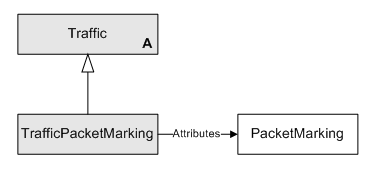
Description of "Figure 3-20 TrafficPacketMarking Object Diagram"
The TrafficGroup object has no additional attributes.
TrafficDomainName Object
A TrafficDomainName object represents a domain name-based traffic type, which classifies traffic by DNS Domain Name.
The TrafficDomainName object has the following object inheritance:
TrafficDomainName.Traffic.Object
See Figure 3-19 for the TrafficDomainName object diagram.
Table 3-41 describes the attributes for the TrafficDomainName object.
Table 3-41 TrafficDomainName Object Attributes
| Attribute Name | Type | Default | Access | Explanation |
|---|---|---|---|---|
|
DomainName |
String |
[no default] |
RO |
DNS Domain Name (partial match is allowed). |
TrafficVlan Object
A TrafficVlan object represents a VLAN-based traffic type that classifies network traffic on the basis of the Layer 2 VLAN identification number.
The TrafficVlan object has the following object inheritance:
TrafficVlan.Traffic.Object
See Figure 3-19 for the TrafficVlan object diagram.
Table 3-42 describes the attributes for the TrafficVlan object.
Table 3-42 TrafficVlan Object Attributes
| Attribute Name | Type | Default | Access | Explanation |
|---|---|---|---|---|
|
End |
U32 |
8 |
RCW |
End of the Vlan ID range. |
|
Start |
U32 |
5 |
RCW |
Start of the Vlan ID range. |
|
Name |
String |
"5-8" |
R |
Name of the Vlan ID range in the format of "Start-End". |
|
ID |
U32 |
13829 |
R |
TrafficInputInterface Object
A TrafficInputInterface object represents an input interface-based traffic type. This object classifies IP traffic based on the interface through which the packets enter.
The TrafficInputInterface object has the following object inheritance:
TrafficInputInterface.Traffic.Object
See Figure 3-19 for the TrafficInputInterface object diagram.
Table 3-43 describes the attributes for the TrafficInputInterface object.
Table 3-43 TrafficInputInterface Object Attributes
| Attribute Name | Type | Default | Access | Explanation |
|---|---|---|---|---|
|
InterfaceName |
String |
"Serial1/2" |
RCW |
Name of the input interface. |
|
Name |
String |
"InterfaceDemo" |
RC |
Name of the input interface traffic type. |
|
Remarks |
String |
[no default] |
RC |
Limit of 255 characters. |
|
ID |
U32 |
13836 |
R |
Rule Objects
A QoS or access control policy is implemented by creating and applying a set of rules. Generally, each rule consists of a set of conditions that, when true, result in a set of actions.
There rule objects in the EOM are:
-
RuleAccess: Represents an access rule, used to deny or permit access to the network for specific identified traffic.
-
RuleClassification: Represents a classification rule, used to classify, mark, and manage network traffic.
-
RuleGeneric: Represents a configuration policy, which allows the entry of either a set of raw XML commands, or an HTML-based entry form to collect information which is then converted to XML. The XML commands are passed to the Network Processor.
-
RulePolicing: Represents a policing rule, used to classify traffic, set bandwidth and burst requirements and define actions for conforming and exceeding traffic.
Rule Object (Abstract)
The abstract Rule object defines attributes common to all rule types.
The abstract Rule object has the following object inheritance:
Rule.Object
Figure 3-21 shows the Rule object diagram.
Table 3-44 describes the attributes for the Rule object.
Table 3-44 Rule Object Attributes
| Attribute Name | Type | Default | Access | Explanation |
|---|---|---|---|---|
|
Name |
String |
[no default] |
RW |
Name of the rule. |
|
Order |
U32 |
0 |
RW |
Rule Order. Indicates pre-requisites ordering for a set of rules. Lowest number (0) indicates highest order. If changed for one rule, all lower priority rules are renumbered. |
|
Disabled |
Boolean |
False |
RO |
True = rule is to be disabled at next propagate. False = rule is not to be disabled. |
|
InError |
Boolean |
False |
RO |
True = rule is currently failing. False= rule does not contain errors. |
|
Outbound |
Boolean |
Value depends on rule type |
RW |
True = rule is active on traffic outbound from an interface. False = rule is not active outbound. |
|
Inbound |
Boolean |
Value depends on rule type |
RW |
True = rule is active on traffic inbound to an interface False = rule is not active inbound. |
|
StartTime |
DateTime |
Now |
RW |
Start date/time - YYYY/MM/DD HH:MM:SS. |
|
EndTime |
DateTime |
2020/01/01 00:00:00 |
RW |
End date/time - YYYY/MM/DD HH:MM:SS. |
|
DaysOfWeek |
U32 |
127 (i.e. all days selected) |
RW |
Bitwise value, 1 bit per day of the week: Bit 0 = Monday Bit 1 = Tuesday Bit 2 = Wednesday Bit 3 = Thursday Bit 4 = Friday Bit 5 = Saturday Bit 6 = Sunday |
The attribute in Table 3-45 can be used to link directly to other objects in the EOM.
Table 3-45 Rule Object Direct Link Attribute
| Attribute Name | Type | Default | Access | Explanation |
|---|---|---|---|---|
|
PeriodName |
String |
Null |
RW |
Template name if global, otherwise empty string. Entering a global name links the rule to the Period and sets StartTime, EndTime and DaysOfWeek to Read Only. The global period objects must be linked to the domain to be found. |
RuleAccess Object
A RuleAccess object represents an access rule. Access rules are used to provide security by denying or permitting access to the network for specific identified traffic.
The RuleAccess object has the following object inheritance:
RuleAccess.Rule.Object
A RuleAccess object is defined in terms of the following conditions and actions:
Conditions:
-
Classifications: One or more Classification objects defining the traffic the rule applies to in terms of source address/mask, destination address/mask and traffic type.
-
Date and time: Identified by Period
-
Direction: Identified by Outbound and Inbound attributes
Actions:
Permit or deny access to traffic matching the conditions.
Figure 3-22 shows the RuleAccess object diagram.
Table 3-46 describes the attributes for the RuleAccess object.
Table 3-46 RuleAccess Object Attributes
| Attribute Name | Type | Default | Access | Explanation |
|---|---|---|---|---|
|
Permit |
Boolean |
True |
RCW |
Permit or Deny traffic; list is searched until match occurs. True=Explicit permit, stop searching ordered list. False=Deny. |
|
IsNamedAcl |
Boolean |
False |
RCW |
Specify if the access rule will be implemented as a named ACL. If set to false, the access rule will be implemented as a numbered ACL. |
|
Ipv4AclName |
String |
[no default] |
RCW |
Name of the IPv4ACL implemented for this access rule. If left empty, the system generates the name. |
|
Ipv6AclName |
String |
[no default] |
RCW |
Name of the IPv6ACL implemented for this access rule. If left empty, the system generates the name. |
|
AclNumber |
U32 |
168 |
RCW |
Number of the ACL implemented for this access rule. 0 means <Generate> a number. |
|
ManagementOverride |
Boolean |
False |
RCW |
To avoid automatic creation of ACL rules. ACL rules are automatically generated to assure SNMP and Telnet access from IP Service Activator to the CE. |
|
Log |
Boolean |
False |
RCW |
Enables / Disables Cisco ACL logging. Headers of packets affected by the access rule are stored in the routing engine and can be displayed using a show log command. Note: Enabling ACL logging may negatively affect router performance:
|
|
Disabled |
Boolean |
False |
RCW |
When selected, it switches off the rule. |
|
Fragments |
Boolean |
False |
RCW |
When checked, non-initial packet fragments are included for matching. (This relates to the fragments parameter in Cisco ACL statements). |
|
Inbound |
Boolean |
True |
RCW |
Applies to inbound traffic. |
|
InError |
Boolean |
False |
RO |
True = rule is currently failing. False= rule does not contain errors. |
|
Name |
String |
"LinkingRuletoNetwork" |
RCW |
Identifying name of the access rule. |
|
Outbound |
Boolean |
False |
RCW |
Applies to outbound traffic. |
|
Order |
U32 |
0 |
RCW |
Rule Order. Indicates pre-requisites ordering for a set of rules. Lowest number (0) indicates highest order. If changed for one rule, all lower priority rules are renumbered. |
|
DaysOfWeek |
U32 |
127 |
RCW |
Bitwise value, 1 bit per day of the week: Bit 0 = Monday Bit 1 = Tuesday Bit 2 = Wednesday Bit 3 = Thursday Bit 4 = Friday Bit 5 = Saturday Bit 6 = Sunday |
|
EndTime |
Date |
2020/01/01 00:00:00 |
RCW |
End date/time - YYYY/MM/DD HH:MM:SS. |
|
PeriodName |
String |
[no default] |
RCW |
Template name if global, otherwise empty string. Entering a global name links the rule to the Period and sets StartTime, EndTime and DaysOfWeek to Read Only. The global period objects must be linked to the domain to be found. |
|
StartTime |
Date |
2008/10/20 05:34:49 |
RCW |
Start date/time - YYYY/MM/DD HH:MM:SS. |
|
ID |
U32 |
6355 |
RO |
Internal ID number of this object; allocated automatically by IP Service Activator. |
RuleClassification Object
A RuleClassification object represents a classification rule. Classification rules are used to classify traffic and mark and/or shape traffic.
The RuleClassification object has the following object inheritance:
RuleClassification.Rule.Object
A RuleClassification object is defined in terms of the following conditions and actions:
Conditions:
-
Classifications: One or more Classification objects defining the traffic the rule should apply to in terms of source address/mask, destination address/mask and traffic type.
-
Date and time: Identified by Period
-
Direction: Identified by Outbound and Inbound attributes
Actions:
-
Mark IP packets with DiffServ codepoint, IP Precedence value or MPLS experimental value.
-
Apply a maximum bandwidth, if possible (not used at present)
-
Apply a guaranteed minimum bandwidth (not used at present).
Figure 3-23 shows the RuleClassification object diagram.
Figure 3-23 RuleClassification Object Diagram
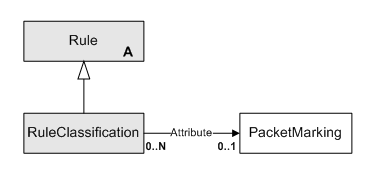
Description of "Figure 3-23 RuleClassification Object Diagram"
Table 3-47 describes the attributes for the RuleClassification object.
Table 3-47 RuleClassification Object Attributes
| Attribute Name | Type | Default | Access | Explanation |
|---|---|---|---|---|
|
BandwidthGuaranteed |
U32 |
0 |
RCW |
Bandwidth level guaranteed for the traffic (in Kbits/s). Must be >= BandwidthLimit, if set. 0 indicates no guarantee. |
|
BandwidthLimit |
U32 |
4294967295 |
RCW |
Maximum bandwidth that can be allocated to traffic (in Kbits/s). Must be <= BandwidthGuaranteed, if set. –1 indicates no limit. |
|
MarkingType |
Enum |
DSCodepointValue |
RO |
Marking to be applied 0 = DsCodepoint 1 = MplsExperimental |
|
MarkingValue |
U32 |
0 |
RO |
This value depends on the Marking Type, and defines how to mark matching traffic. Value restricted to 0–255. |
|
Disabled |
Boolean |
False |
RCW |
When selected, it switches off the rule. |
|
Inbound |
Boolean |
False |
RCW |
Applies to inbound traffic. |
|
InError |
Boolean |
False |
RO |
True = rule is currently failing. False= rule does not contain errors. |
|
Name |
String |
"RuleClassify" |
RCW |
Name of DiffServ codepoint or MPLS experimental bit with which packets are to be marked. The combo box lists all packet markings that have been set up in IP Service Activator. Where supported, packets can be marked using:
|
|
Outbound |
Boolean |
True |
RCW |
Applies to outbound traffic. |
|
Order |
U32 |
0 |
RCW |
Rule Order. Indicates pre-requisites ordering for a set of rules. Lowest number (0) indicates highest order. If changed for one rule, all lower priority rules are renumbered. |
|
DaysOfWeek |
U32 |
127 |
RCW |
Bitwise value, 1 bit per day of the week: Bit 0 = Monday Bit 1 = Tuesday Bit 2 = Wednesday Bit 3 = Thursday Bit 4 = Friday Bit 5 = Saturday Bit 6 = Sunday |
|
EndTime |
Date |
2020/01/01 00:00:00 |
RCW |
End date/time - YYYY/MM/DD HH:MM:SS. |
|
PeriodName |
String |
[no default] |
RCW |
Template name if global, otherwise empty string. Entering a global name links the rule to the Period and sets StartTime, EndTime and DaysOfWeek to Read Only. The global period objects must be linked to the domain to be found. |
|
StartTime |
Date |
2008/10/20 05:34:49 |
RCW |
Start date/time - YYYY/MM/DD HH:MM:SS. |
|
Id |
U32 |
6366 |
RO |
Internal ID number of this object; allocated automatically by IP Service Activator. |
The attribute in Table 3-48 can be used to link directly to other objects in the EOM
Table 3-48 RuleClassification Object Direct Link Attribute
| Attribute Name | Type | Default | Access | Explanation |
|---|---|---|---|---|
|
PacketMarkingName |
String |
[no default] |
RW |
Name of the PacketMarking object to use to mark packets. |
RuleGeneric Object
A RuleGeneric object represents a configuration policy, which allows the entry of either a set of raw XML commands, or an HTML-based entry form to collect information which is then converted to XML. The XML commands are passed to the Network Processor.
The RuleGeneric object has the following object inheritance:
RuleGeneric.Rule.Object
You can also specify the ContentValue of a RuleGeneric object as a filename. The filename must be an absolute and complete path ending with ".xml" extension. The file itself can be xml or multi-line. The file contents and namespace are not validated.
Figure 3-24 shows the RuleGeneric object diagram.
Table 3-49 describes the attributes for the RuleGeneric object.
Table 3-49 RuleGeneric Object Attributes
| Attribute Name | Type | Default | Access | Explanation |
|---|---|---|---|---|
|
ContentType |
String |
[no default] |
RCW |
Configuration policy type. |
|
ContentValue |
String |
[no default] |
RCW |
XML content of the configuration policy. |
|
Disabled |
Boolean |
False |
RCW |
If True, no concrete will be created. |
|
Name |
String |
[no default] |
RCW |
Name of the configuration policy. |
|
DontCascadeTargets |
Boolean |
True |
RC |
Should this policy create concretes at the point of application and on all child Configuration Targets (if set to false) or only on the specific Configuration Target that it is linked to (if set to true)? |
|
Inbound |
Boolean |
False |
RCW |
Configuration policy applies to incoming traffic. True = Configuration policy is active on traffic inbound to an interface False = Configuration policy is not active inbound |
|
InError |
Boolean |
False |
RO |
True = Configuration policy is currently failing False = Configuration policy does not contain errors |
|
Outbound |
Boolean |
True |
RCW |
Configuration policy applies to outbound traffic. True = Configuration policy is active on traffic outbound from an interface False = Configuration policy is not active outbound |
|
Order |
U32 |
0 |
RCW |
Configuration policy Order. |
|
DaysOfWeek |
U32 |
127 |
RCW |
Bitwise value, 1 bit per day of the week: Bit 0 = Monday Bit 1 = Tuesday Bit 2 = Wednesday Bit 3 = Thursday Bit 4 = Friday Bit 5 = Saturday Bit 6 = Sunday |
|
EndTime |
Date |
2020/01/01 00:00:00 |
RCW |
End date/time - YYYY/MM/DD HH:MM:SS. |
|
PeriodName |
String |
[no default] |
RCW |
Template name if global, otherwise empty string. Entering a global name links the rule to the Period and sets StartTime, EndTime and DaysOfWeek to Read Only. The global period objects must be linked to the domain to be found. |
|
StartTime |
Date |
Now |
RCW |
Start date/time - YYYY/MM/DD HH:MM:SS. |
|
Id |
U32 |
RO |
Internal ID number of this object; allocated automatically by IP Service Activator. |
|
|
DeviceLevelPolicy |
Boolean |
False |
RCW |
True = Configuration policy is applied to a device. False = Configuration policy is applied to an interface. Note: If true, on the Role page you can select only a device role and the interface role is not available. |
Policy Type Object
The Policy Type object holds information regarding the creation of RuleGeneric objects. Policy Type objects act as templates for Rule Generic Object. They contain the HTML text that is used to populate the forms for a Generic Rule.
Figure 3-25 shows the Policy Type object diagram.
Table 3-50 describes the attributes for the Policy Type object.
Table 3-50 Policy Type Object Attributes
| Attribute Name | Type | Default | Access | Explanation |
|---|---|---|---|---|
|
Name |
String |
[no default] |
RW |
Name of the policy type. |
|
Category |
Enum |
Interface, Service, and Unclassified |
RW |
Configures the category of the policy type. |
|
Type |
String |
[no default] |
RW |
Configures the type of policy |
|
Remarks |
String |
[no default] |
RW |
Description of the type of policy. Limit of 255 characters. |
|
HtmlPage |
String |
[no default] |
RW |
Imported HTML to be used for data entry. |
|
Schema |
String |
[no default] |
RW |
The schema for which the XML is validated. |
|
Disabled |
Boolean |
False |
RW |
Specify if the policy type is disabled. |
|
Visible |
Boolean |
True |
RW |
Specify if the policy type is visible in the IP Service Activator GUI. |
Policy Type Folder Object
The Policy Type Folder object categorizes policy types within the Object Model. A Policy Type must be located in a Policy Type Folder. These folders can also create a hierarchy of Policy Types and Policy Type Folders. Each Policy Type folder can have either a Policy Type Folder or a Policy Type as parent. Only those Policy Types, that have a matching Category Type, can reside under the folder of a particular category.
Table 3-51 describes the attributes for the Policy Type Folder object.
Table 3-51 Policy Type Folder Object Attributes
| Attribute Name | Type | Default | Access | Explanation |
|---|---|---|---|---|
|
Name |
String |
RCW |
Name of the configuration policy folder. |
|
|
Remark |
String |
RCW |
Remarks for this configuration policy folder. Limit of 255 characters. |
|
|
Category |
Enum |
Interface, Service, and Unclassified |
RCW |
Category of the configuration policy folder. |
RulePolicing Object
A policing rule is used to police identified traffic between a defined source and destination point. A rule defines the bandwidth and burst requirements for a given traffic type, between a source and destination, and the action to be taken if traffic conforms to or exceeds the requirements.
The RulePolicing object has the following object inheritance:
RulePolicing.Rule.Object
A Policing Rule is defined in terms of the following conditions and actions:
Conditions
-
Classifications: One or more Classification objects defining the traffic the rule should apply to in terms of source address/mask, destination address/mask and traffic type.
-
Date and time: Identified by Period
-
Direction: Identified by Outbound and Inbound attributes
Actions
-
Set CAR parameters: Committed Rate, Normal Burst Size and Excess Burst Size.
-
Traffic that conforms to or exceeds a specified bandwidth can be dropped, transmitted, or allowed to continue. In addition, you can choose to re-mark both conforming and exceeding traffic with a different packet marking.
For example,. the following command specifies that conforming traffic is to be transmitted and exceeding traffic is to be re-marked to Bronze:
Modify ConformAction="Transmit" ExceedAction="TransmitAndRemark" ExceedPacketMarking="Bronze"
If the actions are Drop or Transmit, then the corresponding packet marking has no effect and may be set to anything (including "").
Figure 3-26 shows the RulePolicing object diagram.
Table 3-52 describes the attributes for the RulePolicing object.
Table 3-52 RulePolicing Object Attributes
| Attribute Name | Type | Default | Access | Explanation |
|---|---|---|---|---|
|
CommittedRate |
U32 |
8000 |
RCW |
CAR committed rate (bits per second). |
|
NormalBurstSize |
U32 |
1000 |
RCW |
CAR normal burst size (bytes). |
|
ExcessBurstSize |
U32 |
2000 |
RCW |
CAR excess burst size (bytes). |
|
ExceedAction |
Enum |
Transmit |
RW |
Action taken when traffic exceeds specified bandwidth. 1 = Drop 2 = Transmit 10 = TransmitAndRemark 12 = RemarkAndContinue |
|
ConformAction |
Enum |
Transmit |
RCW |
Action taken when traffic conforms to specified bandwidth. 1 = Drop 2 = Transmit 10 = TransmitAndRemark 12 = RemarkAndContinue |
|
AclNumber |
U32 |
0 |
RCW |
ACL number to be used for CAR policing. 0=Driver chooses. Valid values if user-specified are 100–199 and 2000–2699. |
|
ConformPacketMarking |
String |
"" |
RCW |
Name of PacketMarking object used to remark conforming packet will be remarked as if ConformAction is TransmitAndRemark or RemarkAndContinue. |
|
ExceedPacketMarking |
String |
"" |
RCW |
Name of PacketMarking object used to remark exceeding packets if ExceedAction is TransmitAndRemark or RemarkAndContinue. |
|
Disabled |
Boolean |
False |
RCW |
The rule is switched off when Disabled is selected. |
|
ExceedAction |
Enum |
Transmit |
RCW |
Specifies the action to be taken when traffic exceeds the agreed bandwidth level. |
|
Inbound |
Boolean |
False |
RCW |
Check box indicating the traffic direction to which the rule applies. It is 'in' in this case. |
|
InError |
Boolean |
False |
RO |
|
|
Name |
String |
"SimpleTest" |
RCW |
Identifying name of the policing rule. |
|
Outbound |
Boolean |
True |
RCW |
Checkbox indicating the traffic direction to which the rule applies. It is 'out' in this case. |
|
Order |
U32 |
0 |
RCW |
|
|
DaysOfWeek |
U32 |
127 |
RCW |
|
|
EndTime |
Date |
2020/01/01 00:00:00 |
RCW |
|
|
PeriodName |
String |
"" |
RCW |
|
|
StartTime |
Date |
2008/10/21 05:59:16 |
RCW |
|
|
ID |
U32 |
11503 |
RO |
Internal ID number of this object. It is allocated automatically by the system. |
ExceedPacketMarking and ConformPacketMarking are Link by Attribute attributes which take names of other objects.
Period Object
A Period object identifies the particular dates, times and/or days of the week when a rule is to apply. It can be a one-off period or a repeating time period. The period object can either be a globally-named template or a specific local definition of a date/time period.
The Period object has the following object inheritance:
Period.Object
The Period specifies (possibly contiguous) recurring spans of time of not more than 24 hours. Each span is the same length. The first span starts at the specified StartTime. The last span finishes at the specified EndTime. After the first span, subsequent spans start exactly 24 hours after the preceding one started. The length of the span is calculated such that the last span will end at the specified EndTime. Spans whose start day of the week in UTC corresponds to a zero bit in DaysOfWeek are dropped.
Figure 3-27 shows the Period object diagram.
Table 3-53 describes the attributes for the Period object.
Table 3-53 Period Object Attributes
| Attribute Name | Type | Default | Access | Explanation |
|---|---|---|---|---|
|
Name |
String |
"" |
RO |
Template name if global, otherwise NULL. |
|
StartTime |
DateTime |
Now |
RO |
Start date/time - YYYY/MM/DD HH:MM:SS. |
|
EndTime |
DateTime |
2020/01/01 00:00:00 |
RO |
End date/time - YYYY/MM/DD HH:MM:SS. |
|
DaysOfWeek |
U32 |
127 (i.e. all days selected) |
RO |
Bitwise value, 1 bit per day: Bit 0 = Monday Bit 1 = Tuesday Bit 2 = Wednesday Bit 3 = Thursday Bit 4 = Friday Bit 5 = Saturday Bit 6 = Sunday |
Classification Objects
This section describes the classification objects.
ClassificationBase Object (Abstract)
The ClassificationBase object represents one or many combinations of source addresses and masks, destination addresses and masks and traffic types.
The abstract ClassificationBase object has the following object inheritance:
ClassificationBase.Object
Figure 3-28 shows the ClassificationBase object diagram.
Figure 3-28 ClassificationBase Object Diagram
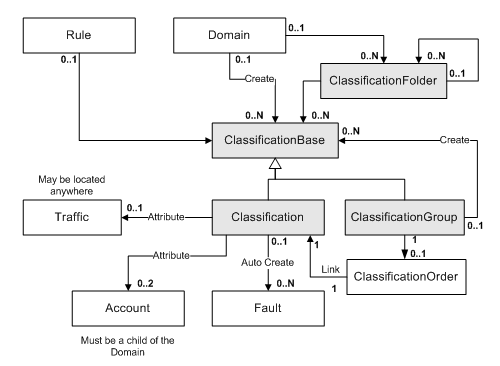
Description of "Figure 3-28 ClassificationBase Object Diagram"
Table 3-54 describes the attributes for the ClassificationBase object.
Table 3-54 ClassificationBase Object Attributes
| Attribute Name | Type | Default | Access | Explanation |
|---|---|---|---|---|
|
Name |
String |
0 |
RW |
Name of the classification object. |
|
Remarks |
String |
"" |
RW |
Optional additional comments. Limit of 255 characters. |
ClassificationGroup Object
The ClassificationGroup object is a composite to allow the aggregation of other Classification objects that are commonly used together. A ClassificationGroup object is a child of either a Domain or a ClassificationFolder object, but not both.
The ClassificationGroup object has the following object inheritance:
ClassificationGroup.ClassificationBase.Object
See Figure 3-28 for the ClassificationGroup object diagram.
Table 3-55 describes the attributes for the ClassificationGroup object.
Table 3-55 ClassificationGroup Object Attributes
| Attribute Name | Type | Default | Access | Explanation |
|---|---|---|---|---|
|
Aggregate |
Boolean |
True |
RW |
True if match statements are to be aggregated, otherwise False. Only relevant where the classification is associated with an MQC PHB group via a CoS. |
|
MatchType |
Enum |
0 |
RW |
Specifies how traffic is matched: 0 = MatchAny 1 = MatchAll Only relevant where the classification is associated with an MQC PHB group via a CoS. |
|
AclIdType |
Enum |
2 |
RW |
Defines how ACL identifiers are generated: 0 = AutoGenerate 1 = Numbered 2 = Named Only relevant where the classification is associated with an MQC PHB group via a CoS. |
|
AclName |
String |
Name |
RW |
Name of the ACL to use. Only relevant where the classification is associated with an MQC PHB group via a CoS. |
|
AclNumber |
U32 |
0 |
RW |
The ACL Number to use. Only relevant where the classification is associated with an MQC PHB group via a CoS. |
ClassificationOrder
The ClassificationOrder re-orders the classifications in the group.
The sequence of Classification objects displayed within a Classification Group reflects the order of evaluation. The first Classification in a group matching a packet directs QoS operations on that packet. After the first match, all following Classifications are ignored.
Table 3-56 describes the attributes for ClassificationOrder.
Table 3-56 ClassificationOrder Attributes
| Attribute Name | Type | Default | Access | Explanation |
|---|---|---|---|---|
|
orderNumber |
U32 |
0 |
RW |
Relative ordering of a Classification with respect to a parent ClassificationGroup. 0 - 0xFFFFFFFF, default: 0. |
|
Name |
String |
ClassificationOrder |
RO |
Name assigned to the Classification Order. |
|
Id |
U32 |
RO |
Unique ID assigned to the Classification Order. |
Classification object
Classification Object
The Classification object represents a unique combination of Source Address and Mask, Destination Address and Mask and Traffic Type. A Classification object is a child of either a Domain or a ClassificationFolder object, but not both.
The Classification object has the following object inheritance:
Classification.ClassificationBase.Object
See Figure 3-28 for the Classification object diagram.
Table 3-57 describes the attributes for the Classification object.
Table 3-57 Classification Object Attributes
| Attribute Name | Type | Default | Access | Explanation |
|---|---|---|---|---|
|
SourceIpAddr |
IPAddress |
0.0.0.0 |
RW |
IPv4 host or network address to identify traffic source. 0.0.0.0/Mask 0 = Any Relevant when AddressType=IPv4 |
|
SourceMask |
IPAddress |
0.0.0.0 |
RW |
Network portion of IPv4 address to match. Relevant when AddressType=IPv4. |
|
DestinationIpAddr |
IPAddress |
0.0.0.0 |
RW |
IPv4 network or host address to identify traffic destination. 0.0.0.0/Mask 0 = Any Relevant when AddressType=IPv4. |
|
DestinationMask |
IPAddress |
0.0.0.0 |
RW |
Network portion of IPv4 address to match. Relevant when AddressType=IPv4 |
|
Aggregate |
Boolean |
True |
RW |
True if match statements are to be aggregated, otherwise False. Only relevant where the classification is associated with an MQC PHB group via a CoS. |
|
MatchType |
Enum |
0 |
RW |
Specifies how traffic is matched against classifications: 0 = Any 1 = All Only relevant where the classification is associated with an MQC PHB group via a CoS. |
|
AclIdType |
Enum |
2 |
RW |
Defines how ACL identifiers are generated: 0 = AutoGenerate 1 = Numbered 2 = Named Only relevant where the classification is associated with an MQC PHB group via a CoS. |
|
AclName |
String |
Name |
RW |
Name of the ACL to use. Only relevant where the classification is associated with an MQC PHB group via a CoS. |
|
AclNumber |
U32 |
0 |
RW |
The ACL Number to use. Only relevant where the classification is associated with an MQC PHB group via a CoS. |
|
AddressType |
Enum |
IPv4 |
RW |
Selection of address type. Values are: 0 = IPv4 1 = MAC 2 = IPv6 |
|
SourceIpv6Addr |
String |
::/0 |
RW |
IPv6 network or host address to identify traffic source. ::/0 = Any Relevant when AddressType=IPv6 |
|
DestinationIpv6Addr |
String |
::/0 |
RW |
IPv6 network or host address to identify traffic destination. ::/0 = Any Relevant when AddressType=IPv6. |
|
ClassificationMatch |
Boolean |
TRUE |
RW |
Whether traffic that matches the specified criteria in the classifier is explicitly included in the processing applied to the classifier or if it is excluded. (corresponds to permit or deny in Cisco ACLs) |
|
SourceMacAddr |
String |
RW |
Identifies the source MAC address by which traffic will be classified. |
|
|
SourceMacMask |
String |
RW |
Identifies the source MAC mask by which traffic will be classified. |
|
|
DestinationMacAddr |
String |
RW |
Identifies the destination MAC address by which traffic will be classified. |
|
|
DestinationMacMask |
String |
RW |
Identifies the destination MAC mask by which traffic will be classified. |
|
|
Fragments |
Boolean |
TRUE |
RW |
When checked, non-initial packet fragments are included for matching. (This relates to the fragments parameter in Cisco ACL statements.) |
|
Log |
Boolean |
TRUE |
RW |
Enables / Disables Cisco ACL logging. Headers of packets affected by the access rule are stored in the routing engine and can be displayed using a show log command. Note: Enabling ACL logging may negatively affect router performance: · processor power may be used to perform the logging · log files may impact available disk space |
The attributes in Table 3-58 can be used to link directly to other objects in the EOM.
Table 3-58 Classification Object Direct Link Attributes
| Attribute Name | Type | Default | Access | Explanation |
|---|---|---|---|---|
|
SrcAccountName |
String |
"" |
RW |
Name of an account to use as source instead of the SourceIpAddress and SourceMask. |
|
DstAccountName |
String |
"" |
RW |
Name of an account to use as destination instead of the DestinationIpAddr and DestinationMask. |
|
TrafficName |
String |
"" |
RW |
The name of the traffic object. The traffic object specified may be anywhere in the hierarchy. Note: Cannot be a TrafficGroup object. |
ClassificationFolder Object
The ClassificationFolder object defines a classification folder, used to contain classification objects, classification group objects, and classification subfolders. A classification folder can be a child of the Domain, or a child of another ClassificationFolder object.
The ClassificationFolderObject has the following object inheritance:
ClassificationFolder.ClassificationBase.Object
See Figure 3-28 for the ClassificationFolder object diagram.
Table 3-59 describes the attributes for the ClassificationFolder object.
Table 3-59 ClassificationFolder Object Attributes
| Attribute Name | Type | Default | Access | Explanation |
|---|---|---|---|---|
|
Name |
String |
"" |
RW |
Name of the Classification folder. |
|
Remarks |
String |
"" |
RW |
Optional additional comments. Limit of 255 characters. |
PHBGroup Objects
This section describes PHBGroup objects.
PHBGroup Object
The PHBGroup object represents a PHB group (an implementation of a specific queuing/shaping mechanism available at an interface).
The PHBGroup object has the following object inheritance:
PHBGroup.Object
Note:
Oracle Communications cannot guarantee compatibility of PHBGroup objects between different releases of IP Service Activator, unlike most other object types. We therefore strongly recommend that any client software you create encapsulates the data manipulated for PHBGroup objects. This ensures a maintainable code base and minimizes the effect of future changes.
The PHBGroup object is a resource-intensive object and we strongly recommend that you create only a limited number. Each PHBGroup object may be used by multiple PHBGroupInstance objects, effectively acting as a template.
Figure 3-29 shows the PHBGroup object diagram.
Table 3-60 describes the attributes for the PHBGroup object.
Table 3-60 PHBGroup Object Attributes
| Attribute Name | Type | Default | Access | Explanation |
|---|---|---|---|---|
|
Name |
String |
0 |
RW |
Name of the object. |
|
Description |
String |
RW |
Text entered here is configured as a policy-map description on the device. This behavior is turned off by default. To use this feature, it must be turned on in the capabilities files. |
|
|
ConfiguredName |
String |
Value in the Name field |
RW |
Name of the configured PHB Group on the device |
|
Inbound |
Boolean |
False |
RW |
True = PHB Group applies to inbound traffic on an interface. |
|
Outbound |
Boolean |
False |
RW |
True = PHB group applies to outbound traffic on an interface. |
|
Conflict |
Boolean |
False |
RO |
Indicates that this PHB Group is in conflict. |
|
Weight |
U32 |
9 |
RW |
Weight Factor. |
|
ECN |
Boolean |
False |
RW |
Modifies WRED performance by marking packets with ECT and ECN bits in the IP header, when congestion occurs in the network. |
|
Action |
U32 |
384 |
RW |
Bitwise value indicating the queuing mechanism or traffic shaping mechanism to apply: 1 = PQ 2 = TS 4 = WFQ 8 = WRED 16 = WRR 32 = FRTS 64 = ATMQoS 128 = Default WFQ settings 256 = Default WRED settings Add bit values together to combine queuing mechanisms. For example, a value of 384 indicates Default WFQ (128) and Default WRED (256); a value of 3 indicates PQ (1) and TS (2). |
|
WfqAsPercent |
Boolean |
False |
RW |
Use WFQ value as a percentage |
|
ThresholdUnit |
Enum |
Default |
RCW |
Unit for Random detect threshold. Valid values are default,bytes and milliseconds. |
PHBGroupFolder Object
A PHBGroupFolder object represents a folder which contains PHBGroup objects, or other PHBGroupFolder objects, for purposes of organization within the GUI.
The PHBGroupFolder object has the following object inheritance:
PHBGroupFolder.Object
Figure 3-30 shows the PHBGroupFolder object diagram.
A PHBGroup always has either 1 or 2 parents and is always linked to its parent Domain. It may be linked to zero or one parent PHBGroupFolders. In the IP Service Activator GUI, if a PHBGroup has 2 parents, it will always be displayed under the PHBGroupFolder, not under the PHB Groups folder. If a PHBGroup is created under a folder, it is automatically linked to its parent Domain.
A PHBGroupFolder is a child of either another PHBGroupFolder or the Domain, but not both.
Table 3-61 describes the attributes for the PHBGroupFolder object.
Table 3-61 PHBGroupFolder Object Attributes
| Attribute Name | Type | Default | Access | Explanation |
|---|---|---|---|---|
|
Name |
String |
"" |
RW |
Name of the PHBGroup folder. |
|
Remarks |
String |
"" |
RW |
Optional additional comments. Limit of 255 characters. |
PHBGroupInstance Object
The PHBGroupInstance object represents a particular instance of a PHB group. It includes all the attributes of the domain level PHBGroup template and adds the ability to order them, allowing you to define the precedence in case of multiple PHB groups applied at one level.
The PHBGroupInstance object has the following object inheritance:
PHBGroupInstance.PHBGroup.Object
A PHBGroupInstance is created by the use command. If a PHBGroup is used on one of the PHBGroupInstance possible parents, then a PHBGroupInstance will automatically be created as a child of both the PHBGroup and the other object. For more information, see "The Use Command".
See Figure 3-30 for the PHBGroupInstance object diagram.
All the attributes of the corresponding PHBGroup are included in this object (see Table 3-60). In addition, it defines the new attributes described in Table 3-62.
Table 3-62 PHBGroupInstance Object Attributes
| Attribute Name | Type | Default | Access | Explanation |
|---|---|---|---|---|
|
Order |
U32 |
0 |
RW |
Order of this PHB group at the local level. |
|
Name |
String |
RO |
The name of the PHB group object that this is an instance of. |
PHB Object
The PHB object represents the application of a specific queuing mechanism to a class of service.
Note:
The attributes associated with the WFQ queuing mechanism are Read Only in the PHB object. If you wish to configure WFQ, you must use an MQC PHB group. For more information, see "PHBGroupMqc Objects".
See Figure 3-30 for the PHB object diagram.
Table 3-63 describes the attributes for the PHB object.
Table 3-63 PHB Object Attributes
| Attribute Name | Type | Default | Access | Explanation |
|---|---|---|---|---|
|
Name |
String |
0 |
RO |
Name of the object. The OIM automatically assigns the value assigned to the object's ClassName attribute. |
|
ID |
U32 |
RO |
Unique ID used to reference this object. |
|
|
Order |
U32 |
0 |
RCW |
Order of this object, compared to other PHB objects. |
The attribute in Table 3-64 can be used to link directly to a Cos object in the EOM.
Table 3-64 PHB Object Direct Link Attributes
| Attribute Name | Type | Default | Access | Explanation |
|---|---|---|---|---|
|
ClassName |
String |
"" |
RCW |
Name of the CoS object to match. |
Table 3-65 describes the attributes for the WFQ queuing mechanism.
Table 3-65 WFQ Queuing Mechanism Attributes
| Attribute Name | Type | Default | Access | Explanation |
|---|---|---|---|---|
|
Weight |
U32 |
100 |
RCW |
WFQ weighting to be allocated to CoS. |
|
QueuePriority |
Enum |
0 |
RCW |
Priority of this queue. Values: 0 = Low (None) 1 = High (Requested) |
|
DropStrategy |
Enum |
0 |
RCW |
Values: 0 = None 1 = DefaultWred 2 = WRED 3 = TailDrop |
|
Limit |
U32 |
20 |
RCW |
Packet Limit - set if DropStrategy = TailDrop |
|
SetDe |
Boolean |
False |
RCW |
True = set the Frame Relay DE bit. |
|
WeightFactor |
U32 |
9 |
RCW |
Specifies an exponent weight factor used in calculating the average queue length. Range = 1-16 |
|
LimitUnit |
Enum |
Default |
RCW |
Unit for QueueLimit. Valid values are default, cells, microseconds, milliseconds, packets, and bytes. |
|
WredAggregate |
Boolean |
False |
RCW |
True enables Weighted Random Early Detection (WRED) aggregate mode. |
Table 3-66 describes the attributes for Priority Queuing.
Table 3-66 Priority Queuing Attributes
| Attribute Name | Type | Default | Access | Explanation |
|---|---|---|---|---|
|
Priority |
Enum |
2 |
RCW |
0 = High 1 = Medium 2 = Normal 3 = Low |
Table 3-67 describes the attributes for Rate Limiting.
Table 3-67 Rate Limiting (Traffic Shaping) Attributes
| Attribute Name | Type | Default | Access | Explanation |
|---|---|---|---|---|
|
AverageRate |
U32 |
100 |
RCW |
Transmission rate in Kbits/s for the selected class of service. |
|
BurstRate |
U32 |
150 |
RCW |
Transmission burst rate in Kbits/s for the selected class of service. |
|
BurstInterval |
U32 |
10 |
RCW |
Interval, in seconds, over which traffic in the selected class of service is allowed to maintain its maximum burst. |
Table 3-68 describes the attributes for Weighted Round Robin (WRR) queuing.
Table 3-68 WRR Queuing Attributes
| Attribute Name | Type | Default | Access | Explanation |
|---|---|---|---|---|
|
Bandwidth |
U32 |
2500 |
RCW |
Bandwidth weighting for this class of service. |
|
PacketLimit |
U32 |
20 |
RCW |
Packet Limit. |
PHBAtm Object
The PHBAtm object represents the application of an ATM traffic shaping mechanism to a VC endpoint.
See Figure 3-30 for the PHBAtm object diagram.
Table 3-69 describes the attributes for the PHBAtm object.
Table 3-69 PHBAtm Object Attributes
| Attribute Name | Type | Default | Access | Explanation |
|---|---|---|---|---|
|
Name |
String |
"PhbAtm" |
RO |
Identifier used to access the object. |
|
Type |
Enum |
0 |
RW |
Traffic shaping mechanism to apply: 0 = UBR 1 = CBR 2 = RtVBR 3 = NrtVBR 4 = ABR |
|
PCR |
U32 |
22500 |
RW |
Peak Cell Rate. Used in all service classes. Defined in bits/s. Range 1-45 000 000 |
|
SCR |
U32 |
22500 |
RW |
Sustainable Cell Rate. Used for VBR. Defined in bits/s. Range: 1–45 000 000 |
|
MBS |
U32 |
32700 |
RW |
Maximum Burst Size. Used for VBR. Specifies the largest burst of data above the ensured rate that will be allowed temporarily on the PVC. Range: 0–65535 |
|
MCR |
U32 |
22500 |
RW |
Minimum Cell Rate. Used for ABR. Specifies the minimum value for the ACR. Defined in bits/s. Range: 1–45 000 000. |
|
HoldQueueDepth |
U32 |
0 |
RW |
Maximum number of packets that can be stored in the traffic-shaping queue for an ATM PVC. Range: 5–1024. 0=device default. |
|
TransmitRingLimit |
U32 |
0 |
RW |
Allows the hardware queue depth to be configured. Range: 3–6000. 0=device default. |
|
VcClassName |
String |
RW |
VC class name. The maximum length of the name is 126 characters. |
|
|
HighWaterMark |
U32 |
0 |
RCW |
1-65535 |
|
LowWaterMark |
U32 |
0 |
RCW |
1-200 |
PHBFrts Object
The PHBFrts object represents the application of a Frame Relay traffic shaping mechanism to an interface.
See Figure 3-30 for the PHBFrts object diagram.
Table 3-70 describes the attributes for the PHBFrts object.
Table 3-70 PHBFrts Object Attributes
| Attribute Name | Type | Default | Access | Explanation |
|---|---|---|---|---|
|
Name |
String |
"PhbFrts" |
RO |
Identifier used to access the object. |
|
Shaping |
Boolean |
True |
RCW |
Indicates whether shaping is to be performed. |
|
CIR |
String |
56000 |
RCW |
Committed Information Rate (bits per second) Range: 1–45 000 000 |
|
CIR_In |
String |
56000 |
RCW |
Committed Information Rate (bits per second) applied as an inbound override for CIR Range: 1–45 000 000 |
|
CommittedBurst |
String |
56000 |
RCW |
Committed burst size (bits). Range: 1000– 160 000 000 |
|
CommittedBurst_in |
String |
56000 |
RCW |
Inbound override for Committed burst size (bits). Range: 1000– 160 000 000 |
|
ExcessBurst |
String |
0 |
RCW |
Excess burst size (bits) Range: 0–16 000 000 |
|
ExcessBurst_In |
String |
0 |
RCW |
Inbound override for excess burst size (bits) Range: 0–16 000 000 |
|
MinCIR |
String |
28000 |
RCW |
Minimum CIR (bits per second). Range: 1000–45 000 000 |
|
MinCIR_In |
String |
28000 |
RCW |
Minimum CIR (bits per second) applied as an inbound override for MinCIR. Range: 1000–45 000 000 |
|
BEC[no default]dapt |
Boolean |
True |
RCW |
True = adapt to Backward Explicit Congestion Notification flag. |
|
FEC[no default]dapt |
Boolean |
True |
RCW |
True = adapt to Forward Explicit Congestion Notification flag. |
|
FRF12Fragment |
Boolean |
True |
RCW |
True = Use FRF.12 fragmentation flag. |
|
FRF12Fragment Size |
U32 |
53 |
RCW |
FRF.12 fragment size (bytes). Range: 16–1600 |
|
HoldQueueDepth |
U32 |
0 |
RCW |
Maximum number of packets that can be stored in the traffic-shaping queue for a Frame Relay PVC. Range: 1–2048. 0 = device default. |
|
ID |
U32 |
22795 |
RO |
PHBWred Object
The PHBWred object represents the application of a WRED mechanism to an interface. It is created as a child of a PHB object automatically when the Class of Service that the PHB object represents has Packet Markings attached to it. One PHBWred object is created for each Packet Marking.
A default PHBWred object is created when the 'Default' drop strategy is selected.
See Figure 3-30 for the PHBWred object diagram.
Table 3-71 describes the attributes for the PHBWred object.
Table 3-71 PHBWred Object Attributes
| Attribute Name | Type | Default | Access | Explanation |
|---|---|---|---|---|
|
MaxDrop |
U32 |
10 |
RCW |
Minimum threshold value for packet discard for selected CoS. |
|
MinDrop |
U32 |
1 |
RCW |
Maximum threshold value for packet discard for selected CoS. |
|
Denominator |
U32 |
10 |
RCW |
Value for Drop probability. |
PHBGroupMqc Objects
This section describes the PHBGroupMqc objects.
PHBGroupMqc Object
The PHBGroupMqc object represents an MQC PHB group (the application of a queuing/shaping mechanism via Cisco's Modular QoS CLI).
The PHBGroupMqc object defines generic parameters. The PHBMqc object defines the specific MQC parameters to be applied to a particular CoS handled by an interface.
A PHBGroupMqc object may be linked to multiple PHBMqc objects.
When defining a PHBMqc object to apply congestion avoidance, the drop mechanism may be defined by a standard WRED PHB group.
Figure 3-31 shows the PHBGroupMqc object diagram.
Table 3-72 describes the attributes for the PHBGroupMqc object.
Table 3-72 PHBGroupMqc Object Attributes
| Attribute Name | Type | Default | Access | Explanation |
|---|---|---|---|---|
|
Name |
String |
0 |
RW |
Name of the object. |
|
ConfiguredName |
String |
Value in the Name field |
RW |
Name of the configured MQC PHB group on the device. |
|
Description |
String |
-- |
RW |
Text entered here is configured as a policy-map description on the device. This behavior is turned off by default. To use this feature, it must be turned on in the capabilities files. |
|
MaxReservedBandwidth |
U32 |
0 |
RW |
Cisco devices have a default maximum reserve bandwidth value of 75 percent that is designed to leave sufficient bandwidth for overhead traffic. Specify a new value if required. |
|
Inbound |
Boolean |
False |
RW |
True = Mechanism applies to incoming traffic. |
|
Outbound |
Boolean |
True |
RW |
True = Mechanism applies to outgoing traffic. |
|
Conflict |
Boolean |
False |
RO |
True = MQC PHB group is failing. False = MQC PHB group is not in error. |
|
LlqBandwidthType |
Enum |
0 |
RW |
Indicates how LLQ Bandwidth value is interpreted: 0 = Absolute 1 = Percentage 2 = PercentageRemaining 3 = Default 4 = Level |
|
WfqBandwidthType |
Enum |
0 |
RW |
Indicates how LLQ Bandwidth value is interpreted: 0 = Absolute 1 = Percentage 2 = PercentageRemaining |
|
CreateDefaultPhbMqc |
Boolean |
True |
RC |
Applies only when the PhbGroupMqc is created. If set to True, IP Service Activator automatically creates a child PhbMqc object named Default Class of Service for the PhbGroupMqc. If set to True, you must modify the PhbMqc named Default Class of Service to apply MQC parameters to the default class of service. If set to False, you must create one or more PhbMqc child objects for the newly created PhbGroupMqc. |
PHBMqc Object
The PHBMqc object represents the application of a specific MQC mechanism to a class of service.
See Figure 3-31 for the PHBMqc object diagram.
Table 3-73 describes the attributes for the PHBMqc object.
Table 3-73 PHBMqc Object Attributes
| Attribute Name | Type | Default | Access | Explanation |
|---|---|---|---|---|
|
Name |
String |
0 |
RO |
Name of the object. The OIM automatically assigns the value assigned to the object's CosName attribute. |
|
Order |
U32 |
0 |
RW |
Order of this object, compared to other PHBMqc objects. |
|
AggregatePolicer |
Boolean |
FALSE |
RW |
Set AggregatePolicer to true to activate aggregate policing. |
|
PolicerName |
String |
[no default] |
RW |
Specify the aggregate policer name when AggregatePolicer is true. |
|
PoliceRateType |
Enum |
Absolute |
RW |
The police rate can be specified in absolute terms (bits/second) or as a percentage of the total available bandwidth. Valid choices are: absolute, percent |
|
VipFairQueue |
Boolean |
FALSE |
RW |
When set to true, normal weighted fair queuing is selected for the CoS. |
|
VipFlowQueueLimit |
U32 |
0 |
RW |
Specifies queue limit in number of packets for fair-queuing. |
|
TrustMarking |
String |
0 |
RW |
This configures the trust state, which selects the value that QoS uses as the source of the internal DSCP value. |
|
CosName |
String |
0 |
RW |
Name of the Class of Service to be used. Note: This attribute can be used to link directly to a Cos object in the EOM. |
|
Action |
U21 |
0 |
RW |
A bitfield describing the MQC action(s) specified: 0 = None 1 = QueueLLQ 2 = QueueCBWFQ 4 = PoliceSingleRate 8 = PoliceTwoRate 16 = Shape 32 = Mark 64 = Congestion 128 = Nest 256 = RTP Compression 512 = Default WFQ |
|
Queue: LLQWeight |
U32 |
100 |
RW |
Treated as a percentage or an absolute value or a priority level depending on the value of the LlqBandwidthType attribute on the PhbGroupMqc object. If expressed as a percentage, the range is 1–100. If expressed as an absolute value, the range is 32–155 000 (Kbits/s) If expressed as a level, the range is 1 - 4. |
|
Queue: LLQBurst |
U32 |
0 |
RW |
Configures the LLQ to accommodate temporary bursts of traffic. Range: 32–2 000 000 bytes. 0 = device default. |
|
Queue: WFQWeight |
U32 |
100 |
RW |
Treated as a percentage or an absolute value depending on the value of the WfqBandwidthType attribute on the PhbGroupMqc object. If expressed as a percentage, the range is 1–100. If expressed as an absolute value, the range is 8–2 000 000 (Kbits/s) |
|
Queue: BandwidthOverheadAccounting |
Boolean |
False |
RCW |
True indicates that bandwidthoverheadaccounting is enabled. |
|
Queue: BandwidthOffset |
U32 |
2147483647 |
RCW |
Offset value for BandwidthOverheadAccounting. Valid values are from -63 to 63. |
|
Single Rate Policing: SR_CIR |
U32 |
8000 |
RW |
Committed information rate in bits/s. Range: 8000–4 000 000 000 |
|
Single Rate Policing: SR_CBS |
U32 |
1000 |
RW |
Committed burst size in bytes. Range: 1000–512 000 000 To load the device default value for SR_CBS, send the special value 4 294 967 295. |
|
Single Rate Policing: EBS |
U32 |
1000 |
RW |
Excess burst size in bytes. Range: 1000–512 000 000 Used only if ViolateAction is specified within Policing Action. To load the device default value for EBS, send the special value 4 294 967 295. |
|
Two Rage Policing: TR_CIR |
U32 |
8000 |
RW |
Committed information rate in bits/s. Range is 8000-4 000 000 000. |
|
Two Rage Policing: TR_CBS |
U32 |
1000 |
RW |
Committed burst size in bytes. Range is 1000–512 000 000. |
|
Two Rage Policing: PIR |
U32 |
8000 |
RW |
Peak information rate in bits/s. Range is 8000–4 000 000 000. |
|
Two Rage Policing: PBS |
U32 |
8000 |
RW |
Peak burst size in bytes. Range is 1000–512 000 000. |
|
Policing Action: ConformAction |
String |
[no default] |
RW |
Name of a PolicingAction object used to define the action to perform on conforming traffic. |
|
Policing Action: ExceedAction |
String |
[no default] |
RW |
Name of a PolicingAction object used to define the action to perform on exceeding traffic. |
|
Policing Action: ViolateAction |
String |
[no default] |
RW |
Name of a PolicingAction object used to define the action to perform on violating traffic. |
|
Shaping: BasicShaping |
Boolean |
False |
RW |
True = When selected, applies basic traffic shaping based on the CIR value only. Applies to Cisco 10000 devices only. |
|
Shaping: Shape_CIR |
U32 |
56000 |
RW |
CIR in bits/s. Range is 8000–154 400 000, must be a multiple of 8000. |
|
Shaping: ShapeCirUnit |
Enum |
bps |
RW |
Unit for Shape_CIR. Valid values are bps, kbps, mbps, and gbps. |
|
Shaping: DefaultBc |
Boolean |
True |
RW |
True = Use the device default for the Bc value. False = Specify a Bc value. |
|
Shaping: Bc |
U32 |
28000 |
RW |
The normal burst size in bits. Range: 32–154 400 000. |
|
Shaping: DefaultBe |
Boolean |
True |
RW |
True = Use the device default for the Be value. False = Specify a Be value. |
|
Shaping: Be |
U32 |
0 |
RW |
The peak burst size in bits. Range: 0–154 400 000 |
|
Shaping: ShapeAverage |
Boolean |
True |
RW |
True = Use Average rate traffic shaping False = Use Peak rate traffic shaping. |
|
Shaping: ShapingBuffers |
U32 |
0 |
RW |
Number of shaping buffers available to the outgoing queues used for shaping. Range: 1–4096. 0 = device default. |
|
Shaping: FrExtension |
Boolean |
False |
RW |
True = Enable the Frame Relay shaping extensions (MinCIR, BEC[no default]dapt, FEC[no default]dapt). |
|
Shaping: MinCIR |
U32 |
56000 |
RW |
Minimum rate to which traffic will be throttled in response to BECN and fecn messages. Range: 8000–154 400 000 The value must be a multiple of 8000. Only valid if FrExtension is True. |
|
Shaping: BEC[no default]dapt |
Boolean |
False |
RW |
True = Shaping adapts to BECN. Only valid if FrExtension is true. |
|
Shaping: FEC[no default]dapt |
Boolean |
False |
RW |
True = Shaping adapts to FECNs. Only valid if FrExtension is true. |
|
Shaping: ShapeOverheadAccounting |
Boolean |
False |
RCW |
True indicates that shapeoverheadaccounting is enabled. |
|
Shaping: ShapeOffset |
U32 |
2147483647 |
RCW |
Offset value for ShapeOverheadAccounting. Valid values are from -63 to 63. |
|
Shaping: WredAggregate |
Boolean |
False |
RCW |
True enables Weighted Random Early Detection (WRED) aggregate mode. |
|
Marking: SetDe |
Boolean |
False |
RW |
True = set FR DE False = do not set FR DE. |
|
Marking: SetAtmClp |
Boolean |
False |
RW |
True = set ATM CLP, False = do not set ATM CLP. |
|
Marking: DscpMarking |
String |
False |
RW |
Name of a PacketMarking object representing the DiffServ Codepoint to use. |
|
Marking: IPPrecedenceMarking |
String |
False |
RW |
Name of a PacketMarking object representing the IP Precedence to use. |
|
Marking: MplsMarking |
String |
False |
RW |
Name of a PacketMarking object representing the MPLS Experimental marking to use. |
|
Marking: discardclassmarking |
String |
False |
RW |
Name of a PacketMarking object representing the Discard Class to use. |
|
Marking: osMarking |
String |
[no default] |
RW |
Name of a packetmarking object representing the COS marking to use. |
|
Marking: QoSGroupMarking |
String |
[no default] |
RW |
Name of a packetmarking object representing the QoS Group marking to use. |
|
Marking: CosInnerMarking |
String |
[no default] |
RW |
Name of a packetmarking object representing the COS Inner marking to use. |
|
Congestion Avoidance: QueueLimit |
U32 |
0 |
RW |
Limit to apply in packets. The permitted range varies, depending on the device. Check the capabilities. A value of 0 applies the device's default limit. |
|
Congestion Avoidance: WredStrategy |
Enum |
0 |
RW |
How packets are discarded when congestion occurs 0 = None 1 = Default 2 = WRED. In this case, the PhbMqc object must be linked to a PhbGroup object. |
|
Classification: ClassMapMatching |
Enum |
0 |
R |
0 = match-any 1 = match-all |
|
Nesting: NestedPhbGroup |
String |
[no default] |
[no default] |
Name of a PhbGroupMqc object to be applied to this Class of Service. |
PHBPolicingAction Object
The PHBPolicingAction object defines a policing action for use with an MQC PHB group that applies policing. If the object defines a set action using DiffServ codepoints, IP Precedence or MPLS experimental bits, one or two PacketMarking objects must be linked to the PHBPolicingAction object.
The PHBPolicingAction object has the following object inheritance:
PHBPolicingAction.Object
Figure 3-32 shows the PHBPolicingAction object diagram.
Figure 3-32 PHBPolicingAction Object Diagram
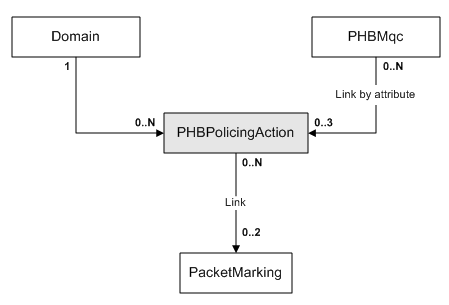
Description of "Figure 3-32 PHBPolicingAction Object Diagram"
Table 3-74 describes the attributes for the PHBPolicingAction object.
Table 3-74 PHBPolicingAction Object Attributes
| Attribute Name | Type | Default | Access | Explanation |
|---|---|---|---|---|
|
Name |
String |
"" |
RW |
Name of the object. |
|
Type |
Enum |
0 |
RW |
Enumeration indicating whether to apply a default or user-defined policing action: 0 = User 1 = DefaultConform 2 = DefaultExceed 3 = DefaultViolate |
|
Actions |
U32 |
0 |
RW |
Bitwise value, indicating action(s) to take. 0 = Drop 1 = Transmit 2 = SetClpTransmit 4 = SetFrDeTransmit 8 = SetDscpTransmit 32 = SetIPPrecedenceTransmit 16 = SetMplsExpTransmit 65 = SetPolicedDscpTransmit |
Cos Object
The Cos object defines a class of service. The Cos object is a child of the Domain or a COSFolder, but not both.
The Cos object has the following object inheritance:
Cos.Object
Figure 3-33 shows the Cos object diagram.
Table 3-75 describes the attributes for the Cos object.
Table 3-75 Cos Object Attributes
| Attribute Name | Type | Default | Access | Explanation |
|---|---|---|---|---|
|
Name |
String |
0 |
RW |
The name of the class of service. |
|
ConfiguredName |
String |
Value in the Name field |
RW |
Name of the configured Class of Service on the device. |
|
Remarks |
String |
"" |
RW |
Free-format text field, to add a description of the class of service; limit of 255 characters. |
|
Type |
Enum |
0 |
RW |
0 = User 1 = Default (IP Class of Service) 2 = NonIP |
COSFolder Object
The COSFolder object defines a class of service folder, used to contain class of service (CoS) objects and class of service subfolders. A COSFolder is a child of the Domain or another COSFolder object, but not both.
The COSFolder object has the following object inheritance:
COSFolder.Cos.Object
See Figure 3-33 for the COSFolder object diagram.
Table 3-76 describes the attributes for the COSFolder object.
Table 3-76 COSFolder Attributes
| Attribute Name | Type | Default | Access | Explanation |
|---|---|---|---|---|
|
Name |
String |
"" |
RW |
Name of the class of service folder |
|
Remarks |
String |
"" |
RW |
Optional additional comments. Limit of 255 characters. |
Service Group Object
The Service Group feature allows network administrators to create service groups, add PHB groups to those newly created groups, and apply those service groups to service instances.
The Service Group object has the following object inheritance:
ServiceGroup.Object
Figure 3-34 shows the Service Group object diagram.
DriverScript Object
Represents a script, written in Python, that when applied to a device, results in the generation of a command script used to configure a device directly.
The DriverScript object has the following object inheritance:
DriverScript.Object
Figure 3-35 shows the DriverScript object diagram.
Table 3-77 describes the attributes for the DriverScript object.
Table 3-77 DriverScript Object Attributes
| Attribute Name | Type | Default | Access | Explanation |
|---|---|---|---|---|
|
Name |
String |
Unique |
RW |
Name of the driver script. |
|
Script |
String |
"" |
RW |
The text of the Python script. Note that when creating DriverScript objects via the OIM CLI, it is possible to pass the content of a Python script using the following syntax: Script="pathname.py" where pathname is the full path of the script. Note that no spaces are permitted in pathname and the script must have a .py extension. For example: Script="c:\nvram.py" |
|
Type |
Enum |
0 |
RW |
Type of object this script applies to: 0 = Device 1 = Interface 2 = SubInterface 3 = AtmPvc 4 = FrPvc |
|
DeviceDriverType |
String |
cisco |
RW |
Indicates which device driver will run the script. |
|
When |
U32 |
1 |
RW |
When script is applied: 0 = Before standard configuration changes. 1 = After standard configuration changes. |
|
Repeat |
Boolean |
False |
RW |
False = Apply once only. True = Repeat on each propagate. |
|
ReApply |
Boolean |
False |
RW |
False = Do not re-apply. True = Repeat on next propagate only. The attribute is automatically set to False after the next propagate. |
|
OnRestart |
Boolean |
False |
RW |
False = Do not apply on a device restart. True = Apply on each device restart. |
|
Order |
U32 |
0 |
RW |
Script Order. Lowest number (0) indicates highest priority. Note that if this is changed for one script, all scripts with lower priority numbers are renumbered. |
|
Disabled |
Boolean |
False |
RW |
True = script is to be disabled at next propagate. False = script not to be disabled. |
|
InError |
Boolean |
False |
RO |
True = script is currently failing. False = script is not in error. |
|
CreateConcretesOnce |
Boolean |
False |
RW |
This Boolean is only used for 'Run Once' type scripts. When set to true, it stops the creation of new concretes after the script's first execution. |
|
HasRun |
Boolean |
False |
RO |
IP Service Activator sets this value when running the script. |
DriverscriptFolder Object
A DriverscriptFolder object represents a folder which contains Driverscript objects, or other DriverscriptFolder objects, for purposes of organization within the GUI.
The DriverscriptFolder object has the following object inheritance:
DriverscriptFolder.Object
Figure 3-36 shows the DriverscriptFolder object diagram.
Figure 3-36 DriverscriptFolder Object Diagram
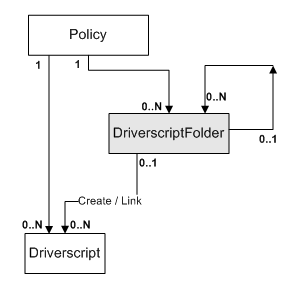
Description of "Figure 3-36 DriverscriptFolder Object Diagram"
A Driverscript always has either 1 or 2 parents and is always linked to its parent Policy. It may be linked to zero or one parent DriverscriptFolders. In the IP Service Activator GUI, if a Driverscript has 2 parents, it will always be displayed under the DriverscriptFolder, not under the Driver Scripts folder. If a Driverscript is created under a folder, it is automatically linked to its parent Policy.
Table 3-78 describes the attributes for the DriverscriptFolder object.
Table 3-78 DriverscriptFolder Object Attributes
| Attribute Name | Type | Default | Access | Explanation |
|---|---|---|---|---|
|
Name |
String |
"" |
RW |
Name of the Driverscript folder. |
|
Remarks |
String |
"" |
RW |
Optional additional comments. Limit of 255 characters. |
Role Objects
This section describes the Role objects.
Role Object (Abstract)
The Role object is used to define the role assigned to a configured object. It is used to determine the targets that policy elements (rules, PHB groups and driver scripts) apply to. Note that rules and PHB groups can have up to four roles (system-defined device role, user-defined device role, system-defined interface role and user-defined interface role).
The abstract Role object has the following object inheritance:
Role.Object
Figure 3-37 shows the Role object diagram.
Table 3-79 describes the attributes for the Role object.
Table 3-79 Role Object Attributes
| Attribute Name | Type | Default | Access | Explanation |
|---|---|---|---|---|
|
Name |
String |
"" |
RC |
Name of the role. |
|
Remarks |
String |
"" |
RC |
Optional additional comments. Limit of 255 characters. |
RoleFolder Object
The RoleFolder object defines a role folder, used to contain interface and device role objects and role subfolders. A role folder is the child of the Policy object or another RoleFolder object, but not both.
The RoleFolder object has the following object inheritance:
RoleFolder.Role.Object
See Figure 3-37 for the RoleFolder object diagram.
Table 3-80 describes the attributes for the RoleFolder object.
Table 3-80 RoleFolder Object Attributes
| Attribute Name | Type | Default | Access | Explanation |
|---|---|---|---|---|
|
Name |
String |
"" |
RW |
Name of the role folder. |
|
Remarks |
String |
"" |
RW |
Optional additional comments. Limit of 255 characters. |
RoleDevice Object
The RoleDevice object is used to define the role assigned to devices. RoleDevice objects can only be linked to Device objects. The RoleDevice object is a child of either the Policy object or a RoleFolder, but not both.
The RoleDevice object has the following object inheritance:
RoleDevice.Role.Object
See Figure 3-37 for the RoleDevice object diagram.
Table 3-81 describes the attribute for the RoleDevice object.
Table 3-81 RoleDevice Object Attributes
| Attribute Name | Type | Default | Access | Explanation |
|---|---|---|---|---|
|
Type |
Enum |
0 |
RO |
Defines the type of device role: 0 = UserDefined 1 = Access 2 = Gateway 3 = Core 4 = Any 5 = Shadow |
RoleInterface Object
The RoleInterface object is used to define the role assigned to a configured object. RoleInterface objects can be linked to Interface, SubInterface and VcEndPoint objects. The RoleInterface object is a child of either the Policy object or a RoleFolder, but not both.
The RoleInterface object has the following object inheritance:
RoleInterface.Role.Object
See Figure 3-37 for the RoleInterface object diagram.
Table 3-82 describes the attributes for the RoleInterface object.
Table 3-82 RoleInterface Object Attributes
| Attribute Name | Type | Default | Access | Explanation |
|---|---|---|---|---|
|
Type |
Enum |
0 |
RO |
Defines the type of interface role: 0 = UserDefined 1 = Core 2 = Local 3 = Access 4 = Disabled 5 = Any |
PacketMarking Object
The PacketMarking object defines a type of packet marking, which may be a DiffServ codepoint, an IP Precedence value, an MPLS Experimental value, a Frame Relay DE bit setting or an ATM CLP bit setting.
The PacketMarking object has the following object inheritance:
PacketMarking.Object
Figure 3-38 shows the PacketMarking object diagram.
Table 3-83 describes the attributes for the PacketMarking object.
Table 3-83 PacketMarking Object Attributes
| Attribute Name | Type | Default | Access | Explanation |
|---|---|---|---|---|
|
Name |
String |
"" |
RW |
Name of the object. |
|
MarkingType |
Enum |
0 |
RW |
0 = DSCodepointValue 1 = MplsHeader 2 = FrDe 3 = AtmClp 7 = IPPrecedence 8 = DiscardClass 9 = Trust 10 = COS 11 = COSInner 12 = QoSGroup |
|
MarkingValue |
String |
0 |
RW |
This value depends on the MarkingType, and defines how to mark traffic. The range is 0–7 for MPLS headers IP Precedence and DiscardClass; 0–63 for DiffServ codepoint. The range is 0-7 for Cos Marking and 0-7 for CosInner marking. The range is 0-1023 for QoSGroup. |
|
Id |
U32 |
0 |
RO |
Unique ID used to reference this object |
ConcreteObject Object
Concrete objects are automatically created and represent the actual application of a Rule, PHB group, VPN or Driver Script to a specific point in the network. Each rule, PHB group, VPN or Driver Script may result in a number of ConcreteObjects.
The ConcreteObject object has the following object inheritance:
ConcreteObject.Object
Figure 3-39 shows the ConcreteObject object diagram.
Table 3-84 describes the attributes for the ConcreteObject object.
Table 3-84 ConcreteObject Object Attributes
| Attribute Name | Type | Default | Access | Explanation |
|---|---|---|---|---|
|
Name |
String |
"" |
RO |
Name of the concrete object. |
|
Type |
String |
"Vpn" |
RO |
Type of object that created this concrete object. Can be: "RulePolicing" "RuleClassification" "RuleAccess" "DriverScript" "PHBGroup" "Vpn" |
|
Enabled |
Boolean |
True |
RCW |
True = policy element is active. False = policy element is disabled. |
|
Conflict |
Boolean |
False |
RO |
True = policy element is failing. False = policy element is not in error. |
|
Direction |
Enum |
Outbound |
RO |
0 = Inbound 1 = Outbound |
|
State |
Enum |
0 |
RO |
0 = Inactive 1 = Active 2 = Installed 3 = Failed 4 = Finished 5 = RunFailed 6 = RunOnceFailed 7 = Uninstalled 8 = UninstallFailed Uninstalled indicates successful removal of a policy from the device, after the policy concrete was disabled. UninstallFailed indicates failure to remove a policy from the device, after the policy concrete was disabled. The policy remains on the device, and its concrete remains disabled in the GUI. |
|
VpnOrder |
U32 |
0 |
RO |
When the object is a concrete VPN, this is a unique ID used to reference this object. |
|
AuditMismatchIgnored |
Boolean |
False |
RCW |
Set this Boolean so you can ignore an audit mismatch that has been fixed, or was never a real problem. (Set to ignore the mismatch when you do not plan to rerun the device audit again soon.) Unset this Boolean when you no longer wish to ignore an audit mismatch. |
|
AuditState |
Enum |
NotAvailable |
RO |
Read-only field displays Passed, Failed, or Not Available |
|
NotificationCount |
U32 |
RO |
Concrete state notification counter |
|
|
ExternalId |
U32 |
RO |
External ID of the concrete. |
The Topology Model
This section describes the topology model.
Topology Object
The Topology object represents the root of the entire Topology tree.
The Topology object has the following object inheritance:
Topology.Object
Figure 3-40 shows the Topology object diagram.
Table 3-85 describes the attributes for the Topology object.
Table 3-85 Topology Object Attributes
| Attribute Name | Type | Default | Access | Explanation |
|---|---|---|---|---|
|
Name |
String |
"Topology" |
RO |
Always “Topology". |
|
ReadCommunity |
String |
public |
RW |
SNMP community string for Read Access |
|
DiscoveryInProgress |
Boolean |
False |
RO |
True when a discovery request is made, set back to false, when request satisfied |
Network Object
Each domain has one root-level network object associated with it, which is automatically created with the domain and deleted when the domain is deleted.
The Network object has the following object inheritance:
Network.Object
A domain's network can be further partitioned by creating further levels of network objects under the root network object. A network needs to be linked either to a domain or to another network object. Each device within the domain is assigned to one network object.
Figure 3-41 shows the Network object diagram.
Table 3-86 describes the attributes for the Network object.
Table 3-86 Network Object Attributes
| Attribute Name | Type | Default | Access | Explanation |
|---|---|---|---|---|
|
Name |
String |
"" |
RO |
Name of network. Root network takes the name of the domain by default. |
|
Description |
String |
"" |
RW |
Free-format comments about the network. |
|
BgpAsn |
U32 |
0 |
RW |
Border Gateway Protocol, Autonomous System Number. |
|
InheritsBgpAsn |
Boolean |
False |
RW |
True=Inherits ASN from parent object. False=Does not inherit ASN. |
|
WriteCommunity |
EncryptedString |
"" |
RO |
The SNMP write community to use when fetching capabilities. |
|
Username |
Encrypted String |
"" |
RO |
The username for login when fetching capabilities. |
|
Password |
EncryptedString |
"" |
RO |
The password for login when fetching capabilities. |
|
EnablePassword |
EncryptedString |
"" |
RO |
The enable password for login when fetching capabilities. |
|
RsaPrivateKey |
EncryptedString |
"" |
RO |
Name of private key file when fetching capabilities. |
|
InheritsSecurity |
Boolean |
False |
RO |
True = Discovery will use the security attributes of the network object rather than the values entered as parameters to the discover command. False = Discovery does not inherit security settings. |
|
Context |
String |
"" |
RW |
Local context for driver scripts applied at network level (max 512 bytes). |
|
MaxTransactionSize |
U32 |
0 |
RW |
Maximum number of matches of Configuration Threshold regex pattern allowed in a device configuration session. |
|
IgnoresTransactionSize |
Boolean |
False |
RW |
True = Configuration Thresholding is turned on. False = Configuration Thresholding is turned off. |
|
InheritsTransactionSize |
Boolean |
False |
RW |
True = all Configuration Thresholding parameters (not just the maximum transaction size) are inherited from parent network. False = parameters are not inherited. |
|
MatchesPatternTransactionSize |
String |
"" |
RW |
Configuration Threshold regex pattern (limit 127 characters) Note: To modify the regular expression, see "Configuration Thresholding Feature: Modifying the Regular Expression". |
Device Object
The Device object is used to represent a network node that forwards IP packets, that is, a router or Layer 3 switch, rather than an end system host or server.
The Device object has the following network inheritance:
Device.Object
Figure 3-42 shows the Device object diagram.
Table 3-87 describes the attributes for the Device object.
Table 3-87 Device Object Attributes
| Attribute Name | Type | Default | Access | Explanation |
|---|---|---|---|---|
|
Name |
String |
"" |
RW |
Name of device. This is taken from the node name, which is set from the MIB value sysname.0. |
|
Description |
String |
"" |
RC |
SNMP sysDescription. |
|
Location |
String |
"" |
RC |
SNMP sysLocation. |
|
IpAddr |
IPAddress |
0.0.0.0 |
RW |
Address used to communicate with the device. |
|
LoopbackAddr |
IPAddress |
0.0.0.0 |
RW |
IP address of the loopback interface. |
|
WriteCommunity |
Encrypted String |
"" |
RC |
SNMP Write community. |
|
ReadCommunity |
Encrypted String |
"" |
RC |
SNMP Read community. |
|
IsVirtual |
Boolean |
True |
CO |
True = Creates a virtual device. Can be set on create and does not appear on the object. False = not a virtual device. |
|
Username |
Encrypted String |
"" |
RW |
Username. |
|
LoginPassword |
Encrypted String |
"" |
WO |
Login Password. Required if AccessStyle set to NamedUser, Anonymous, SSH or passwordOnly. |
|
EnablePassword |
Encrypted String |
"" |
WO |
Enable Password. Required if AccessStyle set to NamedUser, Anonymous, or SSH. |
|
InheritsSecurity |
Boolean |
True |
RW |
True = device security options are inherited from the network object. False = security settings are specific for the device. |
|
State |
Enum |
7 |
RO |
Last known device state: 0 = Down 1 = Unmanaged 2 = New 3 = NotFound 4 = PreProvisioned 5 = Managed 6 = InterventionRequired 7 = Virtual |
|
UnmanagedAction |
Enum |
2 |
RW |
The action to take when unmanaging the device and any of its interfaces: 0 = RemoveConfiguration 1 = LeaveConfiguration 2 = UseGlobalSettings |
|
SnmpVn |
Enum |
3 |
RW |
Version of SNMP to use to interrogate the device: 0 = None 1 = SnmpV1 2 = SnmpV2c 3 = SnmpV1V2c |
|
SnmpRetries |
U32 |
2 |
RW |
The number of retry attempts when sending a PDU (Protocol Data Unit). Range: 0–20 |
|
SnmpTimeout |
U32 |
3 |
RW |
Timeout of PDU response Range: 1–30 seconds |
|
SysObjectId |
String |
"" |
RC |
SNMP obtained unique object identifier. |
|
UpTime |
U32 |
Now |
RC |
Date and Time since the device is available (seconds). |
|
CommandDeliveryMode |
Enum |
0 |
RW |
0 = Online: commands delivered to device 1 = OfflineMaintenance: commands not delivered, concretes and other states updated 2 = OfflineTest: commands not delivered |
|
AccessType |
Enum |
5 |
RW |
0 = NamedUser 1 = Anonymous 2 = TACACS 3 = SNMPv1 4 = SNMPv2c 5 = None 6 = SSH 8 = RSA_SSH 9 = passwordOnly |
|
RsaPrivateKey |
Encrypted String |
"" |
RO |
Name of SSH RSA private key file (max length 3072 characters). |
|
Context |
String |
"" |
RW |
Local context for driver scripts applied to devices (max 512 bytes). |
|
ManualConfig Mode |
Enum |
3 |
RW |
Action on this device for detecting manual configuration: 0 = Disable 1 = Warn 2 = Fail 3 = Inherit |
|
UseSaaIpAddr |
Boolean |
False |
RW |
Indicates if SaaIpAddr is to be used as destination IP address for SAA. If set to false, IpAddr will be used instead. |
|
SaaIpAddr |
Boolean |
0 |
RW |
Destination IP address for SAA. |
|
SaaSourceIpAddr |
Boolean |
0 |
RW |
Source IP Address for SAA |
|
SaaSourceIpAddrMode |
Enum |
NotConfigured |
RW |
Valid modes are: 0=NotConfigured, 1=SameAsDestination, 2=DeviceManagementAddress, 3=SpecifiedAddress. When choosing 3, SaaSourceIpAddr will be used as source IP address for SAA. |
|
AuditId |
U32 |
RO |
||
|
AuditState |
Enum |
NotAvailable |
RO |
NotAvailable, Passed, Failed, Error |
|
CliPort |
U32 |
23 |
RW |
CLI/Telnet Port to talk to device (for example, Telnet Port 23). |
|
bgpLocalAs |
U32 |
Set by discovery process |
RC |
Discovered device ASN. This value overrides the domain ASN for BGP configuration. |
|
EigrpAsn |
U32 |
0 |
RW |
ASN for EIGRP. When specified, this ASN is used to create an EIGRP routing process which will contain the individual vrf-address-family configuration required for each VPN running EIGRP. |
|
LoopBackId |
U32 |
0 |
RW |
The Loopback ID value is used to create a loopback interface name by appending it to the name 'loopback'. For example, if the Loopback ID is 0, the loopback interface name created is 'loopback0'. When a device in this domain is discovered, a check is made to see if a loopback interface matching this text string exists. If it does, the IP address of the loopback interface is stored with the device information. Range: 0–4 294 967 295 Note: Any changes made to the default loopback ID for the domain, or for any devices, have no effect until the affected devices are re-discovered. Note that on Juniper M-series devices, the loopback ID must always be specified as 0 through the user interface. |
|
OverrideLoopbackId |
Boolean |
False |
RW |
Set this value to override the default loopback ID specified for the domain for this device. |
|
DeviceType |
String |
"" |
RW |
Name of DeviceType object containing details of this type of device. The DeviceType object must be a child of the Topology object. This attribute can be used to link directly to other objects in the EOM. |
|
MaxTransactionSize |
U32 |
0 |
RW |
Maximum number of matches of Configuration Threshold regex pattern allowed in a device configuration session. |
|
IgnoresTransactionSize |
Boolean |
False |
RW |
True = Configuration Thresholding is turned on. False = Configuration Thresholding is turned off. |
|
InheritsTransactionSize |
Boolean |
False |
RW |
True = all Configuration Thresholding parameters (not just the maximum transaction size) are inherited from parent network. False = parameters are not inherited. |
|
MatchesPatternTransactionSize |
String |
"" |
RW |
Configuration Threshold regex pattern (limit 127 characters). Note: To modify the regular expression, see "Configuration Thresholding Feature: Modifying the Regular Expression". |
|
StrictClassAggregation |
Boolean |
False |
RW |
Enables strict aggregation processing for classifications applied to the current device, which ensures classifications from a contained group are promoted to the parent group, when aggregation is enabled on the contained classification group. |
|
MaxRepetitions |
U32 |
100 |
RW |
Specifies the maximum number of rows that will fetch from a network resource in a single request when SNMP V2c is used for discovery. Permitted range for this filed is 1 to 100. Decrease the value of Max-Repetitions if the routers don't respond to the default value of 100. |
|
Discovery |
Boolean |
False |
RO |
This read-only attribute is set to True while SNMP discovery is in progress on a device. The attribute is set to False at all other times. |
DeviceCapabilities Object
The DeviceCapabilities object represents the capabilities and characteristics of a device. One object exists for each device.
Table 3-88 describes the attributes for the DeviceCapabilities object.
Table 3-88 DeviceCapabilities Object Attributes
| Attribute Name | Type | Default | Access | Explanation |
|---|---|---|---|---|
|
AhMacSecurityAlgorithmsCaps |
U32 |
0 |
RW |
Indicates support for AhMacSecurityAlgorithmsCaps. |
|
CapabilitiesSet |
Boolean |
False |
RW |
Indicates support for capabilities sets. |
|
CASupport |
Boolean |
False |
RW |
Indicates support for CA. |
|
CompressionAlgorithmCaps |
U32 |
0 |
RW |
Indicates support for CompressionAlgorithmCaps. |
|
DhGroupCaps |
U32 |
0 |
RW |
Indicates support for DhGroupCaps. |
|
EspSecurityAlgorithmsCaps |
U32 |
0 |
RW |
Indicates support for EspSecurityAlgorithmsCaps. |
|
GreSupport |
Boolean |
False |
RW |
Indicates support for Gre. |
|
IkeSecurityAlgorithmsCaps |
U32 |
0 |
RW |
Indicates support for IkeSecurityAlgorithmsCaps. |
|
IPsecModesCaps |
U32 |
0 |
RW |
Indicates support for IPsecModesCaps. |
|
SAANetflowVersionSupport |
U32 |
0 |
RW |
Indicates support for SAANetflowVersion. |
|
SAASupport |
Boolean |
False |
RW |
Indicates support for SAA. |
|
SAATypesSupported |
U32 |
0 |
RW |
Indicates support for SAATypes. |
|
SharedKeySupport |
Boolean |
False |
RW |
Indicates support for SharedKey. |
|
TlsSupport |
Boolean |
False |
RW |
Indicates support for Tls. |
|
TrustedRootCAsSupport |
Boolean |
False |
RW |
Indicates support for TrustedRootCAs. |
|
VlansSupport |
Boolean |
False |
RW |
Indicates support for Vlans. |
|
Name |
String |
RO |
Name of the object. |
DeviceType Object
A DeviceType object represents a device type recognized by IP Service Activator. They are automatically created on startup, and on discovery of a device of a new type.
The DeviceType object has the following object inheritance:
DeviceType.Object
Figure 3-43 shows the DeviceType object diagram.
Table 3-89 describes the attributes for the DeviceType object.
Table 3-89 DeviceType Object Attributes
| Attribute Name | Type | Default | Access | Explanation |
|---|---|---|---|---|
|
Name |
String |
"" |
RW |
Name of device type. |
|
DeviceDriver |
String |
"" |
RW |
Name of the device driver used to manage this device type. |
|
Vendor |
String |
"" |
RW |
Company that makes the device (such as Cisco). |
|
Product |
String |
"" |
RW |
Name of the device (such as 2500). |
|
SoftwareVersion |
String |
"" |
RW |
Version of software in device (such as 12.1). |
|
SoftwareOs |
String |
"" |
RW |
Name of operating system (such as IOS). |
|
SysObjectId |
String |
"" |
RW |
SNMP-obtained unique object identifier. |
|
StrictClassAggregation |
Boolean |
False |
RW |
Enables strict classification aggregation on this device |
InterfaceCapabilities Object
An InterfaceCapabilities object represents the capabilities and characteristics of an interface on the device. One object exists for each interface. These objects are created by reading the interface table of each device. Capabilities objects are re-used for objects which have the same set of capabilities parameters.
The InterfaceCapabilities object has the following object inheritance:
SubInterfaceCapabilities.Object
Note:
Do not attempt to modify values in the Capabilities object through the OIM. Do not attempt to create Capabilities objects through the OIM. These actions will cause system instability.
Table 3-90 describes the attributes for the InterfaceCapabilities object.
Table 3-90 InterfaceCapabilities Object Attributes
| Attribute Name | Type | Default | Access | Explanation |
|---|---|---|---|---|
|
AccessRulesSupported |
U32 |
0 |
RCW |
Indicates that you can implement access rules on this interface. |
|
ATMQoSSupport |
U32 |
0 |
RCW |
Indicates that you can implement PHB groups using ATM Traffic Shaping on this PVC. |
|
ATMQueueDepthSupport |
Boolean |
False |
RW |
Indicates that you can implement PHB groups using ATM queue depth. |
|
ATMTxRingLimitSupport |
Boolean |
False |
RW |
Indicates that you can implement PHB groups using ATMTxRingLimit. |
|
BEC[no default]daptSupport |
Boolean |
False |
RCW |
Indicates that you can implement PHB groups using BEC[no default]dapt. |
|
CapabilitiesSet |
Boolean |
False |
RCW |
Indicates support for capabilities sets. |
|
CbqClassify |
U32 |
0 |
RCW |
Indicates that you can implement classification rules on this interface using Cbq. |
|
CbqClassifyEnh |
U32 |
0 |
RW |
Indicates that you can implement enhanced classification rules on this interface using Cbq. |
|
CbqSupport |
U32 |
0 |
RCW |
Indicates that you can implement PHB groups using Cbq. |
|
ClassificationAccessRules |
U32 |
0 |
RCW |
Indicates that you can implement classification rules on this interface. |
|
ClassificationEnhAccessRules |
U32 |
0 |
RW |
Indicates that you can implement enhanced classification rules on this interface. |
|
ClassificationEnhPolicingRules |
U32 |
0 |
RW |
Indicates that you can implement classification of enhanced policing rules on this interface. |
|
ClassificationEnhServiceRules |
U32 |
0 |
RW |
Indicates that you can implement classification of enhanced service rules on this interface. |
|
ClassificationPolicingRules |
U32 |
0 |
RCW |
Indicates that you can implement classification of policing rules on this interface. |
|
ClassificationServiceRules |
U32 |
0 |
RCW |
Indicates that you can implement classification of service rules on this interface. |
|
DeMarking |
Boolean |
False |
RCW |
Indicates support for DeMarking. |
|
FEC[no default]daptSupport |
Boolean |
False |
RCW |
Indicates that you can implement PHB groups using FEC[no default]dapt. |
|
FRF12Support |
Boolean |
False |
RCW |
Indicates that you can implement PHB groups using FRF12. |
|
FRQueueDepthSupport |
Boolean |
False |
RW |
Indicates that you can implement PHB groups using FRQueueDepth. |
|
FrtsInboundSupport |
Boolean |
False |
RW |
Indicates the direction (inbound) in which you can implement PHB groups using FRTS. |
|
FrtsSupport |
Boolean |
False |
RCW |
Indicates that you can implement PHB groups using FRTS. |
|
GuaranteesSupported |
U32 |
0 |
RCW |
Indicates that you can implement PHB groups using Guarantees. |
|
IpUnnumberedConfigSupport |
Boolean |
False |
RW |
Indicates that you can implement PHB groups using IpUnnumberedConfig. |
|
LabelSwitchingSupport |
Boolean |
False |
RCW |
Indicates that you can implement PHB groups using LabelSwitching. |
|
LimitsSupported |
U32 |
0 |
RCW |
Indicates that you can implement PHB groups using Limits. |
|
MarkingPolicingRules |
U32 |
0 |
RCW |
Indicates that you can implement marking policing rules on this interface. |
|
MarkingServiceRules |
U32 |
0 |
RCW |
Indicates that you can implement marking service rules on this interface. |
|
MarkingSupported |
U32 |
0 |
RCW |
Indicates that you can implement PHB groups using Marking. |
|
MqcAggregatePolicer |
Boolean |
False |
RW |
Indicates support for MqcAggregatePolicer. |
|
MqcClassify |
U32 |
0 |
RCW |
Indicates that you can implement classification rules on this interface using Mqc. |
|
MqcClassifyEnh |
U32 |
0 |
RW |
Indicates that you can implement enhanced classification rules on this interface using Mqc. |
|
MqcLlqBandwidthTypeSupport |
U32 |
0 |
RCW |
Indicates that you can implement PHB groups using MqcLlqBandwidthType. |
|
MqcLlqBurstRateSupport |
Boolean |
False |
RW |
Indicates that you can implement PHB groups using MqcLlqBurstRate. |
|
MqcLlqSupport |
Boolean |
False |
RCW |
Indicates that this interface supports MqcLlq. |
|
MqcMarking |
U32 |
0 |
RCW |
Indicates support for MqcMarking. |
|
MqcMaxReservedBandwidth |
Boolean |
False |
RW |
Indicates support for MqcMax reserved bandwidth. |
|
MqcNestingSupport |
Boolean |
False |
RCW |
Indicates that this interface supports MqcNesting. |
|
MqcPoliceRateTypeSupport |
U32 |
1 |
RCW |
Indicates that this interface supports MqcPoliceRateType. |
|
MqcQueueLimitSupport |
Boolean |
False |
RCW |
Indicates that this interface supports MqcQueueLimit. |
|
MqcShapeFrtsSupport |
Boolean |
False |
RCW |
Indicates that this interface supports MqcShapeFrts. |
|
MqcShapeSupport |
Boolean |
False |
RCW |
Indicates that this interface supports MqcShape. |
|
MqcShapingBuffersSupport |
Boolean |
False |
RW |
Indicates that this interface supports MqcShapingBuffers. |
|
MqcSingleRatePoliceAction |
U32 |
0 |
RCW |
Indicates support for MqcSingleRatePoliceAction capability. |
|
MqcSingleRatePoliceSupport |
Boolean |
False |
RCW |
Indicates that this interface supports MqcSingleRatePolice. |
|
MqcSupport |
U32 |
0 |
RCW |
Indicates that this interface supports Mqc. |
|
MqcTwoRatePoliceAction |
U32 |
0 |
RCW |
Indicates support for MqcTwoRatePoliceAction capability. |
|
MqcTwoRatePoliceSupport |
Boolean |
False |
RCW |
Indicates that this interface supports MqcTwoRatePolice. |
|
MqcWfqBandwidthTypeSupport |
U32 |
0 |
RCW |
Indicates that this interface supports MqcWfqBandwidthType. |
|
MqcWfqSupport |
Boolean |
False |
RCW |
Indicates that this interface supports MqcWfq. |
|
MqcWredClassify |
U32 |
0 |
RCW |
Indicates that you can implement classification rules on this interface using MqcWred. |
|
MqcWredClassifyEnh |
U32 |
0 |
RW |
Indicates that you can implement enhanced classification rules on this interface using Mqc. |
|
MqcWredEcn |
Boolean |
False |
RW |
Indicates support for MqcWredEcn. |
|
MqcWredSupport |
U32 |
0 |
RCW |
Indicates that this interface supports MqcWred. |
|
Outbound |
Boolean |
TRUE |
RCW |
Indicates the direction of the service. |
|
PolicingSupported |
U32 |
0 |
RCW |
Indicates that you can implement policing rules. |
|
PqClassify |
U32 |
0 |
RCW |
Indicates that you can implement classification rules on this interface using Pq. |
|
PqClassifyEnh |
U32 |
0 |
RW |
Indicates that you can implement enhanced classification rules on this interface using Pq. |
|
PqSupport |
U32 |
0 |
RCW |
Indicates that this interface supports Pq. |
|
PtToPtEncapsulationCaps |
U32 |
0 |
RCW |
Indicates support for Point to Point EncapsulationCaps capability. |
|
RlimBurst |
Boolean |
False |
RCW |
Indicates support for RlimBurst capability. |
|
RlimClassify |
U32 |
0 |
RCW |
Indicates that you can implement classification rules on this interface using Rlim. |
|
RlimClassifyEnh |
U32 |
0 |
RW |
Indicates that you can implement enhanced classification rules on this interface using Rlim. |
|
RoutingCaps |
bitmap |
0 |
RCW |
0 - None 1 - RIP for VPN 2 - Static for VPN 4 - EBGP for VPN 8 - OSPF for VPN 16 - RIP for Virtual CE (not yet supported) 32 - Static for Virtual CE 64 - EBGP for Virtual CE 128 - OSPF for Virtual CE |
|
VCConfigSupport |
Boolean |
False |
RCW |
Indicates that VCConfig is supported. |
|
VpnSupport |
bitmap |
0 |
RCW |
Indicates that this interface supports VPNs. 0 - None 1 - MPLS 2 - IPsec 4 - Virtual CE |
|
WfqClassify |
U32 |
0 |
RCW |
Indicates that you can implement PHB groups using the WFQ. |
|
WfqClassifyEnh |
U32 |
0 |
RW |
Indicates that you can implement PHB groups using the enhanced WFQ. |
|
WfqHighPriorityWeightAsPercent |
Boolean |
False |
RCW |
Indicates that you can implement PHB groups using the WFQ priority as percentage. |
|
WfqLowPriorityWeightAsPercent |
Boolean |
False |
RCW |
Indicates that you can implement PHB groups using the WFQ low priority weight as percentage. |
|
WfqPlusWredClassify |
U32 |
0 |
RCW |
Indicates that you can implement PHB groups using the WFQ plus Wred. |
|
WfqPlusWredClassifyEnh |
U32 |
0 |
RW |
Indicates that you can implement PHB groups using the enhanced WFQ plus Wred. |
|
WfqPlusWredSupport |
Boolean |
False |
RCW |
Indicates that you can implement PHB groups using the WFQ plus Wred. |
|
WfqSupport |
U32 |
0 |
RCW |
Indicates that you can implement PHB groups using the WFQ. |
|
WredClassify |
U32 |
0 |
RCW |
Indicates that you can implement classification rules on this interface using Wred. |
|
WredClassifyEnh |
U32 |
0 |
RW |
Indicates that you can implement classification rules on this interface using enhanced Wred. |
|
WredEcn |
Boolean |
False |
RW |
Indicates support for WredEcn. |
|
WredSupport |
U32 |
0 |
RCW |
Indicates that you can implement PHB groups using the WRED. |
|
WrrClassify |
U32 |
0 |
RCW |
Indicates that you can implement classification rules on this interface using Wrr. |
|
WrrClassifyEnh |
U32 |
0 |
RW |
Indicates that you can implement classification rules on this interface using enhanced Wrr. |
|
WrrSupport |
U32 |
0 |
RCW |
Indicates that you can implement PHB groups using the WRR. |
|
Name |
String |
"InterfaceCapabilities" |
R |
Name of the object. |
|
Id |
U32 |
490 |
R |
The unique ID used to reference this object. |
VCCapabilities Object
A VCCapabilities object represents the capabilities and characteristics of a virtual circuit on the device. One object exists for each VC. Capabilities objects are re-used for objects which have the same set of capabilities parameters.
The VCCapabilities object has the following object inheritance:
VCCapabilities.InterfaceCapabilities.Object
See Figure 3-44 for the VCCapabilities object diagram.
Table 3-91 describes the attributes for the VCCapabilities object.
Table 3-91 VCCapabilities Object Attributes
| Attribute Name | Type | Default | Access | Explanation |
|---|---|---|---|---|
|
CbqClassifyEnh |
U32 |
0 |
RW |
Indicates that you can implement enhanced classification rules on this interface using Cbq. |
|
ClassificationEnhPolicingRules |
U32 |
0 |
RW |
Indicates that you can implement classification using enhanced policing rules. |
|
ClassificationEnhServiceRules |
U32 |
0 |
RW |
Indicates that you can implement classification using enhanced service rules. |
|
MqcClassifyEnh |
U32 |
0 |
RW |
Indicates that you can implement enhanced classification rules on this interface using Mqc. |
|
MqcWredClassifyEnh |
U32 |
0 |
RW |
Indicates that you can implement enhanced classification rules on this interface using Mcq and Wred. |
|
PqClassifyEnh |
U32 |
0 |
RW |
Indicates that you can implement enhanced classification rules on this interface using Pq. |
|
RlimClassifyEnh |
U32 |
0 |
RW |
Indicates that you can implement enhanced classification rules on this interface using Rlim. |
|
WfqClassifyEnh |
U32 |
0 |
RW |
Indicates that you can implement enhanced classification rules on this interface using Wfq. |
|
WfqPlusWredClassifyEnh |
U32 |
0 |
RW |
Indicates that you can implement enhanced classification rules on this interface using Wfq and Wred. |
|
WredClassifyEnh |
U32 |
0 |
RW |
Indicates that you can implement enhanced classification rules on this interface using Wred. |
|
WrrClassifyEnh |
U32 |
0 |
RW |
Indicates that you can implement enhanced classification rules on this interface using Wrr. |
Interface Object
An Interface object represents an interface on the device. One object exists for each interface. These objects are created by reading the interface table of each device.
The Interface object has the following object inheritance:
Interface.Object
Some of the attributes on an Interface object are only meaningful when the Interface is linked as a child of a site object. The attributes cannot be modified when not linked to a site, and if the interface is unlinked from the site then the attributes will automatically be set to null values. The affected attributes are marked ‘Site Only' in Table 3-92.
Only attributes related to the selected routing protocol are displayed as part of the Interface attributes. For example, if the routing protocol for the site is set to EBGP, then only the EBGP-specific routing protocol attributes are displayed as part of the Interface attributes.
If the routing protocols set for the site include EBGP and if the site has more than one neighbor, the attributes for the first neighbor are displayed as part of the Interface attributes.
Figure 3-44 shows the Interface object diagram.
Table 3-92 describes the attributes for the Interface object.
Table 3-92 Interface Object Attributes
| Attribute Name | Type | Default | Access | Explanation |
|---|---|---|---|---|
|
Name |
String |
[no default] |
RCW |
Name of the interface. |
|
Description |
String |
[no default] |
RCW |
SNMP ifDescription. |
|
Number |
U32 |
0 |
RCW |
Number of the interface (SNMP ifIndex). |
|
Type |
U32 |
1 |
RCW |
SNMP ifType. |
|
Hardware |
String |
[no default] |
R |
Hardware description |
|
IpAddr |
IPAddress |
0.0.0.0 |
RCW |
IP Address for interface if applicable. |
|
SubnetMask |
IPAddress |
0.0.0.0 |
RCW |
Subnet mask. |
|
Ipv6Addr |
IPAddress |
::/0 |
RCW |
IPv6 Address and prefix length for the interface, if applicable. |
|
PhysicalAddress |
String |
[no default] |
RCW |
Physical address of the interface (the MAC address). |
|
Speed |
U32 |
0 |
RCW |
Speed of the interface in Kbits/s (SNMP ifSpeed parameter). |
|
State |
Enum |
4 |
RCW |
State of interface 0 = Down 1 = Up 2 = Testing 3 = Shutdown 4 = Unknown Constructed from the SNMP ifAdminStatus and ifOperStatus. Interfaces and sub-interfaces connected to a virtual device always have a state of "Unknown". |
|
PublicPeIpAddr (Site only) |
IPAddress |
0.0.0.0 |
RO |
PE interface address when not in a VRF. |
|
PublicPeMask (Site Only) |
IPAddress |
0.0.0.0 |
RO |
PE interface address when not in a VRF. |
|
PrivatePeIpAddr (Site Only) |
IPAddress |
0.0.0.0 |
RO |
PE interface address when in a VRF. |
|
PrivatePeMask (Site only) |
IPAddress |
0.0.0.0 |
RO |
PE interface address when in a VRF. |
|
PrivateCeIpAddr (Site only) |
IPAddress |
0.0.0.0 |
RO |
CE interface address when using EBGP and in a VRF. |
|
PrivatePeIpv6Addr |
IPAddress |
::/0 |
RCW |
PE interface Ipv6 address and prefix length when in a VRF. |
|
PublicPeIpv6Addr |
IPAddress |
::/0 |
RCW |
PE interface Ipv6 address and prefix length when not in a VRF. |
|
PrivateInterface Description |
String |
[no default] |
RO |
Description of the interface. |
|
VrfTableName (Site only) |
String |
[no default] |
RO |
The name of the VRF routing table. |
|
OverrideVrfTable Limit (VPN site only) |
Boolean |
False |
RO |
True = Use site-specific settings for VRF table limits False = Use domain defaults for VRF table limits. |
|
VrfTableLimit (VPN site only) |
U32 |
0 |
RO |
Maximum number of routes allowed in a VRF (0=No limit). |
|
VrfTableLimit Warning (VPN site only) |
U32 |
0 |
RO |
Percentage at which to warn of VRF table limits being exceeded. Range: 1–101, where 1–100 = percentage of VrfTableLimit reached warning. 101 = warning when VrfTableLimit reached |
|
RDHighOrder (VPN site only) |
U32 |
0 |
RO |
The top 32 bits of the Route Descriptor value. |
|
RDLowOrder (VPN site only) |
U32 |
0 |
RO |
The bottom 32 bits of the Route Descriptor value. |
|
ActualRDHighOrder |
U32 |
0 |
RO |
The reference attribute that displays the actual RD value that EOM configures after VRF reduction and inheritance is taken into account. If you manually configure any RD values, you can use ActualRDHighOrder with ActualRDLowOrder to avoid duplication by keeping track of existing system RDs. |
|
ActualRDLowOrder |
U32 |
0 |
RO |
The reference attributes that displays the actual RD value that EOM configures after VRF reduction and inheritance is taken into account. If you manually configure any RD values, you can use ActualRDLowOrder with ActualRDHighOrder to avoid duplication by keeping track of existing system RDs. |
|
LocalPreference |
U32 |
0xffffffff |
RO |
0xffffffff as default value in Cisco device this will equate to (100) when Local-preference command is not used. Can be in range 0 to *232 - 2) for EBGP only. A lower value indicates a high priority. |
|
VrfExportFilter (Site only) |
String |
[no default] |
RO |
Name of the pre-existing VRF export filter. [no default] = no filter applied. |
|
EbgpPrefixFilterIn (Site only) |
String |
[no default] |
RO |
Name of the pre-existing inbound prefix filter. [no default] = no filter applied. |
|
EbgpPrefixFilterOut (Site only) |
String |
[no default] |
RO |
Name of the pre-existing outbound prefix filter. [no default] = no filter applied. |
|
EbgpPrefixLimit (Site only) |
U32 |
0 |
RO |
The maximum number of eBGP prefixes that a PE is allowed to receive. Range: 1–232 0 = no limit |
|
EbgpPrefixLimitWarning (Site only) |
U32 |
0 |
RO |
The percentage at which to warn of eBGP prefix limits being exceeded. Range: 1–101, where 1–100 = warning when percentage of EbgpPrefix limit reached. 101 = warning when EbgpPrefixLimit reached. |
|
EbgpPrefixRestartDelay (Site only) |
U32 |
0 |
RO |
Delay, in minutes, before automatic restart of the EBGP session, after prefix limit was reached and session terminated. Range: 0–65535 0 = disabled |
|
KeepAlive |
U32 |
60 |
RO |
Frequency, in seconds with which Keep Alive messages are sent to neighbors or a specific group of neighbors. Range: 0–65535 0 = disabled |
|
HoldTime |
U32 |
180 |
RO |
Delay, in seconds. If a device does not receive a Keep Alive message until this time, it declares its neighbor to be dead. Range: 0–65535 0 = disabled |
|
EnableAdvertisementInterval |
Boolean |
False |
RO |
Allows the exchange of eBGP routing updates between two neighbors. |
|
AdvertisementInterval |
U32 |
0 |
RO |
Delay, in seconds, after which the subsequent eBGP routing updates to be exchanged between two neighbors. Range: 0–600 |
|
UpdateSourceInterface |
String |
PE Interface ID |
RCW |
Allows the definition of source interface to be used for eBGP updates on per neighbor basis. |
|
NeighbourDescription |
String |
Site Name |
RCW |
User defined description of neighbors on a per neighbor basis. Maximum 80 characters allowed. |
|
AsOverride (Site only) |
Boolean |
False |
RO |
True = Set AS Override for EBGP neighbors. False = Do not set AS override. |
|
OverrideAllowAsIn (Site only) |
Boolean |
False |
RO |
True = Site setting overrides the domain default setting of Allow AS in. False = Site setting should not override the domain default setting of Allow AS in. |
|
AllowAsIn (Site only) |
U32 |
0 |
RO |
The number of times the same AS can appear in the AS path list. Range: 0–10 |
|
BgpMd5Key (Site only) |
Encrypted string |
[no default] |
RO |
BGP MD5 authentication key [no default] = not used. |
|
EbgpMd5InheritFromVPN |
Boolean |
False |
RO |
True = inherit the interface's BGP authentication settings from the parent VPN. False = Does not inherit. |
|
OverridePeCeSend Community (Site only) |
Boolean |
False |
RO |
True = use local settings for Send Community parameters. False = use domain-level settings. |
|
PeCeSendStandard Community (Site only) |
Boolean |
False |
RO |
True = Use the PE-CE peering Standard send community tag. False = Does not use the PE-CE peering Standard send community tag. |
|
PeCeSendExtended Community (Site only) |
Boolean |
False |
RO |
True = Use the PE-CE peering Extended send community tag. False = Does not use the PE-CE peering Extended send community tag. |
|
Context (Site only) |
String |
[no default] |
RCW |
Local context for driver scripts applied to interfaces (max 512 bytes). |
|
VrfDesc (VPN site only) |
String |
[no default] |
RO |
Optional string describes the VRF applied to router, if the router supports VRF description string. |
|
EIBgpMaxPaths (VPN site only) |
U32 |
1 |
RO |
Maximum number of multipaths on both EBGP and IBGP. Range: 1–6 |
|
IBgpUnequalCost |
Boolean |
False |
RO |
Allows load balancing by selecting iBGP paths that do not have equal cost. |
|
VrfImport (VPN site only) |
U32 |
1 (turned off) |
RO |
The number of device redundant path configurations. Range is 216 plus default value. |
|
UseVrfImport |
Boolean |
True |
RO |
True = Use VRF import False = Do not use VRF import |
|
InternalName |
String |
[no default] |
RCW |
The internal name. |
|
IsConfigurable |
Boolean |
[no default] |
RO |
Whether the interface is configurable. |
|
IsController |
Boolean |
False |
RC |
Whether this interface has been tagged as controller during discovery |
|
AutoInheritVrf |
Boolean |
False |
RO |
Try to inherit the VRF table parameters from the VRF template in the VPN this interface is connected to. |
|
EBgpMaxPaths |
U32 |
0 |
RO |
Specification of the maximum number of parallel EBGP routes that can be installed in the routing table. This corresponds to the Cisco maximum-paths command. Range: 1–16 |
|
EbgpLocalAsn |
U32 |
0 |
RO |
Autonomous Systems path. Range: 1–4294967295 |
|
EbgpLocalAsnEnable |
Boolean |
False |
RO |
Whether Local Autonomous Systems Numbers is enabled or not. |
|
EbgpLocalAsnNoPrepend |
Boolean |
False |
RO |
If true, device does not prepend the local ASN to any routes received from the eBGP neighbor |
|
EbgpLocalAsnReplaceAs |
Boolean |
False |
RW |
The replace-as keyword is used to prepend only the local autonomous- systemnumber (as configured with the ip-address argument) to the AS_PATH attribute.The autonomous-system number from the local BGP routing process is not prepended. |
|
EbgpLocalAsnDualAs |
Boolean |
False |
RW |
The dual-as keyword is used to configure the eBGP neighbor to establish a peering session using the real autonomous-system number (from the local BGP routing process) or by using the autonomous-system number configured with the ip-address argument (local-as). |
|
EbgpMd5InheritFromVPN |
Boolean |
False |
RO |
True = inherit the interface EBGP authentication settings from the parent VPN. False = Does not inherit the interface EBGP authentication settings. |
|
EbgpMultihop |
Boolean |
False |
RO |
Enables BGP connections to devices on networks that are not directly connected (that are more than one hop away from a local device). |
|
EbgpSoftReconfig |
Boolean |
False |
RCW |
Enables the EBGP soft reconfiguration setup command on Cisco and Juniper E-series devices. Setting this value does not issue a soft reconfiguration reset action - it enables the support for the reset action |
|
IsNextHopSelf |
Boolean |
False |
RCW |
Enables configuration of the router as the next hop for a Border Gateway Protocol (BGP)-speaking neighbor. False = Do not generate the corresponding command. |
|
NeighborConnectionWeight |
U32 |
0xffffffff |
RCW |
To assign a weight to a neighbor connection. Valid range is 0 – 65535. The value 0xffffffff(4294967295) used to specify no-value. This is equivalent to turning off the neighbor connection weight feature. |
|
FilterListIn |
U32 |
0xffffffff |
RCW |
Number of an autonomous system path access list for incoming routes. Valid range is 1 – 500. The value 0xffffffff (4294967295) used to specify no-value. This is equivalent to turning off the inbound filter-list feature. |
|
FilterListOut |
U32 |
0xffffffff |
RCW |
Number of an autonomous system path access list for incoming routes. Valid range is 1 – 500. The value 0xffffffff (4294967295) used to specify no-value. This is equivalent to turning off the outbound filter-list feature. |
|
EbgpNeighborSoo |
Boolean |
False |
RCW |
True indicates that configuration of neighbor soo is required. |
|
UseDefaultOriginateRouteMap |
Boolean |
False |
RCW |
True indicates that configuration of default-originate route map is required. |
|
DefaultOriginateRouteMapName |
Boolean |
String |
RCW |
User can set this value to route-map name. This value will take into consideration only when UseDefaultOriginateRouteMap is true. |
|
EigrpDampHalfLife |
U32 |
False |
RO |
Time, in minutes, when a penalty applying to a route is decreased by half. Range: 1–45, default is 15. |
|
EigrpDampMaxSuppressTime |
U32 |
0 |
RO |
Maximum time, in minutes, that a route can be suppressed. The valid range is 1–255 for Cisco and Juniper E-series devices, 1–720 for Juniper M-series devices. The default is 60 minutes. |
|
EigrpDampReuse |
U32 |
0 |
RO |
Reuse threshold (default 750) Range: 1–20 000 |
|
EigrpDampSuppress |
U32 |
0 |
RO |
Cutoff (suppression) threshold (default 2000) Range: 1–20 000 |
|
EigrpMaxPaths |
U32 |
0 |
RO |
Specification of the maximum number of parallel EIGRP routes that can be installed in the routing table. This corresponds to the Cisco maximum-paths command. Range: 1–16 |
|
EigrpMd5Enable |
Boolean |
0 |
RO |
Enable MD5 key authentication for EIGRP for the interface |
|
EigrpMd5InheritFromVPN |
Boolean |
0 |
RO |
True = inherit the interface's EIGRP authentication settings from the parent VPN. False = Does not inherit. |
|
EigrpMd5KeyChainRef |
String |
[no default] |
RO |
Key chain name to use with MD5 Authentication for EIGRP. |
|
EnableAdvertisementInterval |
Boolean |
False |
RO |
EBGP: Allows the exchange of eBGP routing updates between two neighbors. |
|
EnableExternalInboundRouteMap |
Boolean |
False |
RO |
Enables the use of a specified route map name for inbound external route-map. Disabled for virtual-CE. |
|
UseExternalOutboundRouteMap |
Boolean |
False |
RO |
Enables specification of an outbound external BGP route-map for the interface |
|
ExternalInboundRouteMap |
String |
[no default] |
RO |
Name of the inbound external route-map |
|
ExternalOutboundRouteMap |
String |
[no default] |
RO |
Name of the outbound external route-map |
|
InboundRouteMap |
String |
[no default] |
RO |
Inbound route map name. |
|
InheritVRFRouteMapsFromVPN |
Boolean |
False |
RO |
Inherit the VRF table name and RD defined for the parent VPN |
|
LoopbackIpAddr |
IPAddress |
0.0.0.0 |
RW |
IP address for loopback. |
|
MultiVpnOverride |
Boolean |
False |
RO |
If a site is set to inherit VPN-wide VRF/RD details and participates in more than one VPN for which VPN-wide details are defined, IP Service Activator handles the conflict by applying site-specific automatically generated VRF/RD details to the site. If MultiVpnOverride and InheritVRFRouteMapsFromVPN are both set to true: - if the site is a member of only one VPN, the VRF table name and RD are derived from the parent VPN - if the site is a member of multiple VPNs, the VRF table name and RD are derived using the site specific options |
|
NoRedistributeStaticMerge |
Boolean |
False |
RW |
Use Default Static Route Redistribution |
|
NoRedistributeBgp2Eigrp |
Boolean |
FALSE |
RO |
Used to turn off route redistribution from Bgp to Eigrp; when this attribute is set to true, routes will not be redistributed from Bgp to Eigrp. For this attribute, access rights change after this interface is linked to the site and connectivity is set as BGP. |
|
NoRedistributeBgp2Ospf |
Boolean |
FALSE |
RO |
Used to turn off route redistribution from Bgp to Ospf; when this attribute is set to true, routes will not be redistributed from Bgp to Ospf. By default access will be "RO", when the interface is linked to some site and if the connectiviy changed to BGP then this attribute access changes to "RCW". |
|
NoRedistributeEigrp2Bgp |
Boolean |
FALSE |
RO |
Used to turn off route redistribution from Eigrp to Bgp; when this attribute is set to true, routes will not be redistributed from Eigrp to Bgp. Access is R only by default. For this attribute access rights will change once this interface is linked to the site and connectivity is EIGRP. |
|
NoRedistributeEigrp2Ospf |
Boolean |
FALSE |
RO |
Used to turn off route redistribution from Eigrp to Ospf; when this attribute is set to true, routes will not be redistributed from Eigrp to Ospf. Access is RO by default. For this attribute access rights will change once this interface is linked to the site and connectivity is EIGRP. |
|
NoRedistributeEigrp2Rip |
Boolean |
FALSE |
RO |
Used to turn off route redistribution from Eigrp to Rip; when this attribute is set to true, routes will not be redistributed from Eigrp to Rip. Access for attribute NoRedistributeEigrp2Rip is RO only by default. For this attribute access rights will change once this interface is linked to the site and connectivity is EIGRP. |
|
NoRedistributeOspf2Bgp |
Boolean |
FALSE |
RO |
Used to turn off route redistribution from Ospf to Bgp; when this attribute is set to true, routes will not be redistributed from Ospf to Bgp. Access type is not 'RW' by default for NoRedistributeOspf2Bgp attribute (i.e. Access is R only by default). For this attribute access rights will change once this interface is linked to the site and connectivity is OSPF. |
|
NoRedistributeOspf2Eigrp |
Boolean |
FALSE |
RO |
Used to turn off route redistribution from Ospf to Eigrp; when this attribute is set to true, routes will not be redistributed from Ospf to Eigrp. Access type is not 'RW' by default for NoRedistributeOspf2Eigrp attribute (i.e. access is R only by default). For this attribute access rights will change once this interface is linked to the site and connectivity is OSPF. |
|
NoRedistributeOspf2Rip |
Boolean |
FALSE |
RO |
Used to turn off route redistribution from Ospf to Rip; when this attribute is set to true, routes will not be redistributed from Ospf to Rip. Access type is not 'RW' by default for NoRedistributeOspf2Rip attribute (i.e. access is R only by default). For this attribute access rights will change once this interface is linked to the site and connectivity is OSPF. |
|
NoRedistributeRip2Eigrp |
Boolean |
FALSE |
RO |
Used to turn off route redistribution from Rip to Eigrp; when this attribute is set to true, routes will not be redistributed from Rip to Eigrp. Access type is not 'RW' by default for NoRedistributeRip2Eigrp attribute (i.e. access is R only by default). For this attribute access rights will change once this interface is linked to the site and connectivity is RIP. |
|
NoRedistributeRip2Ospf |
Boolean |
FALSE |
RO |
Used to turn off route redistribution from Rip to Ospf; when this attribute is set to true, routes will not be redistributed from Rip to Ospf. Access type is not 'RW' by default for NoRedistributeRip2Ospf attribute (i.e. access is R only by default). For this attribute access rights will change once this interface is linked to the site and connectivity is RIP. |
|
NoRedistributeStatic2Bgp |
Boolean |
FALSE |
RO |
Used to turn off route redistribution from Static to Bgp; when this attribute is set to true, routes will not be redistributed from Static to Bgp. Access type is not 'RW' by default for NoRedistributeStatic2Bgp attribute (i.e. access is R only by default). For this attribute access rights will change once this interface is linked to the site and connectivity is RIP/OSPF/EIGRP. |
|
NoRedistributeStatic2Eigrp |
Boolean |
FALSE |
RO |
Used to turn off route redistribution from Static to Eigrp; when this attribute is set to true, routes will not be redistributed from Static to Eigrp. Access type is not 'RW' by default for NoRedistributeStatic2Eigrp attribute (i.e. access is R only by default). For this attribute access rights will change once this interface is linked to the site and connectivity is RIP/OSPF/EIGRP. |
|
NoRedistributeStatic2Ospf |
Boolean |
FALSE |
RO |
Used to turn off route redistribution from Static to Ospf; when this attribute is set to true, routes will not be redistributed from Static to Ospf. Access type is not 'RW' by default for NoRedistributeStatic2Ospf attribute (i.e. access is R only by default). For this attribute access rights will change once this interface is linked to the site and connectivity is RIP/OSPF/EIGRP. |
|
NoRedistributeStatic2Rip |
Boolean |
FALSE |
RO |
Used to turn off route redistribution from Static to Rip; when this attribute is set to true, routes will not be redistributed from Static to Rip. Access type is not 'RW' by default for NoRedistributeStatic2Rip attribute (i.e. access is R only by default). For this attribute access rights will change once this interface is linked to the site and connectivity is RIP/OSPF/EIGRP. |
|
OspfArea |
IPAddressOrInt |
0 |
RO |
OSPF area ID for the selected interface |
|
OspfAreaIsIpAddress |
Boolean |
False |
RO |
Whether OspfArea is specified as an IP Address or as an integer |
|
OspfCost |
U32 |
0 |
RO |
Cost of sending a packet on the selected interface. Range: 1–65535 |
|
OspfAccessListName |
String |
[no default] |
RW |
Named ACL for Distribute In filtering. The access list specified is applied to incoming updates on the selected interface. |
|
OspfDistributeOutAcl |
String |
[no default] |
RO |
Named ACL for Distribute Out filtering. The access list specified is applied to outgoing updates on the selected interface and suppresses networks from being advertised in updates. |
|
OspfMaxPaths |
U32 |
0 |
RO |
Maximum redundant routes OSPF can use. Range: 1–6 |
|
OspfMd5AuthLocally |
Boolean |
False |
RO |
Enable MD5 key authentication for OSPF locally on the interface. |
|
OspfMd5InheritFromVPN |
Boolean |
False |
RO |
Inherit the interface's OSPF authentication settings from the parent VPN. |
|
OspfNSSANoRedistribution |
Boolean |
False |
RO |
Suppression of the NSSA behavior in which Type 7 LSAs are translated to Type 5 LSAs. |
|
OspfProcessID |
U32 |
0 |
RO |
OSPF process ID for the selected interface. Range:1-65535 |
|
OspfRedistTagValueFromBgp |
U32 |
0 |
RO |
Tag value to identify routes redistributed into OSPF from BGP. |
|
OspfSpfHold |
U32 |
0 |
RO |
Minimum time in milliseconds between consecutive SPF recalculations. |
|
OspfSpfMaxWait |
U32 |
0 |
RO |
Maximum wait time in milliseconds between consecutive SPF recalculations. |
|
OspfSpfStart |
U32 |
[no default] |
RO |
Minimum delay in milliseconds between the reception of a topology change and the start of SPF recalculation. |
|
OspfUseRedistTagFromBgp |
Boolean |
False |
RO |
Enable the use of the tag value to identify routes redistributed into OSPF from BGP. |
|
OspfUseSpfThrottling |
Boolean |
False |
RO |
Enable control of timing and execution of SPF recalculations. |
|
OverridePeCeSendCommunity |
Boolean |
False |
RO |
Override PE-CE community bit sharing |
|
OverrideVrfTableLimit |
Boolean |
False |
RO |
Override the domain VRF table limit |
|
PeCeSendExtendedCommunity |
Boolean |
False |
RO |
Share extended community between PE and CE devices on a VPN |
|
PeCeSendStandardCommunity |
Boolean |
False |
RO |
Standard community between PE and CE devices on a VPN |
|
PolicyServiceCustomer |
String |
[no default] |
RO |
Name of the policy service customer. |
|
PrivateInterfaceDescription |
String |
[no default] |
RO |
Description of the interface; such as the name of the customer that is associated with the interface. |
|
PrivatePeIpAddrI[no default] |
Boolean |
False |
RO |
Whether private PE IP address is allocated by I[no default]. |
|
PrivatePeIpUnnumberedRef |
String |
[no default] |
RO |
Interface name to use for IP unnumbered Private PE addressing. This allows to enable IP on an interface and use it in a VPN without having to assign an explicit Private PE IP address and mask. Instead, the IP address of loopback address from the device is used. |
|
PrivatePeIpv6UnnumberedRef |
String |
[no default] |
RCW |
Interface name to use for IPv6 unnumbered Private PE addressing. This allows to enable IPv6 on an interface and use it in a VPN without having to assign an explicitPrivate PE IPv6 address. Instead, the IPv6 address of loopback address from the device is used. |
|
UseExternalInboundRouteMap (Site only) |
Boolean |
False |
RO |
True = Use the specified external inbound route-map. False = Do not use the specified external inbound route map. Note: Use a naming scheme different from IP Service Activator's for external inbound and outbound route-maps. IP Service Activator will remove route-maps with the same naming as those which it generates when the device is unmanaged and re-managed. |
|
ExternalInboundRouteMap (Site only) |
String |
[no default] |
RO |
Value for the external inbound route-map. |
|
UseExternalOutboundRouteMap (Site only) |
Boolean |
False |
RO |
True = Use the specified external outbound route-map. False = Do not use the specified external outbound route map. |
|
ExternalOutboundRouteMap (Site only) |
String |
[no default] |
RO |
Value for the external outbound route-map. |
|
EBgpDampHalfLife (VPN site only) |
U32 |
0 |
RO |
Time, in minutes, at which a penalty applying to a route is decreased by half. Range: 1–45 0 = No EBGP dampening. 15 = Default if EBGP dampening applied. Note: IP Service Activator does not support EBGP Dampening on Network Processor cartridge managed devices. Refer to the respective Cartridge guide for details on the device capabilities supported by the cartridge. |
|
EBgpDampMaxSuppressTime (VPN site only) |
U32 |
60 |
RO |
Max. time, in minutes, that a route can be suppressed. in minutes. Range: 1–720 |
|
EBgpDampSuppress (VPN site only) |
U32 |
2000 |
RO |
A route is suppressed when its penalty exceeds this limit. Range: 1 –20 000. Must be greater than or equal to EBgpDampReuse. |
|
EBgpDampReuse (VPN site only) |
U32 |
750 |
RO |
When the penalty applying to a route falls below this value, the route is unsuppressed. Range: 1–20 000 |
|
RedistributeDefault Route (Site only) |
Boolean |
False |
RW |
True = Redistribute the Default route. False = Does not redistribute the Default route. |
|
RedistributeConnected (Site only) |
Boolean |
False |
RO |
True = Redistribute the connected routes. False = Does not redistribute the connected routes. |
|
UseDefaultRedistribution (Site only) |
Boolean |
False |
RO |
True = use default redistribution metrics and policies and import RIP metric from VPN. False = Does not use default. |
|
ForceVrfInstall (Site only) |
Boolean |
False |
RO |
True = VRF tables on corresponding interfaces must be installed and cannot be merged into other tables. False= VRF tables can be merged into other tables. |
|
ShareableVrf (Site only) |
Boolean |
False |
RO |
True = Other tables can be merged into this VRF table. False = Other tables cannot be merged into this VRF table. |
|
VrfExportFilter (Site only) |
String |
[no default] |
RO |
Value for the external VRF import map name |
|
VrfImportFilter (Site only) |
String |
[no default] |
RO |
Value for the external VRF import map name [no default] = not applicable; no default is used |
|
RedistMetricConnected2 Bgp |
U32 |
0 |
RO |
Values for redistribution metric:distribution into BGP. Range is 0 to 232-1 (VPN site only) |
|
RedistMetricStatic2Bgp |
U32 |
0 |
RO |
Values for redistribution metric:distribution into BGP. Range is 0 to 232-1 (VPN site only) |
|
RedistMetricRip2Bgp |
U32 |
0 |
RO |
Values for redistribution metric:distribution into BGP. Range is 0 to 232-1 (VPN site only) |
|
RedistMetricOspf2Bgp |
U32 |
0 |
RO |
Values for redistribution metric:distribution into BGP. Range is 0 to 232-1 (VPN site only) |
|
RedistMetricEigrp2Bgp |
U32 |
0 |
RO |
Values for redistribution metric:distribution into BGP. Range is 0 to 232-1 (VPN site only) |
|
RedistPolicyConnected2 Bgp |
String |
[no default] |
RO |
Values for redistribution routemap name (policy): distribution into BGP. (VPN site only) |
|
RedistPolicyStatic2Bgp |
String |
[no default] |
RO |
Values for redistribution routemap name (policy): distribution into BGP. (VPN site only) |
|
RedistPolicyRip2Bgp |
String |
[no default] |
RO |
Values for redistribution routemap name (policy): distribution into BGP. (VPN site only) |
|
RedistPolicyOspf2Bgp |
String |
[no default] |
RO |
Values for redistribution routemap name (policy): distribution into BGP. (VPN site only) |
|
RedistPolicyEigrp2Bgp |
String |
[no default] |
RO |
Values for redistribution routemap name (policy): distribution into BGP. (VPN site only) |
|
RedistMetric Connected2Rip |
U32 |
0 |
RO |
Values for redistribution metric: distribution into RIP. Range: 0–16 (VPN site only) |
|
RedistMetricStatic2Rip |
U32 |
0 |
RO |
Values for redistribution metric: distribution into RIP. Range: 0–16 (VPN site only) |
|
RedistMetricOspf2Rip |
U32 |
2 |
RO |
Values for redistribution metric: distribution into RIP. Range: 0–16 (VPN site only) |
|
RedistMetricBgp2Rip |
U32 |
1 |
RO |
Values for redistribution metric: distribution into RIP. Range: 0–16 (VPN site only) |
|
RedistMetricEigrp2Rip |
U32 |
0 |
RO |
Values for redistribution metric: distribution into RIP. Range: 0–16 (VPN site only) |
|
RedistPolicyEigrp2Rip |
String |
[no default] |
RO |
Values for redistribution routemap name (policy): distribution into RIP. (VPN site only) |
|
RedistPolicyConnected2 Rip |
String |
[no default] |
RO |
Values for redistribution routemap name (policy): distribution into RIP. (VPN site only) |
|
RedistPolicyStatic2Rip |
String |
[no default] |
RO |
Values for redistribution routemap name (policy): distribution into RIP. (VPN site only) |
|
RedistPolicyOspf2Rip |
String |
[no default] |
RO |
Values for redistribution routemap name (policy): distribution into RIP. (VPN site only) |
|
RedistPolicyBgp2Rip |
String |
[no default] |
RO |
Values for redistribution routemap name (policy): distribution into RIP. (VPN site only) |
|
RedistMetricConnected2Ospf |
U32 |
1 |
RO |
Values for redistribution metric: distribution into OSPF. Range is 0 to 224-2 (VPN site only) |
|
RedistMetricStatic2Ospf |
U32 |
0 |
RO |
Values for redistribution metric: distribution into OSPF. Range is 0 to 224-2 (VPN site only) |
|
RedistMetricRip2Ospf |
U32 |
2 |
RO |
Values for redistribution metric: distribution into OSPF. Range is 0 to 224-2 (VPN site only) |
|
RedistMetricBgp2Ospf |
U32 |
1 |
RO |
Values for redistribution metric: distribution into OSPF. Range is 0 to 224-2 (VPN site only) |
|
RedistMetricEigrp2Ospf |
U32 |
20 |
RO |
Values for redistribution metric: distribution into OSPF. Range is 0 to 224-2 (VPN site only) |
|
RedistMetricTypeConnected2Ospf |
String |
"2" |
RO |
Value "1" or "2". (VPN site only) |
|
RedistMetricTypeStatic2Ospf |
String |
"2" |
RO |
Value "1" or "2". (VPN site only) |
|
RedistMetricTypeRip2Ospf |
String |
"2" |
RO |
Value "1" or "2". (VPN site only) |
|
RedistMetricTypeBgp2Ospf |
String |
"2" |
RO |
Value "1" or "2". (VPN site only) |
|
RedistMetricTypeDefault2Ospf |
String |
"2" |
RO |
Value "1" or "2". (VPN site only) |
|
RedistPolicyConnected2Ospf |
String |
[no default] |
RO |
Values for redistribution routemap name (policy): distribution into OSPF. (VPN site only) |
|
RedistPolicyStatic2Ospf |
String |
[no default] |
RO |
Values for redistribution routemap name (policy): distribution into OSPF. (VPN site only) |
|
RedistPolicyRip2Ospf |
String |
[no default] |
RO |
Values for redistribution routemap name (policy): distribution into OSPF. (VPN site only) |
|
RedistPolicyBgp2Ospf |
String |
[no default] |
RO |
Values for redistribution routemap name (policy): distribution into OSPF. (VPN site only) |
|
RedistPolicyEigrp2Ospf |
String |
[no default] |
RO |
Values for redistribution routemap name (policy): distribution into OSPF. (VPN site only) |
|
RedistMetricRip2Eigrp |
U32 |
0 |
RO |
Values for redistribution metric: distribution into EIGRP. Range is 0 to 224-2 (VPN site only) |
|
RedistMetricBgp2Eigrp |
U32 |
0 |
RO |
Values for redistribution metric: distribution into EIGRP. Range is 0 to 224-2 (VPN site only) |
|
RedistMetricConnected2Eigrp |
U32 |
0 |
RO |
Values for redistribution metric: distribution into EIGRP. Range is 0 to 224-2 (VPN site only) |
|
RedistMetricOspf2Eigrp |
U32 |
0 |
RO |
Values for redistribution metric: distribution into EIGRP. Range is 0 to 224-2 (VPN site only) |
|
RedistMetricStatic2Eigrp |
U32 |
0 |
RO |
Values for redistribution metric: distribution into EIGRP. Range is 0 to 224-2 (VPN site only) |
|
RedistMetricConnected2Bgp |
U32 |
0 |
RO |
Values for redistribution metric:distribution into BGP. Range is 0 to 232-1 (VPN site only) |
|
RedistMetricConnected2Eigrp |
U32 |
0 |
RO |
Values for redistribution metric: distribution into EIGRP. Range is 0 to 224-2 (VPN site only) |
|
RedistMetricStatic2Eigrp |
U32 |
0 |
RO |
Values for redistribution metric: distribution into EIGRP. Range is 0 to 224-2 (VPN site only) |
|
RedistMetricConnected2Ospf |
U32 |
0 |
RO |
Values for redistribution metric: distribution into OSPF. Range is 0 to 224-2 (VPN site only) |
|
RedistMetricDefault2Ospf |
U32 |
0 |
RO |
Values for redistribution metric: distribution into EIGRP. Range is 0 to 224-2 (VPN site only) |
|
RedistMetricTypeBgp2Ospf |
String |
[no default] |
RO |
Value "1" or "2". (VPN site only) |
|
RedistMetricTypeConnected2Ospf |
String |
[no default] |
RO |
Value "1" or "2". (VPN site only) |
|
RedistMetricTypeDefault2Ospf |
String |
[no default] |
RO |
Value "1" or "2". (VPN site only) |
|
RedistMetricTypeRip2Ospf |
String |
[no default] |
RO |
Value "1" or "2". (VPN site only) |
|
RedistMetricTypeStatic2Ospf |
String |
[no default] |
RO |
Value "1" or "2". (VPN site only) |
|
RedistPolicyConnected2Ospf |
String |
[no default] |
RO |
Values for redistribution routemap name (policy): distribution into OSPF. (VPN site only) |
|
RedistPolicyDefault2Ospf |
String |
[no default] |
RO |
Values for redistribution routemap name (policy): distribution into OSPF. (VPN site only) |
|
RedistPolicyConnected2Rip |
String |
[no default] |
RO |
Values for redistribution routemap name (policy): distribution into OSPF. (VPN site only) |
|
RedistPolicyDefault2Rip |
String |
[no default] |
RO |
Values for redistribution routemap name (policy): distribution into OSPF. (VPN site only) |
|
RedistributeBgp2Rip |
Boolean |
False |
RO |
Redistribute BGP Routes into RIP |
|
RedistributeRip2Bgp |
Boolean |
False |
RO |
Redistribute RIP Routes into BGP |
|
RedistributeRip2Bgp |
Boolean |
False |
RO |
Redistribute Connected routes (Ospf / Rip) |
|
RedistributeDefaultRoute |
Boolean |
False |
RO |
Redistribute Default route |
|
RedistributeDefaultRouteOspf |
Boolean |
False |
RO |
Redistribute Default routes (OSPF) |
|
RedistributeDefaultRouteRip |
Boolean |
False |
RO |
Redistribute Default routes (RIP) |
|
RedistPolicyRip2Eigrp |
String |
[no default] |
RO |
Values for redistribution routemap name (policy): distribution into EIGRP. (VPN site only) |
|
RedistPolicyBgp2Eigrp |
String |
[no default] |
RO |
Values for redistribution routemap name (policy): distribution into EIGRP. (VPN site only) |
|
RedistPolicyConnected2Eigrp |
String |
[no default] |
RO |
Values for redistribution routemap name (policy): distribution into EIGRP. (VPN site only) |
|
RedistPolicyOspf2Eigrp |
String |
[no default] |
RO |
Values for redistribution routemap name (policy): distribution into EIGRP. (VPN site only) |
|
RedistPolicyStatic2Eigrp |
String |
[no default] |
RO |
Values for redistribution routemap name (policy): distribution into EIGRP. (VPN site only) |
|
RemovePrivateAs |
Boolean |
False |
RO |
EBGP: turns on the removal of private autonomous system (AS) numbers from the autonomous system paths advertised by the neighbor WAN Address |
|
UseDefaultRedistribution |
Boolean |
False |
RO |
When True, the default value will be used in Metrics and Policy fields for redistribution of protocols (EBGP, OSPF, RIP, and EIGRP). |
|
UseVrfLabel |
Boolean |
False |
RO |
Enable vrf-table-label support on Juniper devices. When this value is set to true, the inner (VPN) label of a packet is removed as it arrives at a VRF so that it can be processed based on the contents of its IP header. When set to false, incoming packets are mapped directly onto an outgoing (CE-facing) interface based on the inner VPN label. |
|
ttl |
U32 |
[no default] |
RO |
0 = ignored Range: 1–255 Only applicable if EbgpMultihop is true. |
|
InstallDhcp |
Boolean |
False |
RW |
True = Install DHCP support on the VRFs. (When applied at Interface level, overrides per-VPN settings.) False = Do not install DHCP support on VRFs. |
|
PrimaryDhcpIpAddr |
IPAddress |
0.0.0.0 |
RW |
Primary DHCP Server |
|
SecondaryDhcpIpAddr |
IPAddress |
0.0.0.0 |
RW |
Secondary DHCP Server |
|
RIPIgnoreRoutes (VPN site only) |
Boolean |
False |
RO |
True=RIP routes from the specified IP address and mask are to be ignored. False=Do not ignore routes. |
|
RIPIgnoreRoutesAddress (VPN site only) |
IPAddress |
0.0.0.0 |
RO |
IP Address from which to ignore routes |
|
RIPIgnoreRoutesMask (VPN site only) |
IPAddress |
0 |
RO |
Mask of IP Address from which to ignore routes |
|
RIPPassiveInterface (VPN site only) |
Boolean |
False |
RO |
True=Interface is configured as a passive (i.e. listen only) interface False=Not a passive interface |
|
OSPFAreaType (VPN site only) |
Enum |
0 |
RO |
0 = Normal 1 = Nssa 2 = NssaTotallyStub 3 = Stub 4 = StubTotallyStub |
|
OspfMd5Key (VPN site only) |
Encrypted string |
[no default] |
RO |
OSPF MD5 authentication key [no default]=not used. |
|
OspfMd5InheritFromVPN (VPN site only) |
Boolean |
False |
RO |
True = inherit the interface's OSPF authentication settings from the parent VPN. False = Do not. |
|
OspfNSSANoRedistribution (VPN site only) |
Boolean |
False |
RO |
True = suppresses the NSSA behavior in which Type 7 LSAs are translated to Type 5 LSAs. False = Does not suppress the translation behavior. |
|
BgpAsn (Virtual CE only) |
U32 |
0 |
RO |
BGP Autonomous System Number. Unique number for routing. |
|
RoutingProtocol (Virtual CE only) |
Enum |
3 |
RO |
Type of routing being used between the PE and CE, relevant to MPLS VPNs only: 0 = EBGP 1 = RIP 3 = None 4 = OSPF 5 = EBGP_OSPF 6 = EBGP_RIP 7 = EIGRP 8 = EBGP_EIGRP |
|
InstallStatic (Virtual CE only) |
Boolean |
True |
RO |
True = Static routing is used in conjunction with relevant routing protocol. False = Static routing is not used. |
|
InstallLocalStatic This attribute is now unused. |
Boolean |
True |
RO |
True = Static routes defined in the site are not redistributed. False = Static routes defined in the site are redistributed. |
|
InheritRouting |
Boolean |
False |
RO |
Always True for interfaces in VPN sites, so that the routing protocol and related attributes are inherited from the site object. Always False for VirtualCEs, so the routing protocol can be specified per interface. |
|
EffectiveCommandDeliveryMode (This value is inherited when the command delivery mode is set at the Device or parent Interface level.) |
Enum |
0 |
RO |
0 = Online: commands delivered to device 1 = OfflineMaintenance: commands not delivered, concretes and other states updated 2 = OfflineTest: commands not delivered |
|
CommandDeliveryMode (This value is set when the command delivery mode is set at the Interface or SubInterface level.) |
Enum |
0 |
RCW |
0 = Online: commands delivered to device 1 = OfflineMaintenance: commands not delivered, concretes and other states updated |
|
IsConnectionModeEnabled |
Boolean |
False |
RCW |
Enables the type of connection |
|
ConnectionModeType |
Enum |
0 |
RCW |
0=Active 1=Passive |
|
IsPathMTUDiscoveryEnabled |
Boolean |
False |
RCW |
Enables TCP transport path maximum transmission unit (MTU) discovery |
|
IsSessionOptionEnabled |
Boolean |
False |
RCW |
Enables TCP transport session for address families |
|
SessionOptionType |
Enum |
0 |
RCW |
0=Single 1=Multi |
|
LabelMode |
Enum |
None |
RCW |
Enables MPLS/VPN label mode: 0=None (don't enable label mode) 1=PerVrf 2=PerCe |
|
SplitHorizon |
Boolean |
False |
RCW |
If true, enables split horizon for BGP Neighbor. If false, does not enable split horizon for BGP Neighbor. |
|
BgpGroup |
String |
"" |
RCW |
Name of the BGP Group. |
Port Object
The Port is used to represent an Interface IP address and CIDR mask (IPv4) or prefix length (IPv6). Port objects are typically created during device discovery. An Interface may have multiple associated Port objects, but only one Port object in each address family will be considered the primary, or default, Port for that interface. The primary IPv4 Port address, if present, appears in the Interface object as the IpAddr and SubnetMask attributes. The primary IPv6 Port address, if present, appears in the Interface object as the Ipv6Addr attribute.
Table 3-93 describes the attributes for the Port object.
Table 3-93 Port Object Attributes
| Attribute Name | Type | Default | Access | Explanation |
|---|---|---|---|---|
|
IpAddr |
IPAddress |
"0.0.0.0/0" |
RCW |
Port IP address. Includes the CIDR mask (IPv4) or prefix length (IPv6). |
|
Primary |
Boolean |
False |
RCW |
Indicates whether the port represents the primary, or default, IP address for the associated interface in the specified address family. An interface may have only one primary port in each address family. |
|
Name |
String |
[no default] |
RO |
IP address without the CIDR mask (IPv4) or prefix length (IPv6). |
EigrpRedistribution Object
Redistribution attributes (delay, reliability, loading and mtu) from other protocols (connected, static, Bgp, Rip) into Eigrp.
Table 3-94 describes the attributes for the EigrpRedistribution object.
Table 3-94 EigrpRedistribution Object Attributes
| Attribute Name | Type | Default | Access | Explanation |
|---|---|---|---|---|
|
RedistDelayFromBgp |
U32 |
4294967295 |
RCW |
Specify Delay in tens of microseconds. Default = 1000 (This is 10 milliseconds) |
|
RedistDelayFromConnected |
U32 |
4294967295 |
RCW |
Specify Delay in tens of microseconds. Default = 1000 (This is 10 milliseconds) |
|
RedistDelayFromRip |
U32 |
4294967295 |
RCW |
Specify Delay in tens of microseconds. Default = 1000 (This is 10 milliseconds) |
|
RedistDelayFromStatic |
U32 |
4294967295 |
RCW |
Specify Delay in tens of microseconds. Default = 1000 (This is 10 milliseconds) |
|
RedistLoadingFromBgp |
U32 |
4294967295 |
RCW |
Specify the effective load on the link. Range: 0–255, where 255 is 100% loading. Default = 1 |
|
RedistLoadingFromConnected |
U32 |
4294967295 |
RCW |
Specify the effective load on the link. Range: 0–255, where 255 is 100% loading. Default = 1 |
|
RedistLoadingFromRip |
U32 |
4294967295 |
RCW |
Specify the effective load on the link. Range: 0–255, where 255 is 100% loading. Default = 1 |
|
RedistLoadingFromStatic |
U32 |
4294967295 |
RCW |
Specify the effective load on the link. Range: 0–255, where 255 is 100% loading. Default = 1 |
|
RedistMtuFromBgp |
U32 |
4294967295 |
RCW |
Maximum Transmission Unit of the path in bytes. Default = 1500 (typical for Ethernet interface.) |
|
RedistMtuFromConnected |
U32 |
4294967295 |
RCW |
Maximum Transmission Unit of the path in bytes. Default = 1500 (typical for Ethernet interface.) |
|
RedistMtuFromRip |
U32 |
4294967295 |
RCW |
Maximum Transmission Unit of the path in bytes. Default = 1500 (typical for Ethernet interface.) |
|
RedistMtuFromStatic |
U32 |
4294967295 |
RCW |
Maximum Transmission Unit of the path in bytes. Default = 1500 (typical for Ethernet interface.) |
|
RedistReliabilityFromBgp |
U32 |
4294967295 |
RCW |
Default = 255, represents 100% reliability. |
|
RedistReliabilityFromConnected |
U32 |
4294967295 |
RCW |
Default = 255, represents 100% reliability. |
|
RedistReliabilityFromRip |
U32 |
4294967295 |
RCW |
Default = 255, represents 100% reliability. |
|
RedistReliabilityFromStatic |
U32 |
4294967295 |
RCW |
Default = 255, represents 100% reliability. |
|
Name |
String |
RO |
OspfSummaryAddress Object
The OspfSummaryAddress is used to configure the advertising of OSPF routes for redistribution as a summary address. It is an aggregate list of addresses represented by a single IP address and subnet mask.
The use of summary addressing reduces the overhead incurred to manage the link-state database. Instead of advertising all OSPF routes encompassed by the summary address, a single summary route is advertised. The use of this configuration corresponds to the following command:
Router(config-router)# summary-address <ip-address mask> | <prefix-mask> [not-advertise] [tag <tag>]
Each interface in the list can be configured with a summary address list. The SuppressAdvertise attribute configures the site not to advertise the OSPF routes encompassed by the summary address and subnet mask. In other words, these routes are filtered out. This corresponds to the use of the not-advertise flag in the Cisco IOS command above.
The tag parameter is supported by the UseTag attribute.
Table 3-95 describes the attributes of the OspfSummaryAddress object.
Table 3-95 OspfSummaryAddress Object Attributes
| Attribute Name | Type | Default | Access | Explanation |
|---|---|---|---|---|
|
IpAddr |
IPAddress |
[no default] |
RCW |
The base address to be used as the summary address. |
|
SubnetMask |
IPAddress |
[no default] |
RCW |
Use this field to specify the number of set prefix mask bits. 32 corresponds to 255.255.255.255 |
|
SuppressAdvertise |
Boolean |
False |
RCW |
To specify the 'no' form of the summary-address command. When this is set to true, the summary addresses specified will not be advertised. |
|
TagValue |
U32 |
[no default] |
RCW |
Tag value to be used as the tag parameter in the summary-address command configured on the device. |
|
UseTag |
Boolean |
False |
RCW |
Enables the use of TagValue as the tag parameter in the summary-address command configured on the device. |
|
Name |
String |
Content of IpAddr used as a string |
RO |
Content of IpAdd |
BgpAggregateAddress
Table 3-96 describes the attributes for BgpAggregateAddress.
Table 3-96 BgpAggregateAddress Attributes
| Attribute Name | Type | Default | Access | Explanation |
|---|---|---|---|---|
|
IpAddr |
IPAddress |
[no default] |
RCW |
Aggregated IP address for the route summary that BGP will advertise. |
|
SubnetMask |
IPAddress |
[no default] |
RCW |
Aggregated subnet mask for the route summary that BGP will advertise. |
|
Name |
String |
Content of IpAddr used as a string |
RO |
BGP aggregate address name. |
BgpNetwork
Table 3-97 describes the attributes for BgpNetwork.
Table 3-97 BgpNetwork Attributes
| Attribute Name | Type | Default | Access | Explanation |
|---|---|---|---|---|
|
IpAddr |
IPAddress |
[no default] |
RCW |
IP address for the network that BGP will advertise. |
|
SubnetMask |
IPAddress |
[no default] |
RCW |
Subnet mask for the network that BGP will advertise. |
|
Name |
String |
Content of IpAddr used as a string |
RO |
BGP network attribute name. |
EbgpNeighbour Object
The EbgpNeighbour object represents a single CE peer device when defining a CE-PE relationship during VPN configuration. A PE Interface object may be associated with one or more EbgpNeighbour objects when the interface is linked to a VPN Site object and the site routing protocol is defined as one of EBGP, EBGP_OSPF, EBGP_RIP, or EBGP_EIGRP. The EbgpNeighbour address must be in the same address family as one of the Interface private PE addresses. In other words, an IPv4 EbgpNeighbour must have a corresponding IPv4 private PE IP address and an IPv6 EbgpNeighbour must have a corresponding private PE IPv6 address. The attributes of the first EbgpNeighbour appear as attributes of the parent Interface object.
Table 3-98 describes the attributes for the EbgpNeighbour object.
Table 3-98 EbgpNeighbour Object Attributes
| Attribute Name | Type | Default | Access | Explanation |
|---|---|---|---|---|
|
AdvertiseAddressFamily |
Enum |
Unspecified |
RCW |
Specifies the BGP address family in which to advertise the neighbor. Possible values include Unspecified: advertise in the same address family as the neighbor IP address. IPv4: advertise in the IPv4 address family. IPv6: advertise in the IPv6 address family. Both: advertise in both the IPv4 and IPv6 address family |
|
AdvertisementInterval |
U32 |
0 |
RCW |
Delay, in seconds, after which the subsequent eBGP routing updates are exchanged between two neighbors. Range: 0-600 |
|
AllowAsIn |
U32 |
0 |
RCW |
The number of times the same AS can appear in the AS path list. Range: 0-10 |
|
AsOverride |
Boolean |
False |
RCW |
True = Set AS override for eBGP neighbors. False = Do not set AS override. |
|
BgpAsn |
U32 |
0 |
RCW |
BGP Autonomous System Number. Unique number for routing. |
|
BgpGroup |
String |
"" |
RCW |
Name of the BGP Group. |
|
BgpMd5Key |
String |
"" |
RCW |
BGP MD5 authentication key |
|
ConnectionModeType |
Enum |
Active |
RCW |
Specifies the type of connection for an enabled TCP transport session. Possible values include Active Passive |
|
DefaultOriginateRouteMapName |
String |
"" |
RCW |
Specifies the default originating route-map name. Only applies if UseDefaultOriginateRouteMapName is set to True. |
|
EbgpLocalAsn |
U32 |
0 |
RCW |
Local Autonomous System Number. Range: 1 to 4294967295 |
|
EbgpLocalAsnEnable |
Boolean |
False |
RCW |
Determines whether local ASN is enabled. |
|
EbgpLocalAsnNoPrepend |
Boolean |
False |
RCW |
If true, the device does not prepend the local ASN to any routes received from the eBGP neighbor. |
|
EbgpMd5InheritFromVPN |
Boolean |
False |
RCW |
If true, inherit the neighbor's eBGP authentication settings from the parent VPN. |
|
EbgpMultihop |
Boolean |
False |
RCW |
Enables BGP connections to devices on networks that are not directly connect, i.e., that are more than one hop away from a local device. |
|
EbgpNeighborSoo |
Boolean |
False |
RCW |
If true, configuration of the neighbor SOO is required. |
|
EbgpPrefixFilterIn |
String |
"" |
RCW |
Name of the pre-existing inbound prefix filter. If unset, no filter is applied. |
|
EbgpPrefixFilterOut |
String |
"" |
RCW |
Name of the pre-existing outbound prefix filter. If unset, no filter is applied. |
|
EbgpPrefixLimit |
U32 |
0 |
RCW |
The maximum number of eBGP prefixes that a PE is allowed to receive. Range: 1-4294967295 0 = no limit. |
|
EbgpPrefixLimitWarning |
U32 |
0 |
RCW |
The percentage at which to warn of eBGP prefix limits being exceeded. Range: 1-101, where 1-100 = warning when percentage of eBGP prefix limit reached. 101 = warning when eBGP prefix limit reached. |
|
EbgpPrefixRestartDelay |
U32 |
0 |
RCW |
Delay, in minutes, before automatic restart of the eBGP session, after the prefix limit was reached and the session terminated. Range: 0-65535 0 = disabled |
|
EbgpSoftReconfig |
Boolean |
False |
RCW |
Enables the eBGP soft reconfiguration setup command on Cisco and Juniper E-series devices. Setting this value does not issue a soft reconfiguration reset action; it enables the support for the reset action. |
|
EnableAdvertisementInterval |
Boolean |
False |
RCW |
Allows the exchange of eBGP routing updates between two neighbors. |
|
EnableExternalInboundRouteMap |
Boolean |
False |
RCW |
Enables the use of a specified route map name for inbound external route-map. Disabled for Virtual-CE. |
|
ExternalInboundRouteMap |
String |
"" |
RCW |
Name of the inbound external route-map. |
|
ExternalOutboundRouteMap |
String |
"" |
RCW |
Name of the outbound external route-map. |
|
FilterListIn |
U32 |
0xffffffff |
RCW |
Number of an autonomous system path access-list for incoming routes. Range: 1-500 0xffffffff (4294967295) specifies no value. This is equivalent to disabling the incoming filter list feature. |
|
FilterListOut |
U32 |
0xffffffff |
RCW |
Number of an autonomous system path access-list for incoming routes. Range: 1-500 0xffffffff (4294967295) specifies no value. This is equivalent to disabling the incoming filter list feature. |
|
HoldTime |
U32 |
180 |
RCW |
Interval, in seconds, to wait for a keep-alive message. If a keep-alive has not been received in this time period, the device will declare the neighbor dead. Range: 0-65535 0 = disabled |
|
InboundRouteMap |
String |
"" |
RCW |
Name of the inbound route-map. |
|
IpAddr |
IPAddress |
0.0.0.0 |
RCW |
eBGP neighbor IP address. This must be in the same address family as one of the PE interface private IP addresses. |
|
IsConnectionModeEnabled |
Boolean |
False |
RCW |
Determines whether the ConnectionModeType attribute is used. |
|
IsNextHopSelf |
Boolean |
False |
RCW |
Enables configuration of the router as the next hop for a BGP neighbor. False = do not generate the corresponding command. |
|
IsPathMTUDiscoveryEnabled |
Boolean |
False |
RCW |
Enables TCP transport path MTU discovery. |
|
IsSessionOptionEnabled |
Boolean |
False |
RCW |
Enables TCP transport session. |
|
KeepAlive |
U32 |
60 |
RCW |
Frequency, in seconds, with which keep-alive messages are sent to neighbors or a specific group of neighbors. Range: 0-65535 0 = disabled |
|
LocalPreference |
U32 |
0xffffffff |
RCW |
When configuring a route-map, specify a preference value for the autonomous system path. Range: 0-0xffffffff (4294967295) 0xffffffff disables the command |
|
NeighborConnectionWeight |
U32 |
0xffffffff |
RCW |
Assign a weight to a neighbor connection. Range: 0-65535 0xffffffff specifies no value, which is equivalent to turning off the neighbor connect weight feature. |
|
NeighbourDescription |
String |
"" |
RCW |
User-defined description of the neighbor. Maximum 80 characters allowed. |
|
OverrideAllowAsIn |
Boolean |
False |
RCW |
If true, AS override is set for eBGP this eBGP neighbor. |
|
OverridePeCeSendCommunity |
Boolean |
False |
RCW |
If true, use local settings for Send Community parameters. If false, use domain-level settings. |
|
PeCeSendExtendedCommunity |
Boolean |
False |
RCW |
If true, use the PE-CE peering Extended send community tag. |
|
PeCeSendStandardCommunity |
Boolean |
False |
RCW |
If true, use the PE-CE peering Standard send community tag. |
|
RemovePrivateAs |
Boolean |
False |
RCW |
If true, the removal of private ASNs from the autonomous system paths advertised by the neighbor WAN address is enabled. |
|
SessionOptionType |
Enum |
Single |
RCW |
Determines the type of TCP transport session. Possible values include Single = all address families use a single TCP session. Multi = separate TCP session for each address family. |
|
SplitHorizon |
Boolean |
False |
RCW |
If true, enables split horizon for BGP Neighbor. If false, does not enable split horizon for BGP Neighbor. |
|
ttl |
U32 |
0 |
RCW |
eBGP multi-hop time-to-live in hops. Range: 0-255 0 = ignored |
|
UpdateSourceInterface |
String |
"" |
RO |
If UseUpdateSourceIfDefault is true, this will display the name of the associated PE interface. The associated BGP sessions will use this interface for TCP connections. |
|
UpdateSourceInterfaceRef |
String |
"" |
RCW |
If set, this will override the value in UpdateSourceInterface. This allows the associated BGP session to use an arbitrary PE interface for TCP connections. If not set and UseUpdateSourceIfDefault is false, the BGP session will use the closest or best local interface. |
|
UseDefaultOriginateRouteMap |
Boolean |
False |
RCW |
If true, use the DefaultOriginateRouteMap name. |
|
UseExternalInboundRouteMap |
Boolean |
False |
RCW |
If true, use the external inbound route-map specified in ExternalInboundRouteMap. |
|
UseExternalOutboundRouteMap |
Boolean |
False |
RCW |
If true, use the external outbound route-map specified in ExternalOutboundRouteMap. |
|
UseNeighbourDescDefault |
Boolean |
False |
RCW |
If true and no user-defined value is available for NeighbourDescription, the name of the associated VPN site will be used as the eBGP neighbor description. |
|
UseUpdateSourceIfDefault |
Boolean |
False |
RCW |
If true, the associated PE interface will be used for the associated BGP session's TCP connections. The PE interface will be set in UpdateSourceInterface. |
SAP Object
The SAP (Service Application Point) object represents the application of a service on a device, without involving an interface. (Many services in IP Service Activator are modeled to be implemented on interfaces. However, some services can be implemented on devices as well, such as the Layer3 VPN Site.)
The SAP object has the following object inheritance:
SAP.Object
SAP objects are also used when interface-less VRFs are configured. The SAP (Service Application Point) object behaves similarly to an interface in this context, and provides a way of accessing and manipulating the VRF in the object model.
SAP objects are not visible in the GUI, but are accessible through the integration manager. When using the GUI, the creation of a SAP object occurs when a PE device is attached to a site. The device object icon is displayed in the Access Points folder under the Site to represent the SAP. However, no SAP objects are visible or accessible through the GUI.
You must perform explicit lifecycle management on the SAP objects you manipulate through the integration manager.
You cannot directly link a device into a VPN site using the OIM. Instead, you must create an SAP object under the Device and then link the SAP to the Site.
SAP objects acquire most Interface object attributes. Although they can be modified through the integration manager, attributes that are not relevant for SAP objects (e.g. attributes other than Name, Description and IsSAP) are ignored.
Figure 3-45 shows the SAP object diagram.
Table 3-99 describes the attributes for the SAP object.
Table 3-99 SAP Object Attributes
| Attribute Name | Type | Default | Access | Explanation |
|---|---|---|---|---|
|
Name |
String |
"" |
RC |
Name of SAP. |
|
Description |
String |
"" |
RC |
SNMP ifDescription. |
|
IsSAP |
Boolean |
True |
R |
True if this is a Service Application Point (SAP) object. |
Note:
The remainder of the fields for the SAP object are identical to those of the Interface object. Many of these, however, have no meaning in the context of the SAP, even though they can be set through the Integration Manager.
Creation and Deletion
SAP objects must be created under the appropriate device. At creation time, the SAP requires a Name. An optional Description can also be provided. A read-only boolean attribute IsSAP will be set to True (boolean) to indicate that the object is an SAP.
Unlike the GUI created SAPs, integration manager created SAPs have user-specified names.
Removal/deletion of the SAP object must be performed manually. A SAP object must be unlinked from all the services in which it participates. It can then be deleted in the context of the parent device.
Linking and Unlinking
After a SAP object is created, you can link it to services (such as a VPN site) in the same manner as an Interface object. SAP objects can also be parents to RoleInterface objects. A SAP object must have a child RoleInterface of type Access in order to participate in a VPN service.
To Create an Interface-less VRF
To create an interface-less VRF using the OIM, do the following:
-
Create the target VPN Site object under the appropriate customer.
-
Create a SAP object under the target device.
-
Link a RoleInterface of Access to the SAP object.
-
Link the SAP to the VPN site.
-
Modify the SAP attributes as required (for example, static route redistribution).
-
Modify the site attributes as required (for example, turn on static routing, specify the VRF name).
-
Link the Site into the VPN.
SubInterface Object
A SubInterface object represents a sub-interface on a device interface. One object exists for each sub-interface. Sub-interfaces are always linked to the parent interface. These objects are created by reading the interface table of each device.
The SubInterface object has the following object inheritance:
SubInterface.Interface.Object
See Figure 3-44 for the SubInterface object diagram.
The attributes for the SubInterface object are inherited from the Interface object. See Table 3-92.
CreationMarkerSubInt Object
A CreationMarkerSubInt object represents a with a PVC. When this object is created, a SubInterface and a VCEndPoint are created on the relevant device. When the object is deleted, the relevant interface gets removed.
The CreationMarkerSubInt object has the following object inheritance:
SubInterface.CreationMarkerSubInt.Object
Figure 3-46 shows the CreationMarkerSubInt object diagram.
Figure 3-46 CreationMarkerSubInt Object Diagram
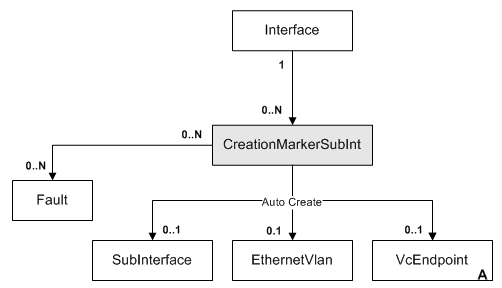
Description of "Figure 3-46 CreationMarkerSubInt Object Diagram"
Table 3-100 describes the attributes for the CreationMarkerSubInt object.
Table 3-100 CreationMarkerSubInt Object Attributes
| Attribute Name | Type | Default | Access | Explanation |
|---|---|---|---|---|
|
Name |
String |
[no default] |
RC |
Name |
|
SubInterfaceNumber |
U32 |
0 |
RW |
SubInterface number to be created. |
|
Encapsulation |
Enum |
AtmAal5 |
RC |
Encapsulation of the PVC created: 1 = AtmAal5 2 = AtmCell 3 = Frame 4 = Vlan |
|
CreationState |
Enum |
Inactive |
RO |
State of the SubInterface and PVC creation. This is comparable to the state of a concrete object. 0 = Inactive 1 = Active 2 = Installed 3 = Failed |
|
Conflict |
Boolean |
False |
RO |
Indicates whether this object is in conflict with another policy element. |
CreationMarkerVcFr Object
A CreationMarkerVcFr object represents a Frame Relay VC endpoint, which is created directly under the interface. This can only be applied to some devices, depending on their capabilities.
The CreationMarkerVcFr object has the following object inheritance:
SubInterface.CreationMarkerVcFr.Object
Figure 3-47 shows the CreationMarkerVcFr object diagram.
Figure 3-47 CreationMarkerVcFr Object Diagram
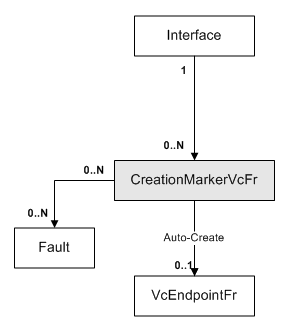
Description of "Figure 3-47 CreationMarkerVcFr Object Diagram"
Table 3-101 describes the attributes for the CreationMarkerVcFr object.
Table 3-101 CreationMarkerVcFr Object Attributes
| Attribute Name | Type | Default | Access | Explanation |
|---|---|---|---|---|
|
Name |
String |
“" |
RC |
Simple accessory to this object. |
|
CreationState |
Enum |
Inactive |
RO |
State of the SubInterface and PVC creation. This is comparable to the state of a concrete object. 0 = Inactive 1 = Active 2 = Installed 3 = Failed |
|
Conflict |
Boolean |
False |
RO |
Indicates whether this object is in conflict with another policy element. |
SubLayer Object
A SubLayer object represents one protocol sublayer of an interface, as returned by the device during the discovery process. This is especially used for AAL5 sublayers on ATM interfaces.
Figure 3-48 shows the SubLayer object diagram.
Table 3-102 describes the attributes for the SubLayer object.
Table 3-102 SubLayer Object Attributes
| Attribute Name | Type | Default | Access | Explanation |
|---|---|---|---|---|
|
Name |
String |
[no default] |
RO |
Name of sublayer (SNMP ifDescr). |
|
Number |
U32 |
0 |
RO |
Number of sublayer (SNMP ifIndex). |
|
Speed |
U32 |
0 |
RO |
Speed of the sublayer in Kbits/s (SNMP ifSpeed parameter). |
|
Type |
U32 |
0 |
RO |
Type of layer (ifType). This follows the IA[no default] ifType numbering. |
VlanInterface Object
A VlanInterface object represents a VLAN interface. One object is created for each VLAN present on a device when the device is discovered. All relevant interfaces, sub-interfaces and segments are linked to it. Note that although the object can have a Role, you cannot apply any policy element to it.
The VlandInterface object has the following object inheritance:
VlanInterface.Object
Figure 3-49 shows the VlanInterface object diagram.
Table 3-103 describes the attributes for the VlanInterface object.
Table 3-103 VlanInterface Object Attributes
| Attribute Name | Type | Default | Access | Explanation |
|---|---|---|---|---|
|
Name |
String |
"" |
RC |
Name of VLAN interface. |
|
Description |
String |
"" |
RC |
SNMP ifDescription. |
|
Number |
U32 |
0 |
RC |
Number of interface (SNMP ifIndex). |
|
Type |
U32 |
1 |
RC |
SNMP ifType. |
|
IpAddr |
IPAddress |
0.0.0.0 |
RC |
IP Address of the VLAN interface. |
|
SubnetMask |
IPAddress |
0.0.0.0 |
RC |
Subnet mask. |
|
PhysicalAddress |
String |
"" |
RC |
Physical address of the interface (the MAC address). |
|
Speed |
U32 |
0 |
RC |
Speed of the interface in Kbits/s (SNMP ifSpeed parameter). |
|
VLANId |
U32 |
0 |
RC |
Vlan Number. Range: 0–4096 |
VcEndpoint Objects
This section describes the VcEndpoint objects.
VcEndpoint Object (Abstract)
The VcEndpoint abstract object maintains attributes common to all virtual circuit endpoints.
The abstract VcEndpoint object has the following object inheritance:
VcEndpoint.Object
Figure 3-50 shows the VcEndpoint object diagram.
Table 3-104 describes the attributes for the VcEndpoint object.
Table 3-104 VcEndpoint Object Attributes
| Attribute Name | Type | Default | Access | Explanation |
|---|---|---|---|---|
|
Name |
String |
"" |
RC |
Name of VC endpoint. For ATM constructed from VPI and VCI. For Frame Relay constructed from DCLI. |
|
Context |
String |
"" |
RW |
Local context for driver scripts applied to VC endpoints (max 512 bytes). |
|
EffectiveCommandDeliveryMode (This value is inherited when the command delivery mode is set at the Device, parent Interface, or parent SubInterface level.) |
Enum |
0 |
RO |
0 = Online: commands delivered to device 1 = OfflineMaintenance: commands not delivered, concretes and other states updated 2 = OfflineTest: commands not delivered. |
VcEndpointFr Object
VcEndpointFr objects represent Frame Relay virtual circuit endpoints.
The VcEndpointFr object has the following object inheritance:
VcEndpointFr.VcEndpoint.Object
See Figure 3-50 for the VcEndpointFr object diagram.
Table 3-105 describes the attributes for the VcEndpointFr object.
Table 3-105 VcEndpointFr Object Attributes
| Attribute Name | Type | Default | Access | Explanation |
|---|---|---|---|---|
|
DLCI |
U32 |
18 |
RC |
Data Link Connection Identifier. |
|
CircuitState |
Enum |
Inactive |
RCW |
State of the circuit: 1 = Invalid 2 = Active 3 = Inactive |
|
CircuitType |
Enum |
PVC |
RCW |
Type of circuit: 0 = Unknown (Should never happen) 1 = PVC 2 = SVC (IP Service Activator only configures PVCs) |
|
Context |
String |
"" |
RCW |
Local context for driver scripts applied to VC endpoints (max 512 bytes). |
|
EffectiveCommandDeliveryMode (This value is inherited when the command delivery mode is set at the Device, parent Interface, or parent SubInterface level.) |
U32 |
0 |
RCW |
0 = Online: commands delivered to device 1 = OfflineMaintenance: commands not delivered, concretes and other states updated 2 = OfflineTest: commands not delivered. |
|
Name |
String |
"DLCI: 18" |
RC |
Name of VcEndpointFr object. |
|
ID |
U32 |
11902 |
RO |
VcEndpointAtm Object
VcEndpointAtm objects represent Asynchronous Transfer Mode (ATM) virtual circuit endpoints.
The VcEndpointAtm object has the following object inheritance:
VcEndpointAtm.VcEndpoint.Object
See Figure 3-50 for the VcEndpointAtm object diagram.
Table 3-106 describes the attributes for the VcEndpointAtm object.
Table 3-106 VcEndpointAtm Object Attributes
| Attribute Name | Type | Default | Access | Explanation |
|---|---|---|---|---|
|
Vpi |
U32 |
0 |
RC |
Virtual Path Identifier. |
|
Vci |
U32 |
0 |
RC |
Virtual Channel Identifier. |
|
AdminStatus |
Enum |
3 |
RC |
Desired administrative status of VC: 0 = Invalid (Should never happen) 1 = Up 2 = Down 3 = Unknown |
|
OperStatus |
Enum |
3 |
RC |
Current operational status of VC: 0 = Invalid (Should never happen) 1 = Up 2 = Down 3 = Unknown |
EthernetVlan Object
An EthernetVlan object represents a virtual circuit endpoint on an Ethernet virtual local area network (VLAN).
The EthernetVlan object has the following object inheritance:
EthernetVlan.VcEndpoint.Object
See Figure 3-50 for the EthernetVlan object diagram.
Table 3-107 describes the attributes for the EthernetVlan object.
Table 3-107 EthernetVlan Object Attributes
| Attribute Name | Type | Default | Access | Explanation |
|---|---|---|---|---|
|
VlanId |
U32 |
0 |
RC |
Vlan Number. Range: 1–4096 |
|
State |
Enum |
4 = Unknown |
RC |
0 = Down 1 = Up 2 = Testing 3 = Shutdown 4 = Unknown 5 = Dormant 6 = NotPresent 7 = LowerLayerDown 8 = NotFound 9 = NotYetDiscovered |
|
Context |
String |
"" |
RCW |
Local context for driver scripts applied to VC endpoints (max 512 bytes). |
|
EffectiveCommandDeliveryMode (This value is inherited when the command delivery mode is set at the Device, parent Interface, or parent SubInterface level.) |
U32 |
0 |
RCW |
0 = Online: commands delivered to device 1 = OfflineMaintenance: commands not delivered, concretes and other states updated 2 = OfflineTest: commands not delivered. |
|
Name |
String |
VLAN: 25 |
RC |
Name of EthernetVlan object. For EthernetVlan constructed from VPI and VCI. |
|
ID |
U32 |
11854 |
RO |
Segment Object
For each interface which is not a point-to-point connection there will be one segment object representing the locally connected network segment.
The Segment object has the following object inheritance:
Segment.Object
Figure 3-51 shows the Segment object diagram.
Table 3-108 describes the attributes for the Segment object.
Table 3-108 Segment Object Attributes
| Attribute Name | Type | Default | Access | Explanation |
|---|---|---|---|---|
|
Name |
String |
"" |
RO |
Name of segment. |
|
SubnetAddr |
IPAddress |
0.0.0.0 |
RC |
Subnet address. |
|
SubnetMask |
IPAddress |
0.0.0.0 |
RC |
Subnet mask. |
|
Community |
String |
"" |
RC |
SNMP Read Community string used when running autodiscovery on this segment. |
|
SnmpRetries |
U32 |
2 |
RCW |
The number of retry attempts when sending a PDU (Protocol Data Unit), Range: 0–20 |
|
SnmpTimeout |
U32 |
3 |
RCW |
Timeout of PDU response. Range: 1–30 seconds |
|
Type |
Enum |
0 |
RC |
Type of network segment: 0 = Unknown 1 = Other 2 = Serial 3 = BusSegment 4 = StarSegment 5 = TokenRing 6 = FddiRing 7 = AtmCloud 8 = FrCloud |
|
Discovered |
Boolean |
"" |
RCW |
True for segments created during discovery. False for segments created by the user, such as those linking a Virtual CE interface to the appropriate PE interface. |
|
MaxRepetitions |
U32 |
100 |
RW |
Specifies the maximum number of rows that will fetch from a network resource in a single request when SNMPv2 discovery is used. The default value of this field is 100. Permitted range for this filed is 1 to 100. Decrease the value of Max-Repetitions if the routers don't respond to the default value of 100. |
The System Model
This section describes the system model.
System Object
The System object represents the system root of the EOM. This object exists above all system objects.
The System object has the following object inheritance:
System.Object
Table 3-109 describes the attributes for the System object.
Table 3-109 System Object Attributes
| Attribute Name | Type | Default | Access | Explanation |
|---|---|---|---|---|
|
Name |
String |
"System" |
RO |
Always "System". |
|
ProxyPushState |
Enum |
0 |
RO |
The current state of the push to the proxy agents (not the state of the proxy): 0 = Ready 1 = Push 2 = Pushing 3 = Invalid |
|
ProxyPushProgress |
U32 |
100 |
RO |
When a proxy push is in progress, shows the percentage of the push that is complete. |
Options Object
The Options object represents system-wide global options.
The Options object has the following object inheritance:
Options.Object
Figure 3-53 shows the Options object diagram.
Table 3-110 describes the attributes for the Options object.
Table 3-110 Options Object Attributes
| Attribute Name | Type | Default | Access | Explanation |
|---|---|---|---|---|
|
Name |
String |
"Options" |
RO |
Always "Options". |
|
MajorVersion |
U32 |
3 |
RO |
Object Model Major version. |
|
MinorVersion |
U32 |
0 |
RO |
Object Model Minor version. |
|
ProxyAssign |
Enum |
1 |
RW |
Global option defining the strategy for assigning devices to Proxy Agents automatically: 0 = Off 1 = AssignFirst 2 = LoadBalance |
|
Revision |
U32 |
0 |
RO |
Object Model Revision Version |
|
UnmanagedAction |
Enum |
1 |
RW |
Default behavior to apply when unmanaging a device, unless overridden at device level: 0 = RemoveConfiguration 1 = LeaveConfiguration |
|
TransactionLimit |
U32 |
200 |
RO |
Number of applied transactions to keep. |
TransactionEntry Object
A TransactionEntry object represents each queued transaction, allowing the user to see a list of these transactions and to execute or roll back a transaction.
The TransactionEntry object has the following object inheritance:
TransactionEntry.Object
A TransactionEntry object can be created with the commit command, and manipulated with the schedule, rollback and merge commands.
Figure 3-54 shows the TransactionEntry object diagram.
Figure 3-54 TransactionEntry Object Diagram

Description of "Figure 3-54 TransactionEntry Object Diagram"
Table 3-111 describes the attributes for the TransactionEntry object.
Table 3-111 TransactionEntry Object Attributes
| Attribute | Type | Default | Access | Explanation |
|---|---|---|---|---|
|
Name |
String |
[no default] |
RW |
Unique name for transaction. |
|
Description |
String |
[no default] |
RW |
Description of transaction entered by user, entered as a summary to describe the transaction. |
|
Username |
String |
Name of user logged in |
RO |
Username of the user that created this transaction. Left empty if applicable to stored automatically-generated system transactions. |
|
RollbackOnFailure |
Boolean |
True |
RC |
True unmerges (rolls back) the transaction if it fails. False does not roll back the transaction. |
|
ReasonForFailure |
String |
[no default] |
RW |
This attribute contains the messages from any faults raised for this transaction if the transaction monitor is running. |
|
State |
Enum |
0 |
RC |
Status of this object: 0 = Pending 1 = Installed 2 = Uninstalled 3 = Scheduled 4 = ScheduledUninstall 5 = FailedScheduled 6 = FailedScheduleUninstall 7 = Committed 8 = ScheduleCommitted 9 = SucceededScheduleUninstall |
|
ProvisioningStatus |
Enum |
[no default] |
RW |
Provisioning status of this object: 0 = Pending: initial state on commit of the transaction. 1 = Succeeded: all concretes are in the Installed state or deleted. 2 = Failed: at least one concrete is in Rejected state, or the transaction timed out and the transaction monitor is configured to fail transactions on timeout. 3 = Timedout: the maximum time a transaction is allowed to stay in pending state awaiting completion notifications was exceeded. More details on these states are provided in IP Service Activator System Administrator's Guide. |
|
Schedule |
DateTime |
Now |
RW |
Date and Time to schedule this transaction for or when transaction was changed to current static state. |
|
Operations |
String |
[no default] |
RC |
The data appearing below the data operations field is a deserialized representation of objects stored in a string type within the TransactionEntry object. The fields available for viewing represent the following: CID = ID of the concrete operated on Status = Inactive, Pending, Succeeded, Failed, or Timedout Operation = Type of operation (Create, Delete or Link) PClass = Parent class PName = Parent name ParentID = ID of the parent object for the operation |
|
NumberofConcretes |
U32 |
[no default] |
R |
The number of concretes for the transaction. |
Component Object
A Component object represents an IP Service Activator component: Component Manager, Policy Server, Event Handler, OIM, Proxy Agent, Device Driver, System Logger or Integration Component. The Type attribute identifies the type of component; individual components are not accessible via the EOM.
The Component object has the following object inheritance:
Component.Object
Figure 3-55 shows the Component object diagram.
Table 3-112 describes the attributes for the Component object.
Table 3-112 Component Object Attributes
| Attribute Name | Type | Default | Access | Explanation |
|---|---|---|---|---|
|
Name |
String |
[no default] |
RO |
Name of component. |
|
Remarks |
String |
[no default] |
RO |
Optional additional comments. Limit of 255 characters. |
|
CorbaName |
String |
Auto |
RO |
CORBA name of component. |
|
CorbaKind |
String |
Auto |
RO |
CORBA type of component. |
|
CorbaLocation |
String |
Auto |
RO |
CORBA location of component. |
|
CorbaMajor |
U32 |
0 |
RO |
Current version of the CORBA interface - major number. |
|
CorbaMinor |
U32 |
0 |
RO |
Current version of the CORBA interface - minor number. |
|
RunState |
Enum |
0 |
RO |
Allows triggering shutdown of components on a single host. Can be one of: 0-2 = running 3-5 = shutdown |
|
StartTime |
U32 |
[no default] |
RO |
Time since this component started, in seconds. |
|
Restarts |
U32 |
0 |
RO |
The number of times this component has been restarted. |
|
Type |
String |
[no default] |
RO |
Identifies type of component; one of: "ComMan" "PolicyServer" "ProxyAgent" "Driver" "SysLog" "ServiceComponent" "OssIntegrationManager" "EventHandler" "IntegrationComponent" |
|
UpTime |
String |
0 |
RO |
Elapsed time since the component started, specifying days, hours, minutes and seconds. |
|
IsNetworkProcessor |
Boolean |
False |
RO |
Indicates if the proxy is a Network Processor or a regular proxy agent. |
|
Id |
U32 |
[no default] |
RO |
Unique ID used to reference this object. |
|
Full Version |
String |
[no default] |
RO |
The FullVersion attribute contains the values for the MajorVersion, MinorVersion, ServicePack and BuildNo. |
EventSubscription Object
An Event Subscription represents the definition of an external system subscribing to events and faults reported by IP Service Activator. The subscription defines the delivery type, such as by using an SNMP trap, CORBA interface, and so on.
The EventSubscription object has the following object inheritance:
EventSubscription.Object
Figure 3-56 shows the EventSubscription object diagram.
Figure 3-56 EventSubscription Object Diagram
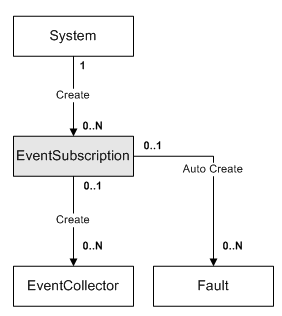
Description of "Figure 3-56 EventSubscription Object Diagram"
Table 3-113 describes the attributes for the EventSubscription object.
Table 3-113 EventSubscription Object Attributes
| Attribute Name | Type | Default | Access | Explanation |
|---|---|---|---|---|
|
Name |
String |
"InfoVista" |
RCW |
Name of subscription. |
|
Description |
String |
[no default] |
RCW |
A longer description. |
|
Enable |
Boolean |
True |
RCW |
True = subscription enabled. False = subscription disabled. |
|
SendPendingEvents |
Boolean |
False |
RCW |
True = currently pending events are to be delivered. False = pending events are not delivered. |
|
DeliveryType |
U32 |
4 |
RCW |
Delivery method: 0=SnmpTrap 1=UpgradedSnmpTrap 2=Netcool 3=CorbaChannel 4=DatabaseOnly |
|
DeliveryDetails |
String |
[no default] |
RCW |
String formatted according to type. For SNMP, this is a comma-separated list of IP address, port and version, for example, "192.168.1.2,42,2". For CORBA, this is the name of the service. For DatabaseOnly, this is blank. |
|
ImpactTargets |
U32 |
0 |
RCW |
Bitwise value, 1 bit per impact target: Bit 0 = Customer, Site, VPN Bit 1 = Device Bit 2 = Interface |
|
HighestSeverity |
Boolean |
False |
RCW |
True = delivers highest severity faults only. False = all faults delivered. |
|
TransactionEvents |
U32 |
0 |
RCW |
Identifies transaction start/end events to be reported: 0 = None 1 = User 2 = System 3 = All |
EventCollector object
Event Collector objects are linked to other objects in the EOM to specify that the object is to be monitored.
The EventCollector object has the following object inheritance:
Subscription.Object
To set the collection point to a particular object then you should link the object to the EventCollector. If the collection point is the Root object, then no object should be linked, but the RootCollection attribute should be set to True. If the collection point is the Policy or System objects, then no object should be linked, but the CollectionPoint attribute should be set to 1 or 2 respectively.
Figure 3-57 shows the EventCollector object diagram.
Table 3-114 describes the attributes for the EventCollector object.
Table 3-114 EventCollector Object Attributes
| Attribute Name | Type | Default | Access | Explanation |
|---|---|---|---|---|
|
Name |
String |
[no default] |
RW |
Name of collector, must be unique. |
|
Description |
String |
[no default] |
RW |
Remarks. |
|
CollectEvents |
Boolean |
True |
RW |
True = events are collected. False = events are not collected. |
|
CollectionPoint |
U32 |
0 |
RW |
Used if the collection point is the Policy (1) or System (2), as these objects cannot be linked directly. |
|
RootCollection |
Boolean |
False |
RW |
True = Area of interest is the entire object model. False = Area of interest is defined by CollectionPoint. |
|
HierarchicalCollection |
Boolean |
True |
RW |
True = collection is expanded below the local scope from the CollectionPoint. False = collection affects CollectionPoint only. |
|
Type |
Enum |
1 |
RW |
Specifies the relevant Event Type: 0 = CreateAndDelete 1 = Fault 2 = AttributeChange 3 = StateChange 4 = Link/Unlink |
|
Classname |
String |
[no default] |
RW |
Name of class being subscribed to. Must be a valid class name. Blank if subscription relates to a specific object. |
EventFilter Objects
This section describes the EventFilter objects.
EventFilter Object (Abstract)
The EventFilter object is used by the Event Collector to determine which events are to be generated. It operates on event specific details such as the attribute that has changed on an object described in the event, or the fault ID raised.
The abstract EventFilter object has the following object inheritance:
EventFilter.Object
Figure 3-58 shows the EventFilter object diagram.
Table 3-115 describes the attributes for the EventFilter object.
Table 3-115 EventFilter Object Attributes
| Attribute Name | Type | Default | Access | Explanation |
|---|---|---|---|---|
|
Name |
String |
[no default] |
R |
Name of event filter |
|
Permit |
Boolean |
True |
RCW |
False=Deny matching events. True=Permit matching events. |
|
Priority |
U32 |
0 |
RCW |
Ordering of filter. |
EventFilterAttributeChange object
The EventFilterAttributeChange object performs a match between an attribute name and the changes on an object to decide whether the event should be generated. The name corresponds to the type of filter.
The EventFilterAttributeChange object has the following object inheritance:
EventFilterAttributeChange.EventFilter.Object
See Figure 3-58 for the EventFilterAttributeChange object diagram.
Table 3-116 describes the attribute for the EventFilterAttributeChange object.
Table 3-116 EventFilterAttributeChange Object Attributes
| Attribute Name | Type | Default | Access | Explanation |
|---|---|---|---|---|
|
AttributeName |
String |
[no default] |
RCW |
String to match against attribute name. |
EventFilterFaultMask Object
The EventFilterFaultMask object performs a match between a triggered event and details of the faults to be reported. The name corresponds to the type of filter.
The EventFilterFaultMask object has the following object inheritance:
EventFilterFaultMask.EventFilter.Object
See Figure 3-58 for the EventFilterFaultMask object diagram.
Table 3-117 describes the attributes for the EventFilterFaultMask object.
Table 3-117 EventFilterFaultMask Object Attributes
| Attribute Name | Type | Default | Access | Explanation |
|---|---|---|---|---|
|
FaultCode |
U32 |
0 |
RCW |
Fault code; only used if FaultCategory is set to SingleFaultCode. |
|
FaultCategory |
U32 |
0 |
RCW |
Category of faults to be filtered: 0=SingleFaultCode 1=ComponentFaultClears 2=DatabaseAccessFaultClears 3=ProvisioningFaultClears 4=PolicyRuleFaultClears 5=CommunicationFaultClears 6=DeviceOrInterfaceFaultClears 7=UpgradedComponentFaults 8=UpgradedDatabaseAccessFaults 9=UpgradedPolicyOrServiceFaults 10=UpgradedDeviceFaults 11=UpgradedInterfaceFaults 12=UpgradedLinkFaults 13=UpgradedSystemFaults 14=UpgradedConfigurationFaults |
ExternalSystem Object
The ExternalSystem object represents an external system, and can be linked to a component of type IntegrationComponent.
Figure 3-59 shows the ExternalSystem object diagram.
Table 3-118 describes the attributes for the ExternalSystem object.
Table 3-118 ExternalSystem Object Attributes
| Attribute Name | Type | Default | Access | Explanation |
|---|---|---|---|---|
|
Name |
String |
[no default] |
RW |
Name of the specific instance of external system. |
|
Remarks |
String |
[no default] |
RW |
Optional additional comments. Limit of 255 characters. |
|
Type |
String |
[no default] |
RW |
Type of external system. |
|
IpAddr1 |
IPAddress |
0.0.0.0 |
RW |
Primary IP address of external system. |
|
IpAddr2 |
IPAddress |
0.0.0.0 |
RW |
Secondary IP address of external system. |
|
Port1 |
U32 |
0 |
RW |
Primary Port number. |
|
Port2 |
U32 |
0 |
RW |
Secondary Port number. |
|
UserName |
String |
[no default] |
WO |
User login name (encrypted). |
|
Password |
String |
[no default] |
WO |
User password (encrypted). |
|
URL |
String |
[no default] |
RW |
URL on which to contact external system. |
Fault Object
A Fault object represents a system message indicating a fault reported from an IP Service Activator component or a network object. Fault objects exist while a component has an outstanding fault. When the fault is fixed the fault object is automatically removed. A fault object is linked to the object representing the component that currently has a fault.
The Fault object has the following object inheritance:
Fault.Object
Figure 3-60 shows the Fault object diagram.
Table 3-119 describe the attributes for the Fault object.
Table 3-119 Fault Object Attributes
| Attribute Name | Type | Default | Access | Explanation |
|---|---|---|---|---|
|
Name |
String |
[no default] |
RO |
Name of the fault. |
|
TimeStamp |
DateTime |
Now |
RC |
Time of fault creation. |
|
MajorCode |
U32 |
0 |
RC |
Major error code (this is 100 for faults raised by IP Service Activator). |
|
MinorCode |
U32 |
0 |
RC |
Minor error code. |
|
Severity |
Enum |
0 |
RC |
The severity level of the fault. One of the following: 0 = Info 1 = Notice 2 = Warning 3 = Error 4 = Critical |
|
Error |
String |
[no default] |
RO |
Description text with parameter place holders. |
SnmpProfile object
An SnmpProfile object represents a user-defined profile of SNMP attributes that can be assigned to manage the discovery of a group of devices, or to the re-discovery of individual devices.
The SnmpProfile object has the following object inheritance:
SnmpProfile.Object
Figure 3-61 shows the SnmpProfile object diagram.
Table 3-120 describes the attributes for the SnmpProfile object.
Table 3-120 SnmpProfile Object Attributes
| Attribute Name | Type | Default | Access | Explanation |
|---|---|---|---|---|
|
Name |
String |
[no default] |
RW |
Name given to this SNMP Profile. |
|
Description |
String |
[no default] |
RW |
Text field describing this SNMP Profile. |
|
SnmpRetries |
U32 |
2 |
RW |
The number of retry attempts when sending a PDU (Protocol Data Unit). Range: 0 to 20 |
|
SnmpTimeout |
U32 |
3 |
RW |
Timeout of PDU response. Range: 1 to 30 seconds |
|
SnmpVn |
Enum |
3 |
RW |
Version of SNMP to use to interrogate the device: 0 = None 1 = SnmpV1 2 = SnmpV2c 3 = SnmpV1V2c 4 = SnmpV3 5 = SnmpV1V3 6 = SnmpV2cV3 7 = SnmpV1V2cV3 |
|
Community |
Secure |
public |
RW |
SNMP Community string used for Read access to network devices, when running autodiscovery. |
|
Userid |
Secure |
noAuthUser |
RCW |
UserID authorized to set authentication and privacy passwords. |
|
Authentication |
Enum |
None |
RW |
0 = None 1 = SHA 2 = MD5 |
|
AuthenticationPassword |
String |
[no default] |
RW |
Password length: 8 to 127 characters |
|
Privacy |
Enum |
None |
RW |
0 = None 1 = DES 2 = AES |
|
PrivacyPassword |
String |
[no default] |
RW |
Password length: 8 to 127 characters |
|
Id |
U32 |
541 |
RO |
Unique ID used to reference this object. |
|
MaxRepetitions |
U32 |
100 |
RW |
Specifies the maximum number of rows that will fetch from a network resource in a single request when SNMP V2c is used for discovery. Permitted range for this filed is 1 to 100. Decrease the value of Max-Repetitions if the routers do not respond to the default value of 100. |
SystemUserGroup Objects
This section describes the SystemUserGroup objects.
SystemUserGroup Object
The SystemUserGroup object is read only. The administrator must log into the GUI to create a system user group.
The SystemUserGroup object has the following object inheritance:
SystemUserGroup.Object
A system user group defines the access level that its members have within IP Service Activator. Every system user is a member of only one system user group. All users in the same system user group have the same access privileges.
A system user group can have one of the following access levels:
-
Super User: Users can access the user interface, view information and perform any operation. Only users with Super User access can set up other users and perform configuration tasks associated with the policy server.
-
Read Write: Users can access the user interface, view information, and create and/or modify objects. The operations that can be performed by group members depend on the permissions that are set for the group.
-
Read Only: Users can access the user interface and view objects but cannot create new or modify existing objects.
For system user groups with Read Write access, you can specify exactly which operations its members can perform. For example, you can specify that members cannot create new networks, but can discover new devices. These controls are referred to as permissions.
Figure 3-62 shows the SystemUserGroup object diagram.
Figure 3-62 SystemUserGroup Object Diagram
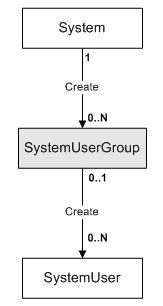
Description of "Figure 3-62 SystemUserGroup Object Diagram"
Table 3-121 describes the attributes for the SystemUserGroup object.
Table 3-121 SystemUserGroup Object Attributes
| Attribute Name | Type | Default | Access | Explanation |
|---|---|---|---|---|
|
AccessRights |
None = 0, SystemWrite = 1, SystemRead = 2, WorldWrite = 4, WorldRead = 8, ReadOnly = 8, ReadWrite = 8 + 4, SuperUser = 8 + 4 + 2 + 1 Only a Super user sees System objects. |
|||
|
Name |
String |
[no default] |
R |
Name of the user group. |
|
Id |
U32 |
0 |
R |
This is a unique ID used to reference this object. |
SystemUser Object
The SystemUser object is used to create new users and set security restrictions. System users are set up within a system user group. All users in the same system user group have the same access privileges. A user can be a member of only one group.
The SystemUser object has the following object inheritance:
SystemUser.SystemUserGroup.Object
Users with Super User access can set up new system users, specifying their user name and password details. It is possible to force users to change their passwords when they first log into IP Service Activator.
See Figure 3-62 for the SystemUser object diagram.
Table 3-122 describe the attributes for the SystemUser object.
Table 3-122 SystemUser Object Attributes
| Attribute Name | Type | Default | Access | Explanation |
|---|---|---|---|---|
|
Active |
U32 |
0 |
R |
This value indicates the number of concurrent sessions that the user is running. 0 indicates that the user is not currently logged on. |
|
Concurrent |
Boolean |
False |
RCW |
False prevents more than one concurrent logon by this user. |
|
Enabled |
Boolean |
True |
RCW |
False disables user logon. |
|
ExpireDate |
Date |
[date] |
R |
Password expiry date is calculated from the value entered for PasswordExpires. The default [date] is 30 days after the user is created. |
|
FailedLogins |
U32 |
0 |
R |
The number of failed logon attempts before the user is denied access (locked out). |
|
Name |
Secure |
none |
RCW |
Name of the user. |
|
Password |
String |
[no default] |
RCW |
User password string. |
|
PasswordExpires |
U32 |
30 |
RCW |
Number of days between password change and password expiry. A value of 0 means "password never expires". When login is blocked due to password expired, the user must log into the GUI and change the password. This will enable login to the OSS Integration Manager. |
|
Remarks |
String |
[no default] |
RCW |
Add any desired text. Limit of 255 characters. |
|
ResetPassword |
Boolean |
False |
RCW |
True requires the user to reset the password at initial logon. When this attribute is True (that is, when the password is expired), the user cannot log into the OSS Integration Manager. When login is blocked due to reset required by the system administrator, the user must log into the GUI and change the password. This will enable login to the OSS Integration Manager. |
|
Id |
U32 |
0 |
R |
A unique reference number for each object. |
